1945
ACCVI on hiatus until November due to WWII
Events:
Section members who attended the ACC general summer camp at the Eremite Valley July 15 – 28: Connie Bonner (graduated on Memorial Peak), Rex Gibson, Irene Bastow Hudson, Stephanie Bowes.
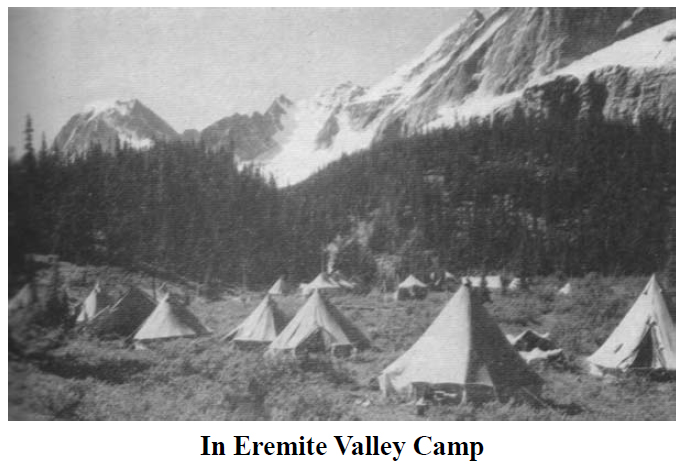
In Eremite Valley Camp

Irene Bastow Hudson, N.B. Sanson.

B.B. Gilman, N. Fraser, Stephanie Bowes, F. Parkes.
November – At a recent meeting it was unanimously decided that the ACCVI is forming a section again. Officers have not yet been elected.
Section members who attended the ACC general summer camp at the Eremite Valley July 15 – 28: Connie Bonner (Memorial Peak), Rex Gibson.
Section members who passed away in 1945: Arthur Wheeler.
Mount Becher
Reported in the Comox Argus Thursday January 4, 1945. p.5.
Skiing parties found their way to Mount Becher cabin during the holidays. They found that the rain had dissolved the snow and it was possible to drive to within sight of the Forbidden Plateau Lodge. It was clear weather above the 3,000-foot level and a wonderful panoramic view to the west could be obtained. The cabin was found clean and warm.
Alpine Club Head, A.O. Wheeler, Dies
Reported in The Victoria Daily Times Wednesday March 21, 1945, p.1.
Arthur Oliver Wheeler, 85, founder and first president of the Alpine Club of Canada, who made his home at Sidney, died Tuesday night at Banff, amid the mountains he loved and explored. Mr. Wheeler surveyed the boundary between Alberta and British Columbia, traveling along the watershed line of the main Rocky Mountain Range to do so. He founded the Alpine Club in 1906. From 1907 to 1928 he was editor-in-chief of the Canadian Alpine Journal.
PTE. G. Wood Dies in Action
Reported in the Comox Argus Thursday April 26, 1945. p.1.
CUMBERLAND May 3—Mr. and Mrs. William S. Wood, Cumberland, have been notified that their only son, Pte. Gordon Wood, 20, was killed in action against the enemy in Holand on April 21. He was a native son of Cumberland, born and educated in this city. Pte. Wood enlisted in Vancouver Island’s own Canadian Scottish Regiment in January 1941, directly after leaving high school. He had been overseas three years and saw action in the Normandy invasion of Nazi-held France. He was wounded at Caen and spent two months in hospital, later returning to the front and serving in Northern France, Belgium and Holland. His parents received a letter from the young soldier Wednesday night. It had been written on April 17, just four days before his death.
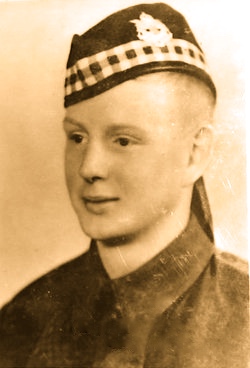
Gordon Scarth Wood
Postscript:
By Lindsay Elms
Adopted 2 November 1999, Gordon Wood Lake is at the head of Kweishun Creek just below Milla Lake on map 92F/11. Named by Ruth Masters to remember Canadian Army Corporal Gordon Scarth Wood, K76374, from Cumberland. Corporal Wood was 20 years old and serving with the Canadian Scottish Regiment when he was killed in action 21 April 1945; buried at Holten Canadian Military Cemetery in Holland. Plot 3, Row G, Grave 6. Earlier Wood had participated in the D-Day invasion at Normandy, was wounded at Caen and spent 2 months in hospital before returning to the front in northern France, then Belgium and later Holland. Corporal Wood was killed clearing land mines in newly-liberated western Holland.
Forbidden Plateau Open
Reported in the Comox Argus Thursday April 26, 1945. p.9.
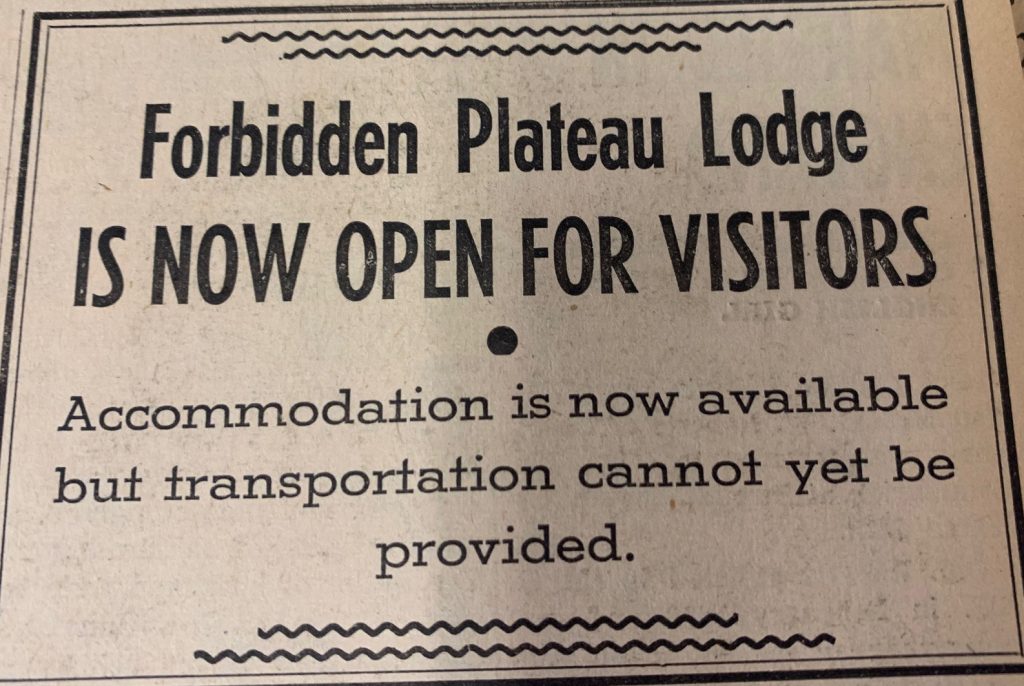
Black and white text ad for Forbidden Plateau Lodge.
Eugene Croteau
Reported in the Comox Argus Thursday May 10, 1945. p.2.
Mr. Eugene Croteau wishes us to point out that while the CPR, a private company who owns the land on the Plateau, has not actually deeded the site on which his camp [Croteau Lake] stands on the Forbidden Plateau, they have intimated that the Boy Scouts can use it as their camp in perpetuity.
Mountaineering Club
Reported in the Comox Argus Thursday May 17, 1945. p.2.
It was learnt at a meeting of the Comox District Mountaineering Club on Monday that the club had received a flat refusal from the owner of the land to cut trees so as to make a ski run above the Forbidden Plateau Lodge. The club will now approach Department of Lands and Mr. Welch and see if they can get any help from them. The report of the ski dance was considered satisfactory: a gross of $88 being raised. Basket picnics and hikes will be held throughout the summer. A float will be entered for the First of July celebration.
Ski Club for Qualicum Beach
Reported in the Comox Argus Thursday June 28, 1945. p.8.
QUALICUM BEACH, June 26—Sixteen hiking and skiing enthusiasts met in the municipal office on Friday [June 20] evening to consider the ways and means to further developing the Mount Cokely and Arrowsmith area as a skiing as well as alpine attraction. Those present were enthusiastic about the possibilities of the area for this purpose, especially when Mr. Henry Dougan reported that a resolution favoring the project, and which was presented at the annual meeting of the Affiliated Boards of Trade of Vancouver Island in Nanaimo on June 20th by delegates Messrs. P. Belyea, Henry Dougan and A. Higgs for the Qualicum Board of Trade, had been passed almost unanimously by that body. After much lively discussion it was unanimously decided that a club should be organized immediately to further the work improving existing trails and cabins, and sponsor the laying out of a ski run and jump. As a result, the Qualicum Alpine and Ski Club was formed with Mr. Henry Dougan elected as president and Mr. R. Thwaites as secretary-treasurer. It was pointed out that as the first two miles of the old trail [CPR trail] was in poor condition, the first steps taken by the new club should include the work necessary to put this part of the trail in shape, and volunteer groups are to be organized for this purpose under the able direction of Mr. Oscar Frederikson. The forestry Department will also be approached as to whether this, and other similar work planned, can be included in their trail improvement programme. And if the area can be incorporated as an extension of McMillan Park, as it is being sponsored by the Qualicum Board of Trade, it is hoped that existing logging roads can be improved and extended by the Parks Board so that access to the skiing area will be eventually possible by car. Much can be done meanwhile however, by the voluntary work groups that are to be organized, and it is hoped that all those interested will help to make the club a success.
Qualicum Beach Alpine Club
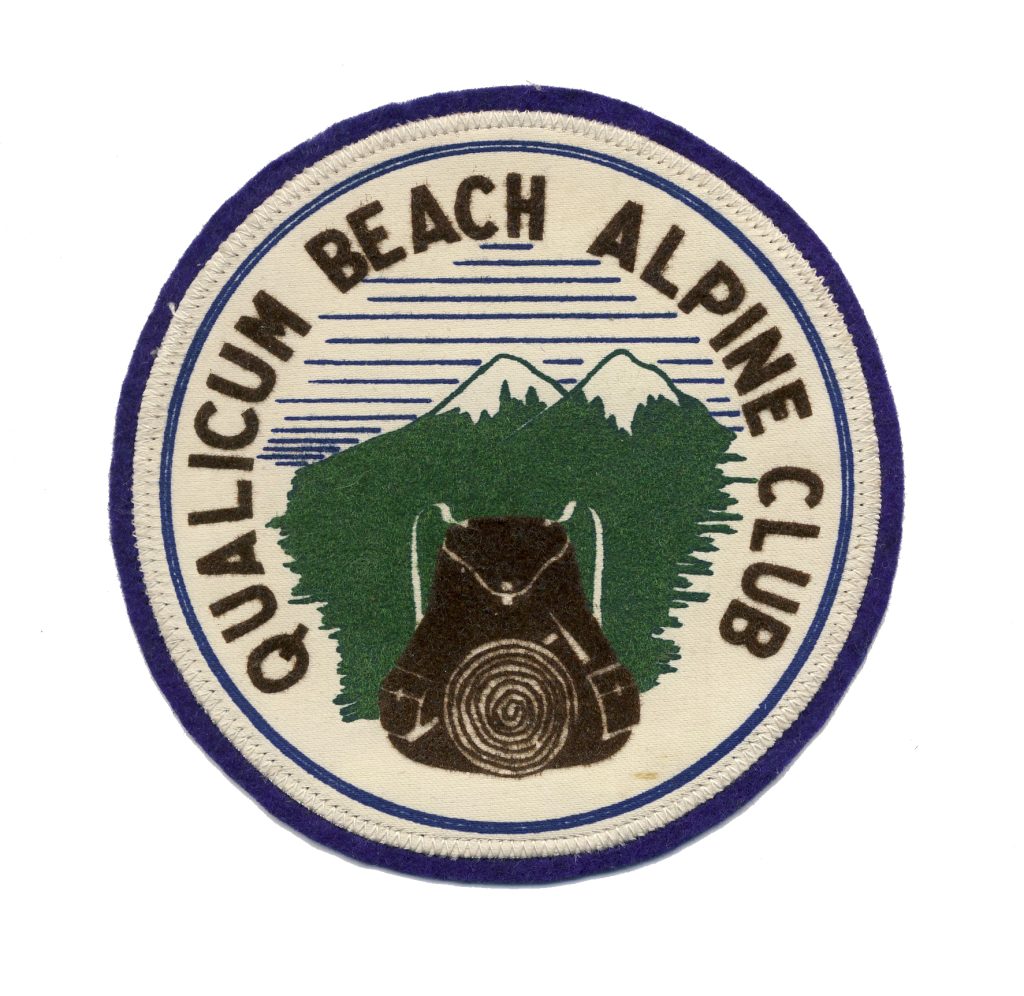
Qualicum Beach Alpine Club patch.
On June 20, 1945 Messrs. P. Belyea, Henry Dougan and A. Higgs for the Qualicum Board of Trade attended the annual meeting of the Affiliated Boards of Trade of Vancouver Island in Nanaimo. They met in the municipal office to discuss ways and means to further develop the Mount Cokely and Arrowsmith area as a skiing and alpine attraction. For many years the trail built by the CPR in 1912 had gradually fallen into disrepair and the crossing of McBey Creek could be difficult at certain times of the year. After much discussion the board suggested they become a registered club to further the work improving existing trails and cabins, and sponsor the laying out of a ski run and jump. As a result, the Qualicum Beach Alpine Club was formed with Mr. Henry Dougan elected as president and Mr. R. Thwaites as secretary-treasurer. The club applied for government funding and in 1946 and 1947 they received grants for $500. Harry Dougan and Roger Whitmee Jr, who were both in their teens, worked on the trail for the two summers. In 1948, Henry “Dick” Dougan (Harry’s father) contacted Muriel Aylard, the Secretary-Treasurer of the Vancouver Island Section of the Alpine Club of Canada to enquire about joining the ACC. At the ACC Summer Camp she passed the letter on to Syd Vallance, the President of the ACC. In Vallance’s response he wrote:
I was most interested to learn of your young club and shall be most interested to hear from time to time of its progress and activities, if you can conveniently let us know of them. We would like you to feel assured that any advice or guidance which we can give and which it is possible to give by correspondence is yours for the asking. We are bound by the constitution as to the age at which new members may be admitted to our Club, but in creating a love of the outdoors and of the Mountains in your young members you are doing a splendid work, and when they are old enough to join our own Club we shall give them a warm welcome. I know that they will find, as they perhaps have already found in your own Club, that their lives will be enriched by their associations and happiness which the Mountains bring them. I asked the Secretary to tell you just what should be necessary to form a section of our own Club, and doubtless he has done so. We have sections at present in Victoria, Vancouver, Edmonton, Calgary, Regina, Winnipeg, Montreal and New York. New Sections will shortly be formed in Portland Ore., and Ottawa. Even though you feel that the time is not ripe to form a Section we shall be most interested to hear of your expeditions and would love to help you in any way we can.
Henry “Dick” Dougan, after he moved to Courtenay from Scotland, became friends with Clinton Wood who operated the Forbidden Plateau Lodge below Mount Becher. In 1945, Dick’s son fourteen-year-old son Harry worked for the summer at the lodge as a wrangler assisting the Woods. Over the next few winters during the Christmas break and Easter weekends, Dick would drive Harry and his friends up to Forbidden Plateau Lodge to compete in races.


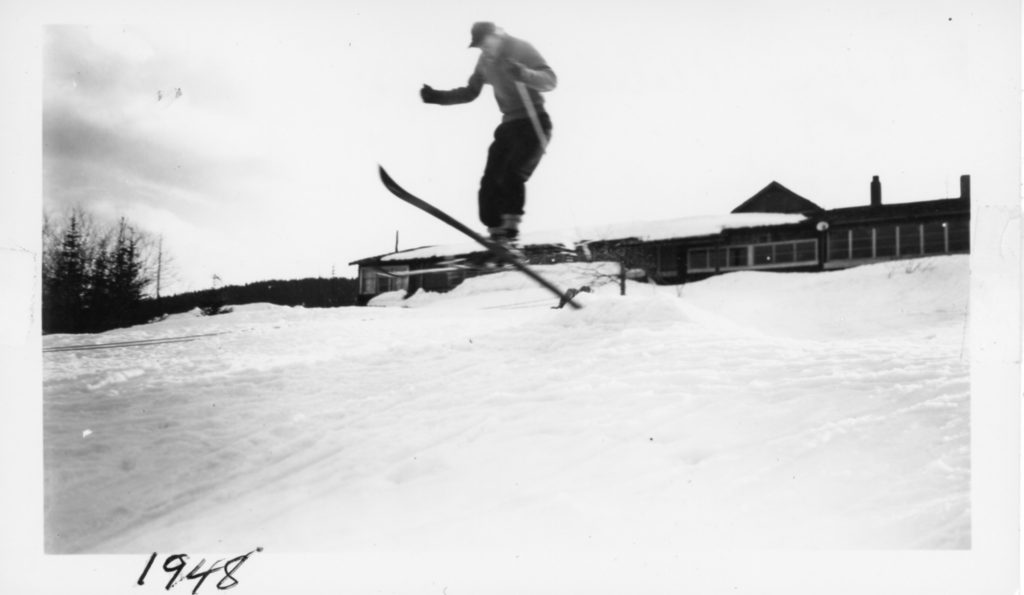
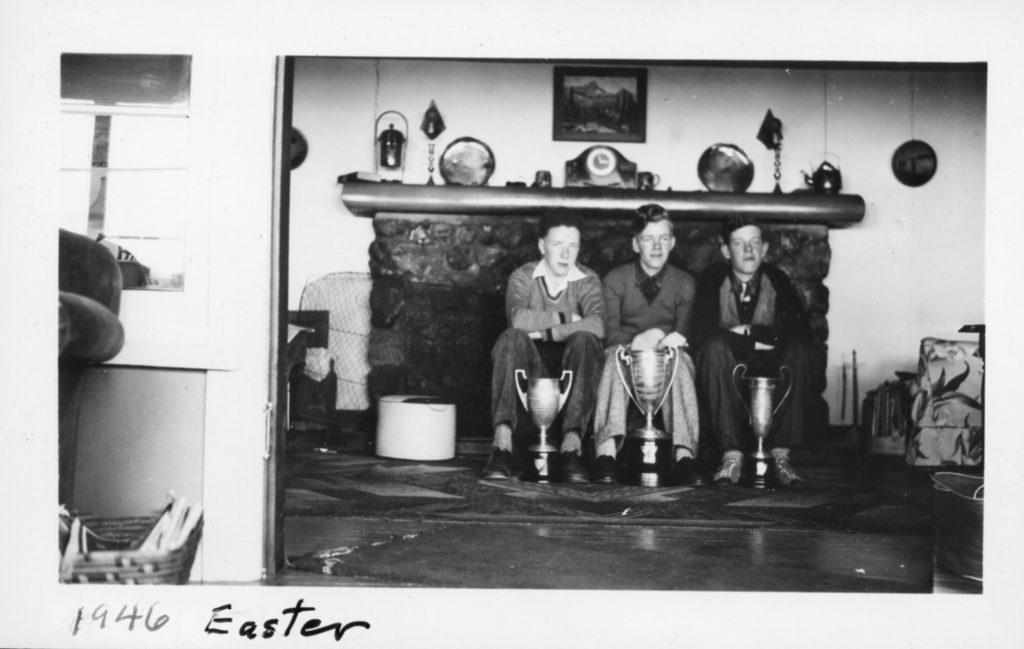
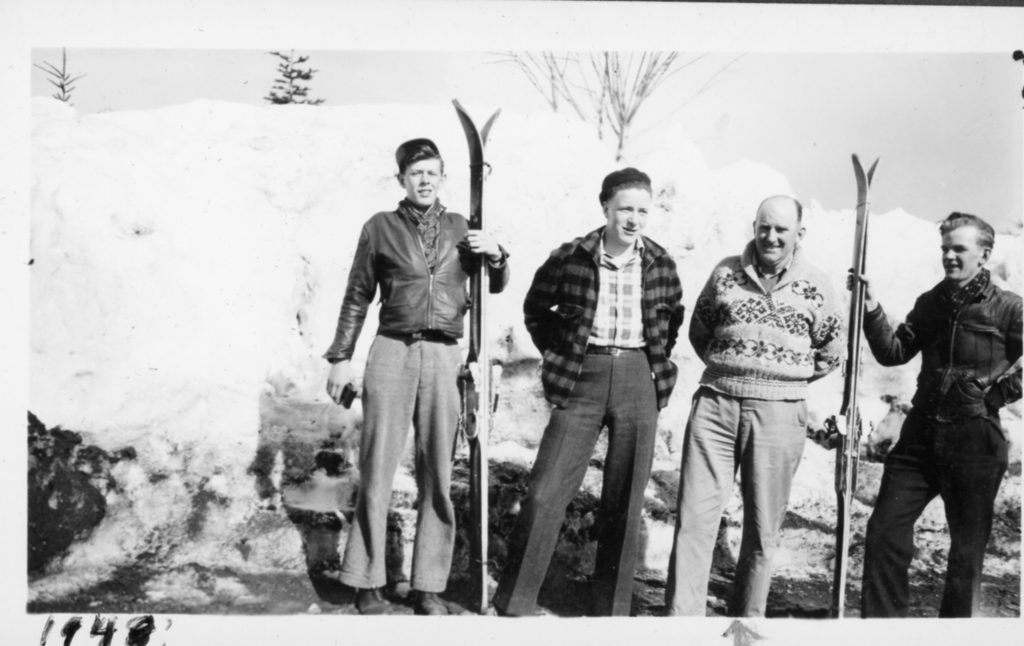
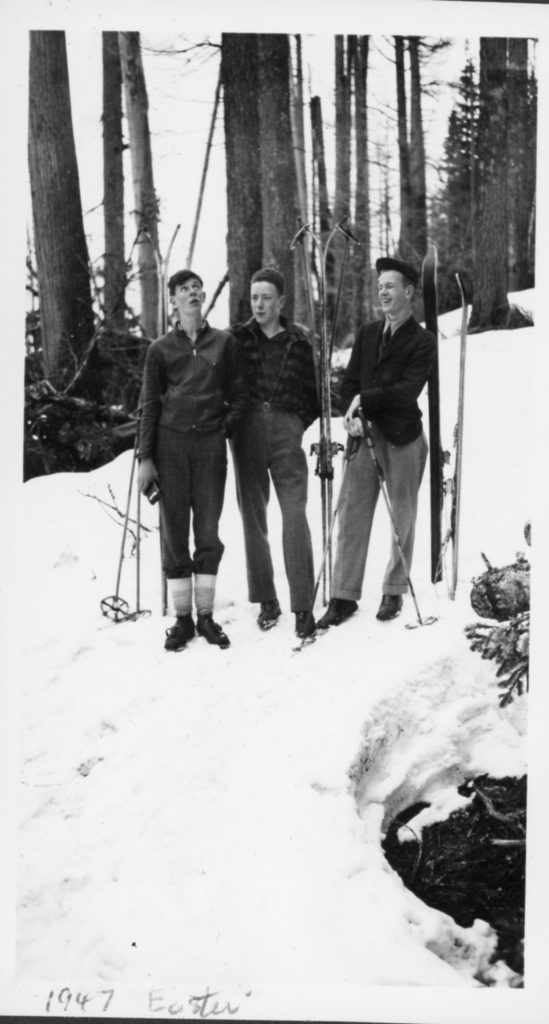
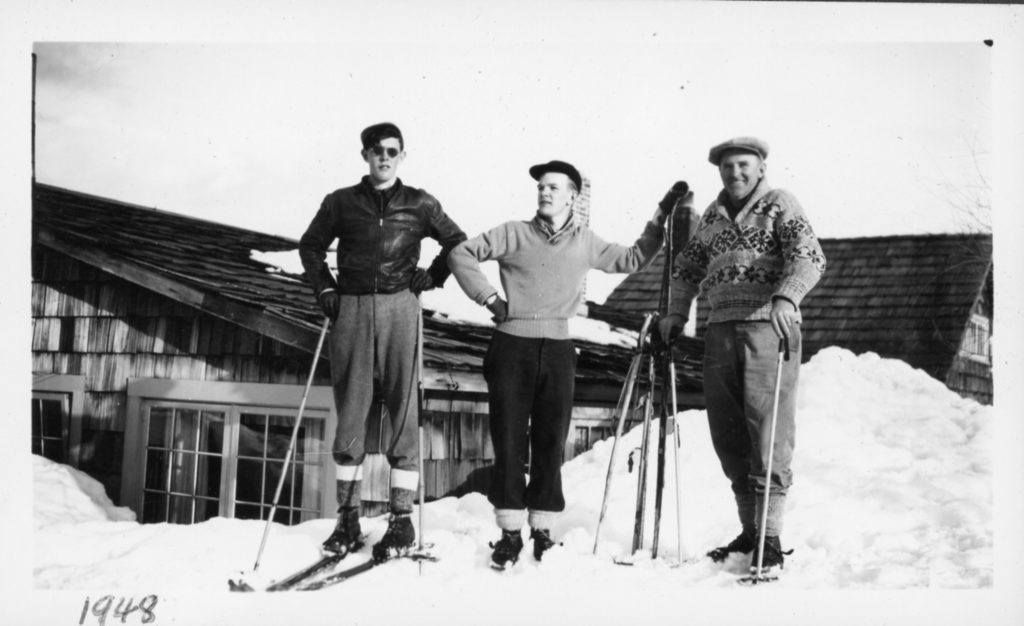
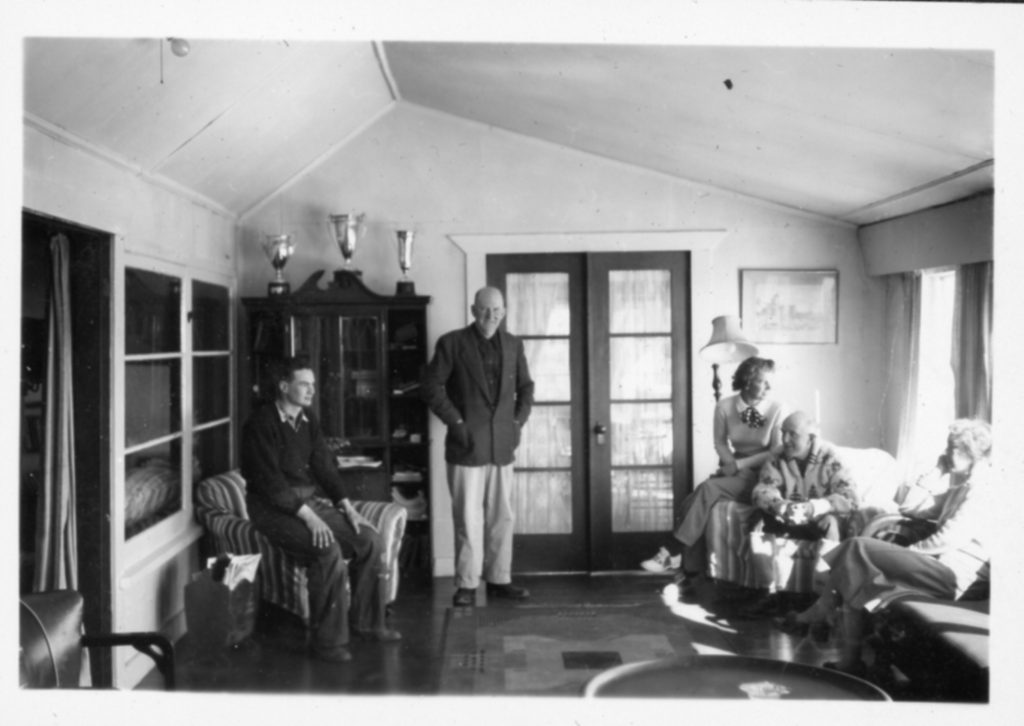
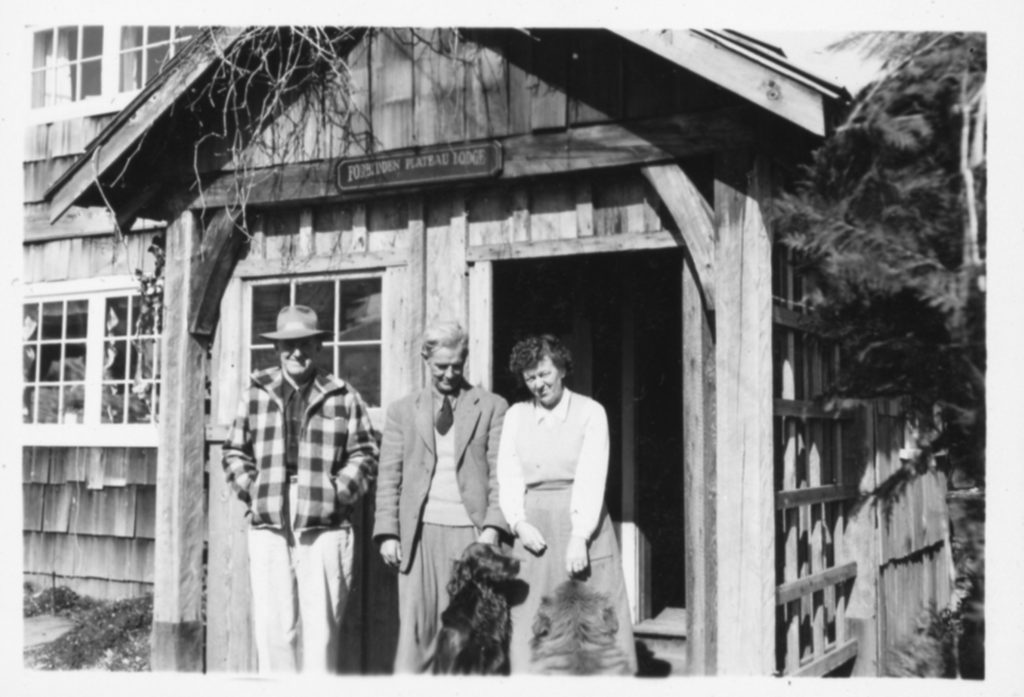
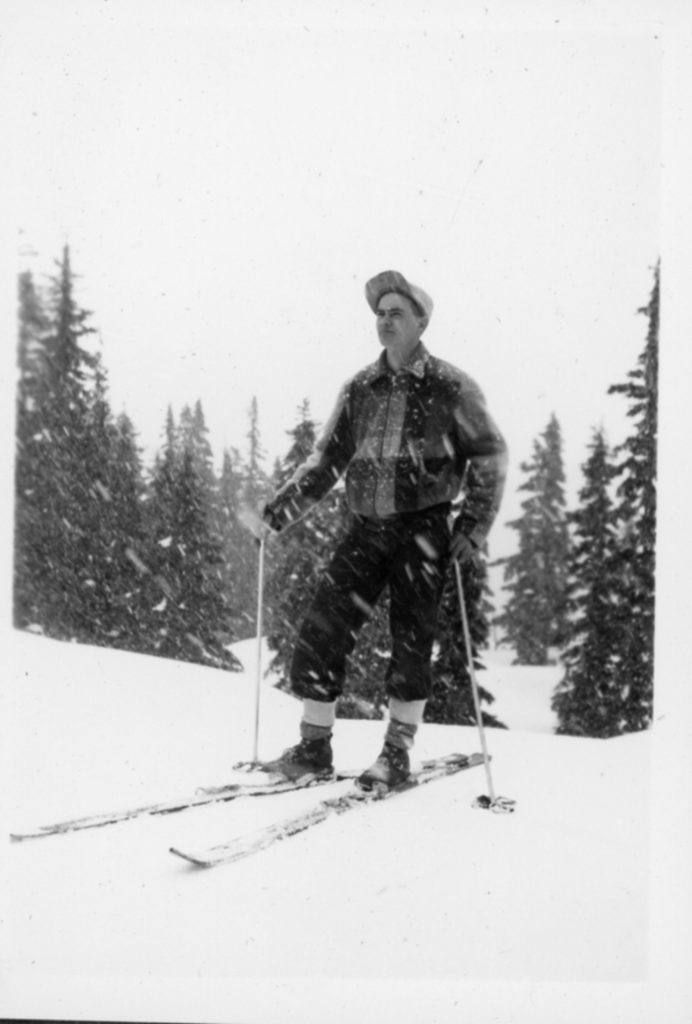

Various photos of Forbidden Plateau in the 1940’s – Harry Dougan photos.
Although Forbidden Plateau was known throughout British Columbia for its ski jumps where distances over 200 feet could be reached, Harry never had the nerve to attempt that sought of “big air.” When not at the Lodge, Harry and his buddies were happy to ski the forestry logging roads on their old wooden skis around Qualicum Beach. On one particular ski trip in January 1948, Harry, Arthur Bartlett and Darcy Reddyhoff, with the blessings of their parents, decided to ski Mount Cokely. They knew it would be a long day, but they were familiar with the mountain as they had worked for the two summers on the trail. Conditions on the upper slopes weren’t very good and they spent more time carrying their skis. When they started to come down the weather changed with thick fog moving in. The managed to reach one of the cabins down along the CPR trail and decided to hunker down for a while. After several hours the fog lifted and the moon came out. Aware that their families would be worried, they re-packed and headed down to their vehicle at Cameron Lake and eventually reached their respected homes at 5 a.m. As the young members gradually moved away seeking higher education and careers, the Qualicum Beach Alpine Club slowly dissolved. Harry Dougan eventually moved to Comox, but had kept many of the letters, photos and documents belonging to the fledgling club.
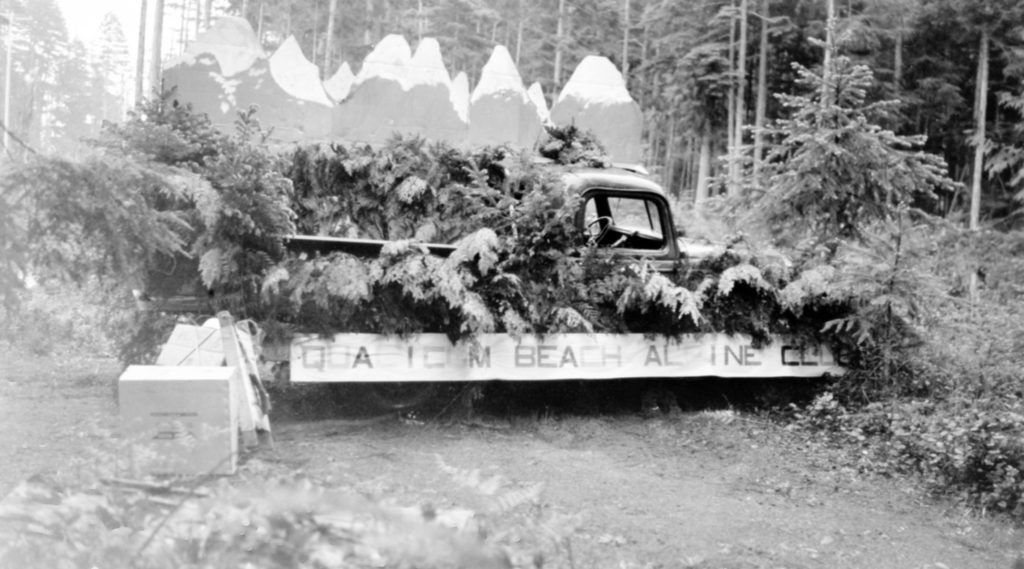
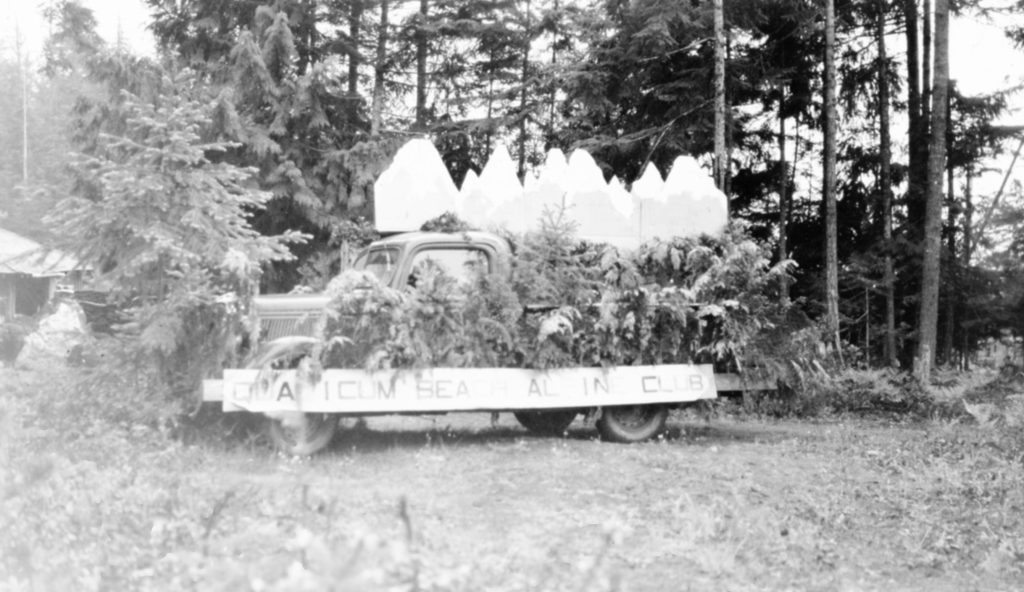
The float built by the Qualicum Beach Alpine Club for the 1946 Canada Day parade in Qualicum – Harry Dougan photos.
Founding members of the Qualicum Beach Alpine Club:
James (Jimmy) White
Henry (Dick) and Edna Dougan
Harry Dougan
Percy and Flora Reddyhoff (Flora was the sister of Henry Dougan)
Darcy Reddyhoff
Oscar Magnus Frederikson
Roger Whitmee Sr
Roger Whitmee Jr
Arthur Bartlett
Jon Burgess
R. Thwaites

Harry Dougan and Oscar Frederikson – Harry Dougan photo.

Harry Dougan and Roger Whitmee Jr. – Harry Dougan photo.

Harry Dougan and Roger Whitmee Sr. – Harry Dougan photo.
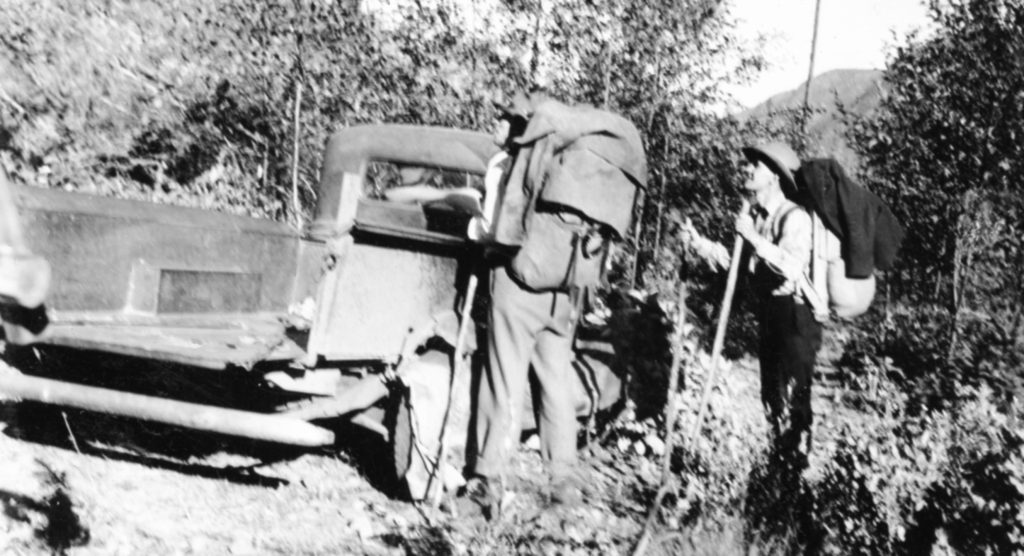
Roger Whitmee Sr. and Jr. at the Mt. Cokely trailhead – Harry Dougan photo.
Dear Mr. Dougan
Thanks for your letter and inquiry re Comox Glacier. We planned a trip into the glacier until the forest closure but have been unable to go. The route I have taken on my previous trips has been up Comox Lake by boat and then hike into the third little lake up the Puntledge valley. From the third little lake you climb up onto Mt. Evans [Kookjai] ridge on the right side of the lake. You follow the ridge along until it swings around gradually right onto the ridge approaching the south face of the glacier. The last good water is at Black Cat Lake near end of Mt. Evans. From there on you descend on snow or snow creeks. The climb out of the third lake is a dry one until you are well up on Mt. Evans. The whole trip could be done comfortably in four days. There is another route up the South Fork of the Cruikshank valley where the Comox Logging is working. Some have travelled by their trucks well up the valley and then climbed Mt. Evans ridge up left on the opposite side of the Puntledge valley. I don’t know whether you can go up with the Comox trucks but I have always liked the extra walking because of the nice country and after all I imagine you are wanting to go as an organized hike. I don’t how you will get up the Comox Lake but I believe when the size of the party is determined and the time arranged you will be able to get someone who has boats to do the job. If there is any further information I can give – drop a line.
Yours sincerely
Sid Williams
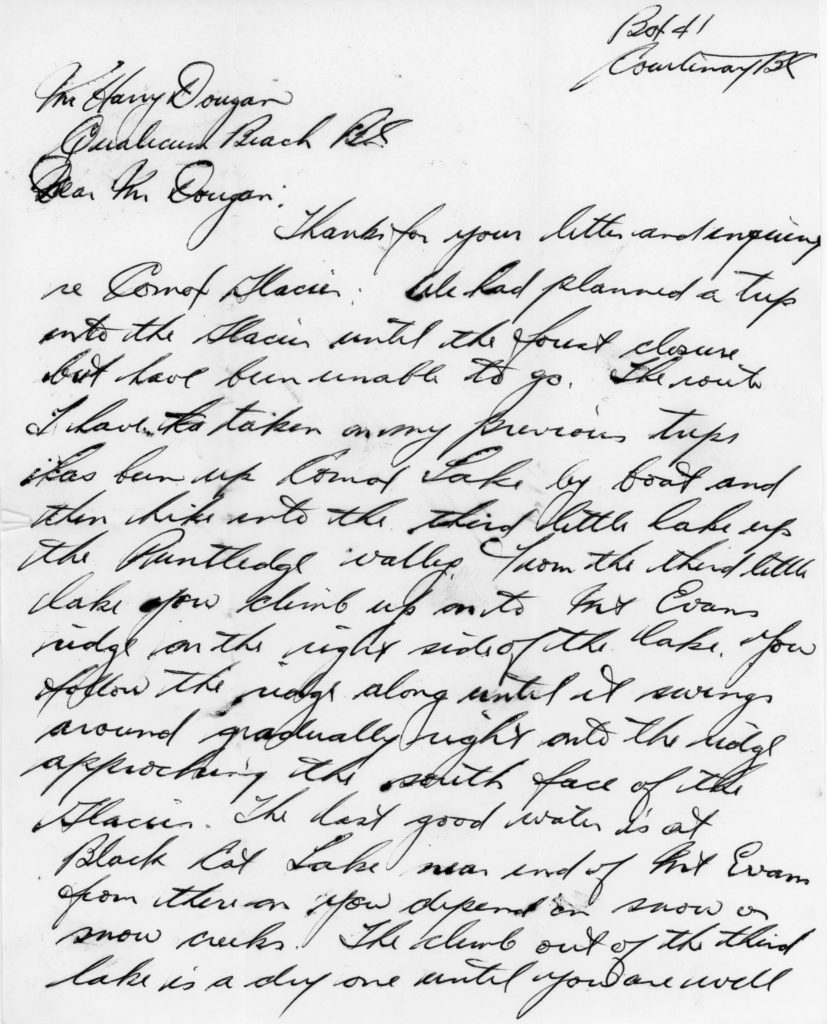

Letter from Sid Williams to Harry Dougan regarding access to the Comox Glacier. Date unknown – Harry Dougan files.
QBAC trip to the Comox Glacier via Kookjai Ridge (Harry Dougan, Roger Whitmee Jr. and Roger Whitmee Sr.) 1940’s – Harry Dougan photos:

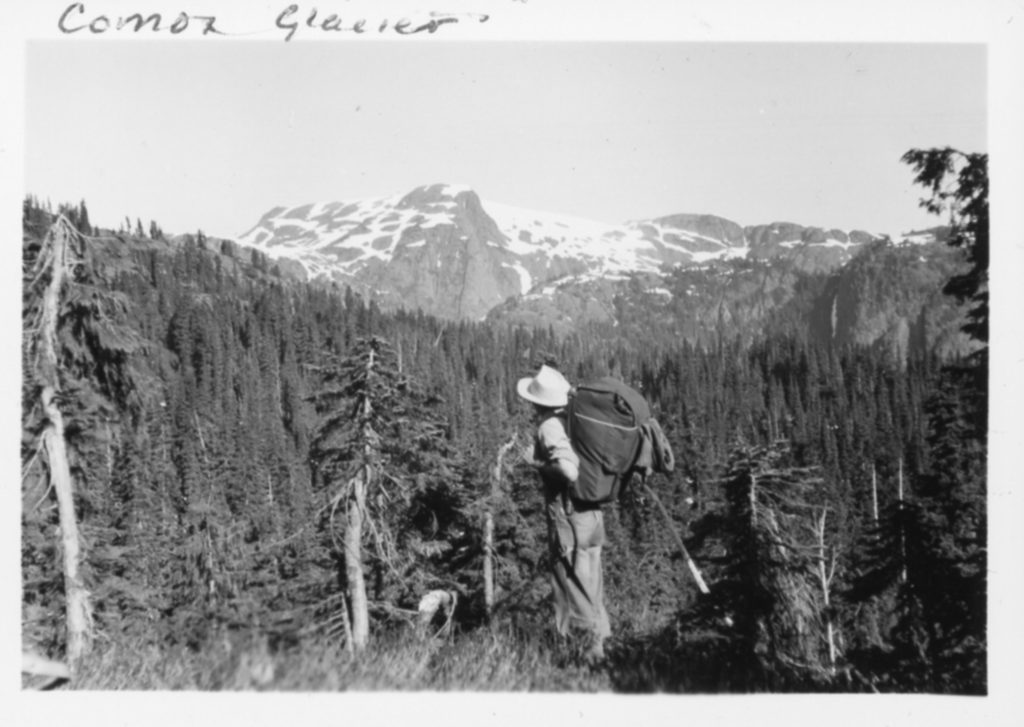
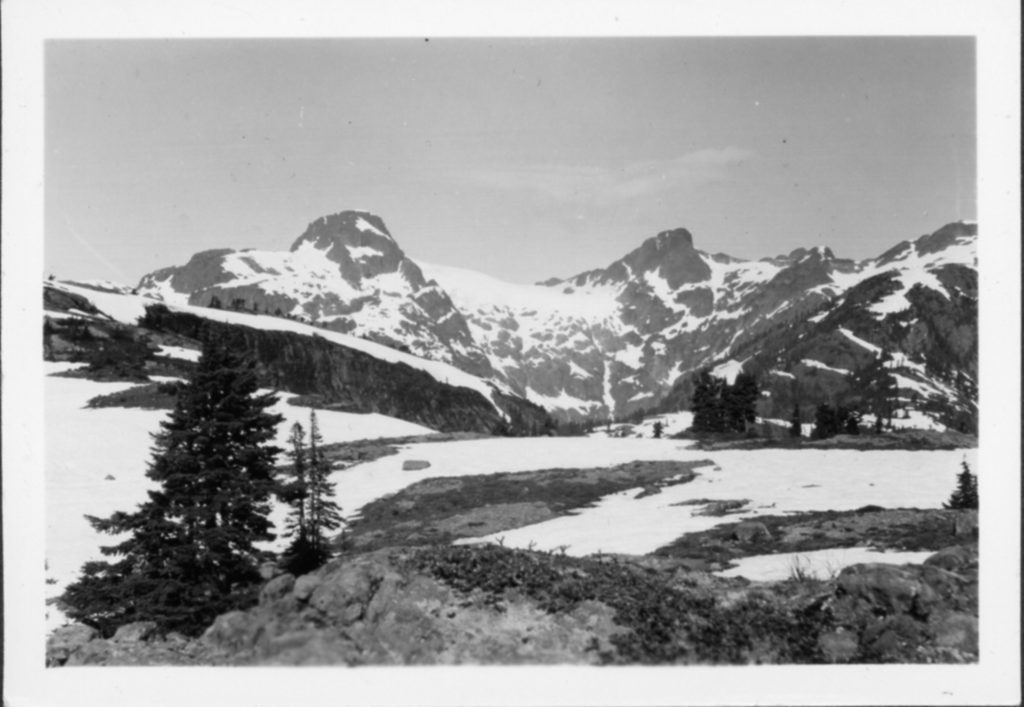
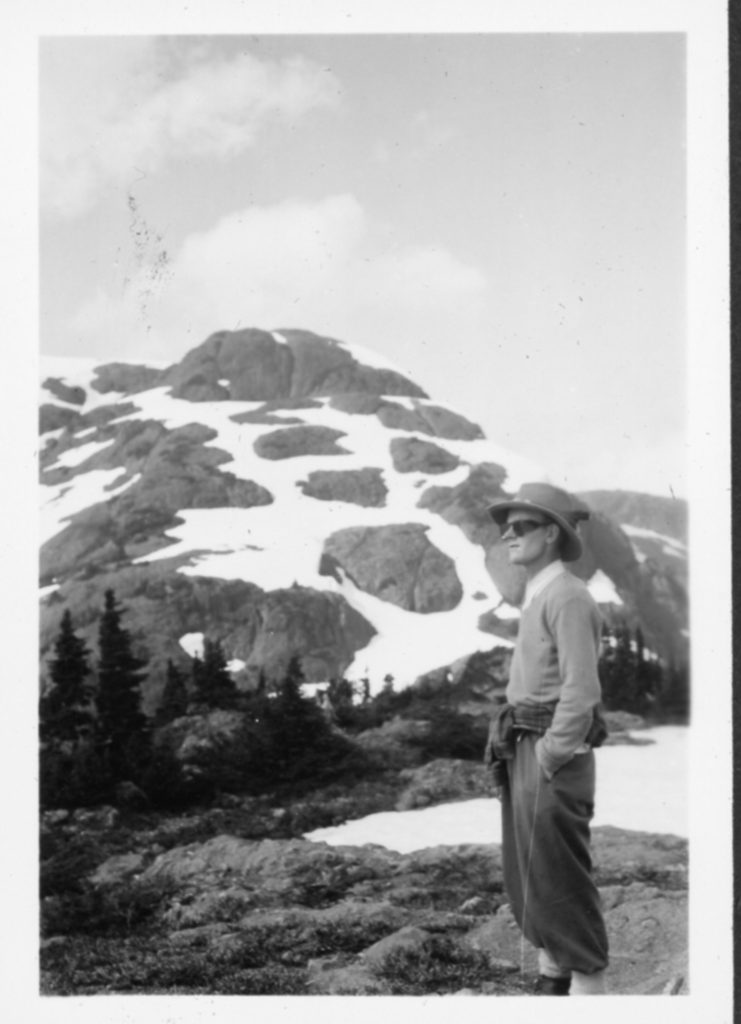
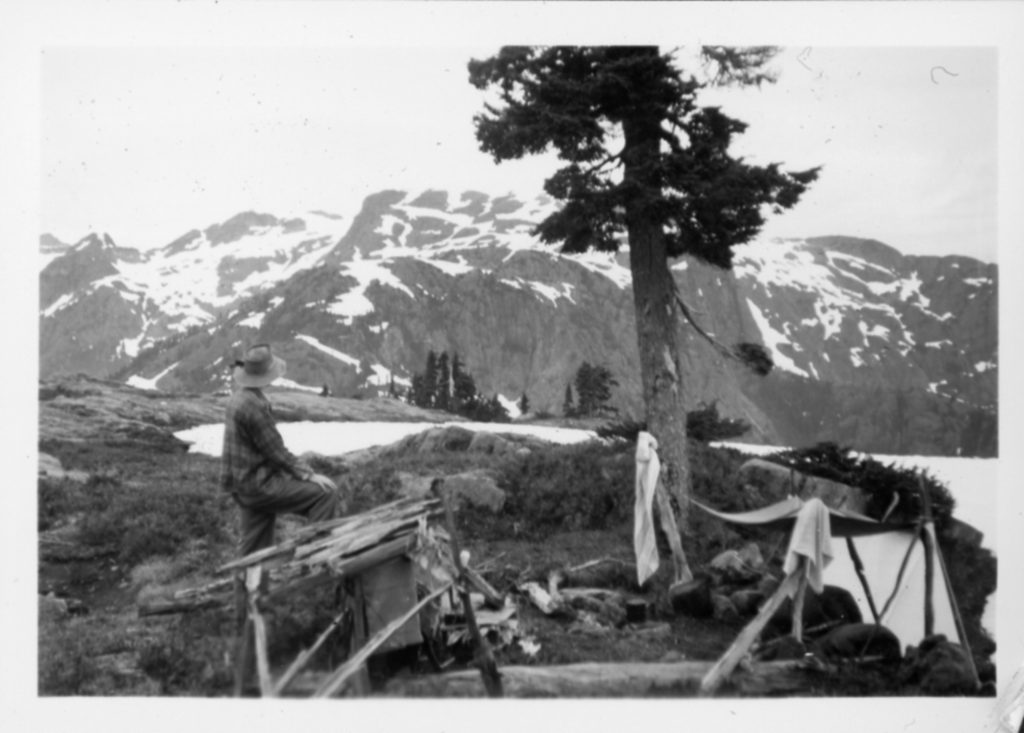
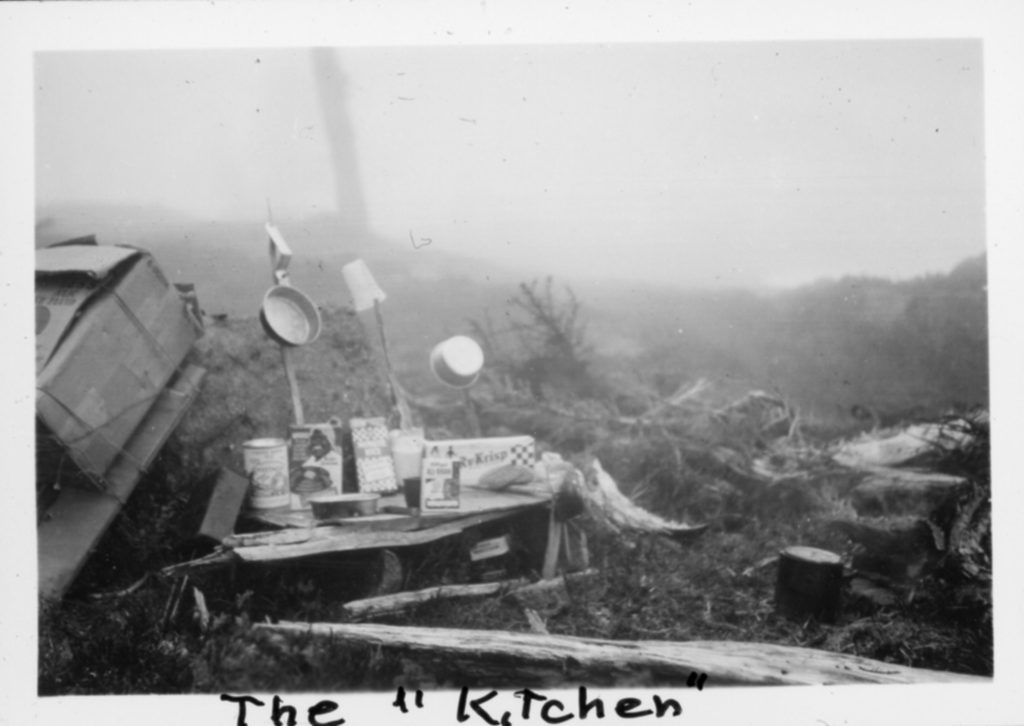

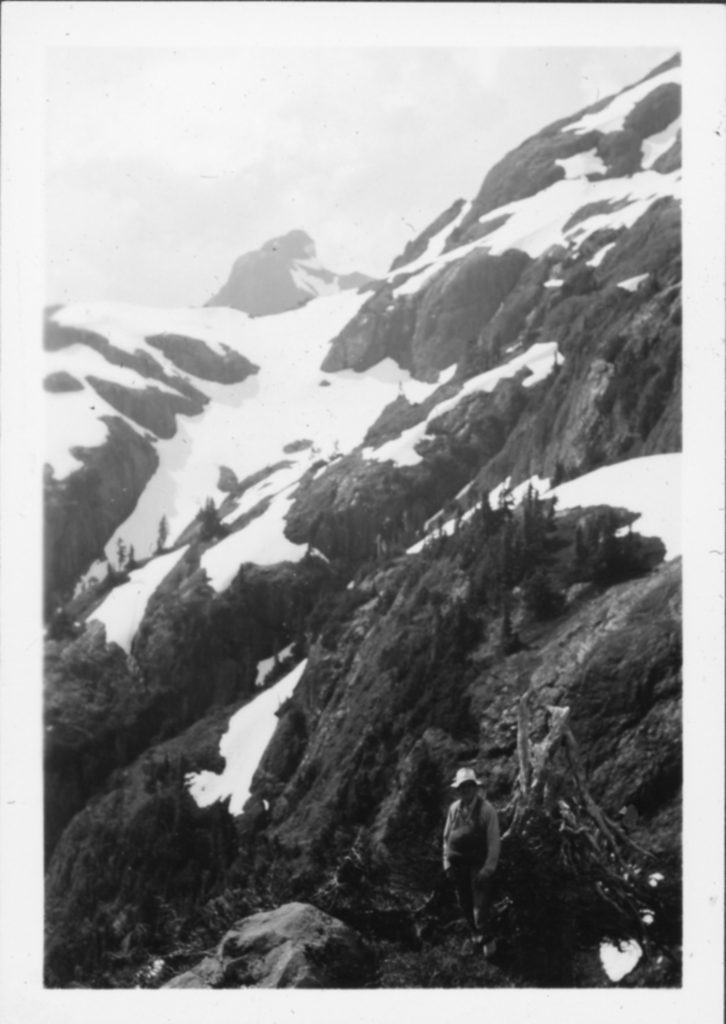

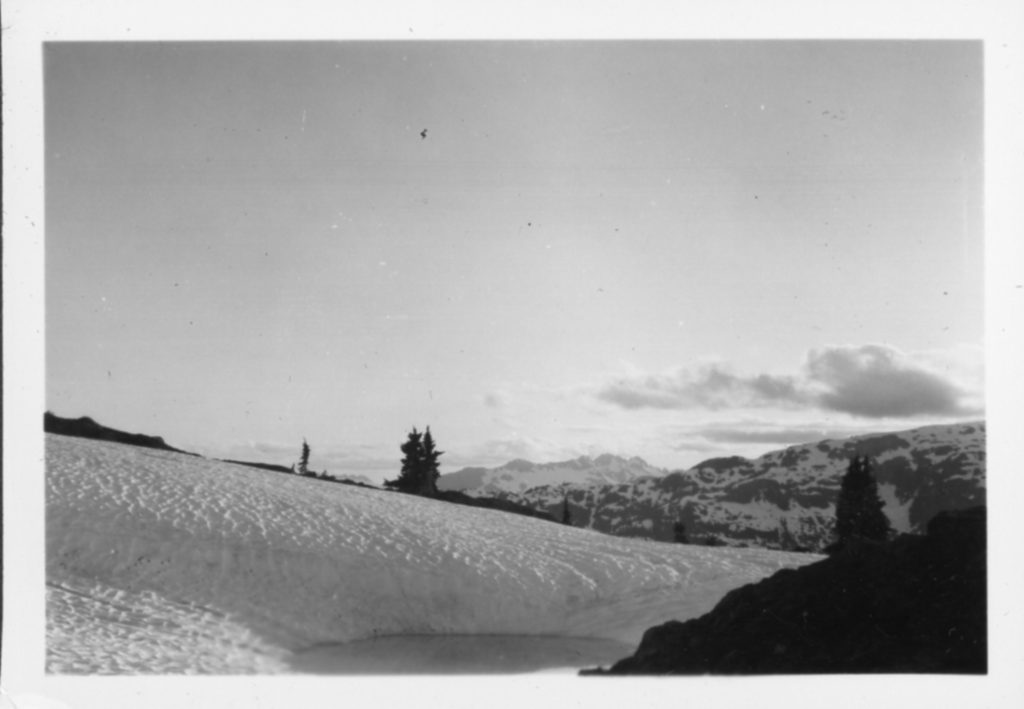
QBAC trip to the Comox Glacier via Kookjai Ridge
QBAC trip to The Golden Hinde (Harry Dougan, Roger Whitmee Jr. and Oscar Frederikson) 1940’s – Harry Dougan photos:
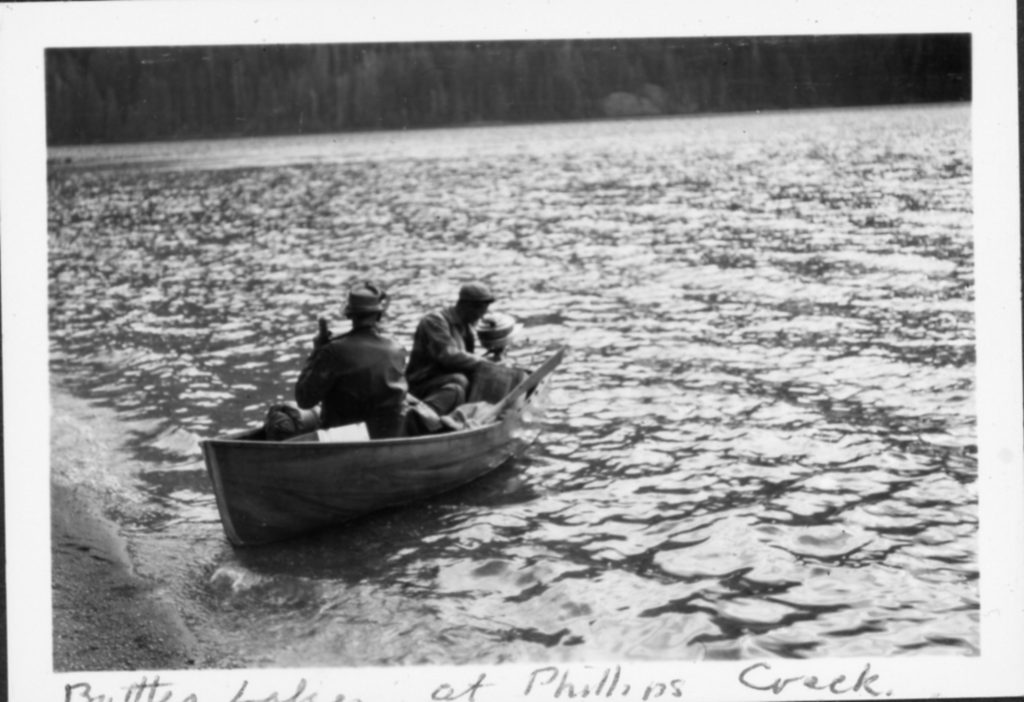


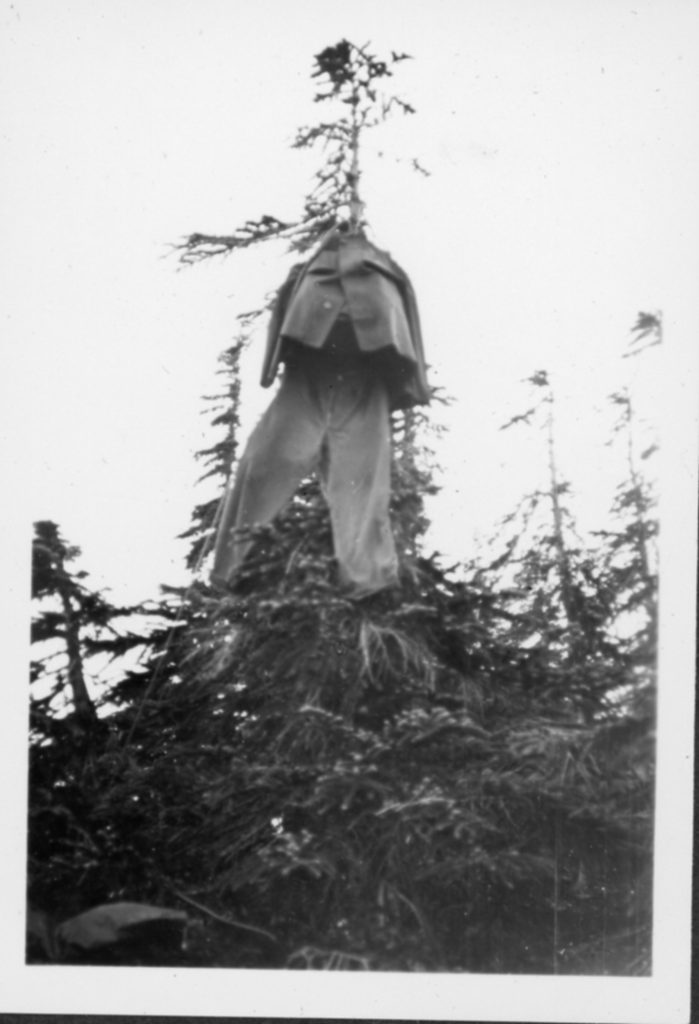


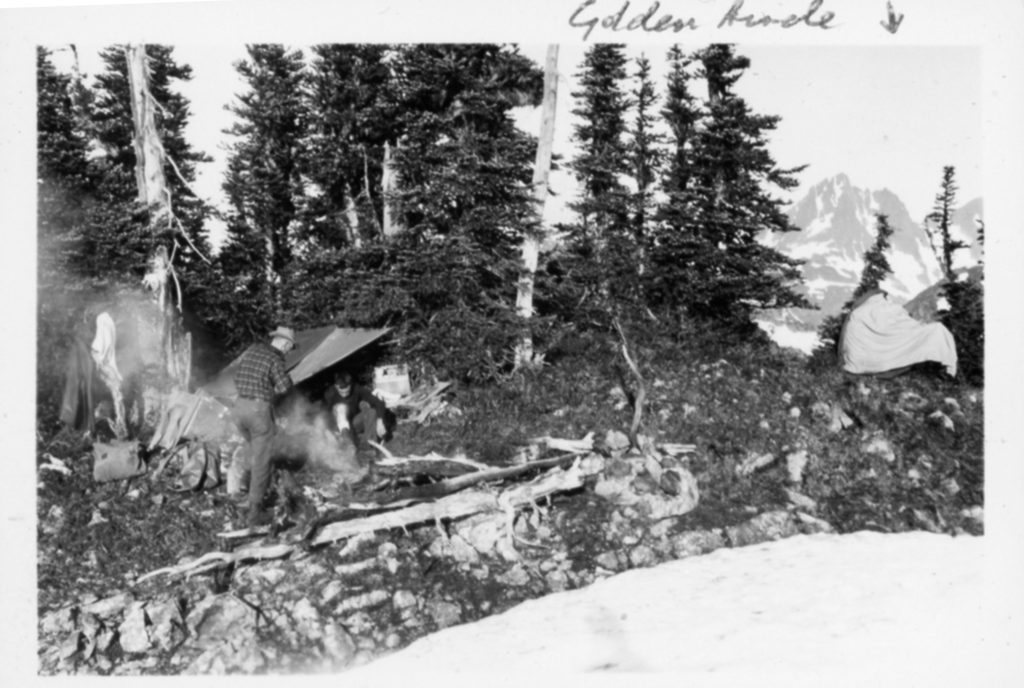

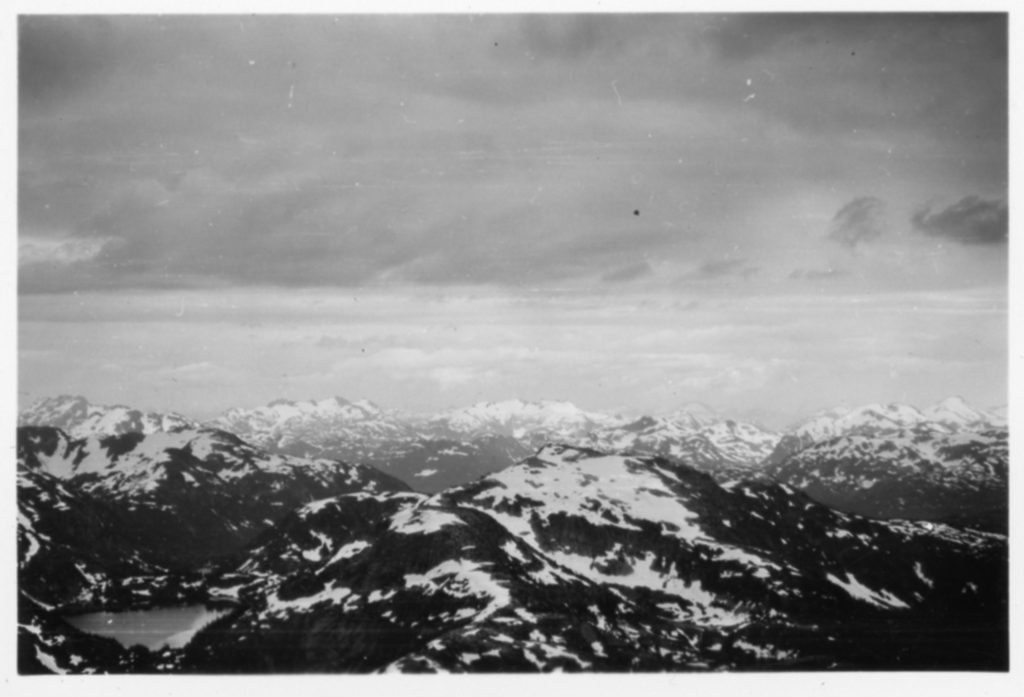
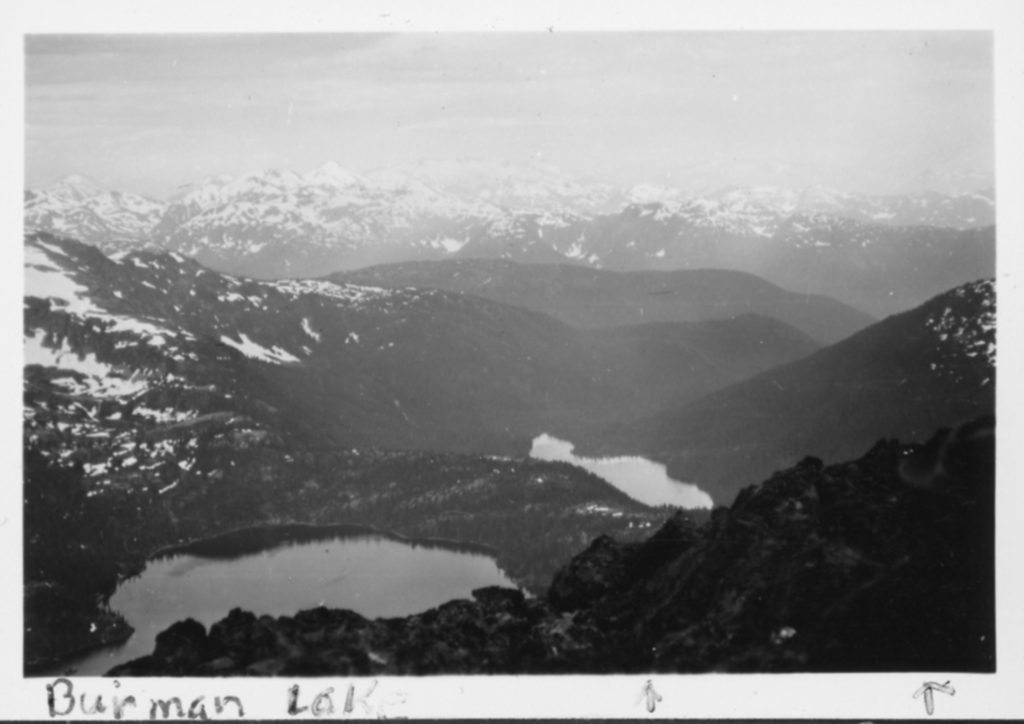
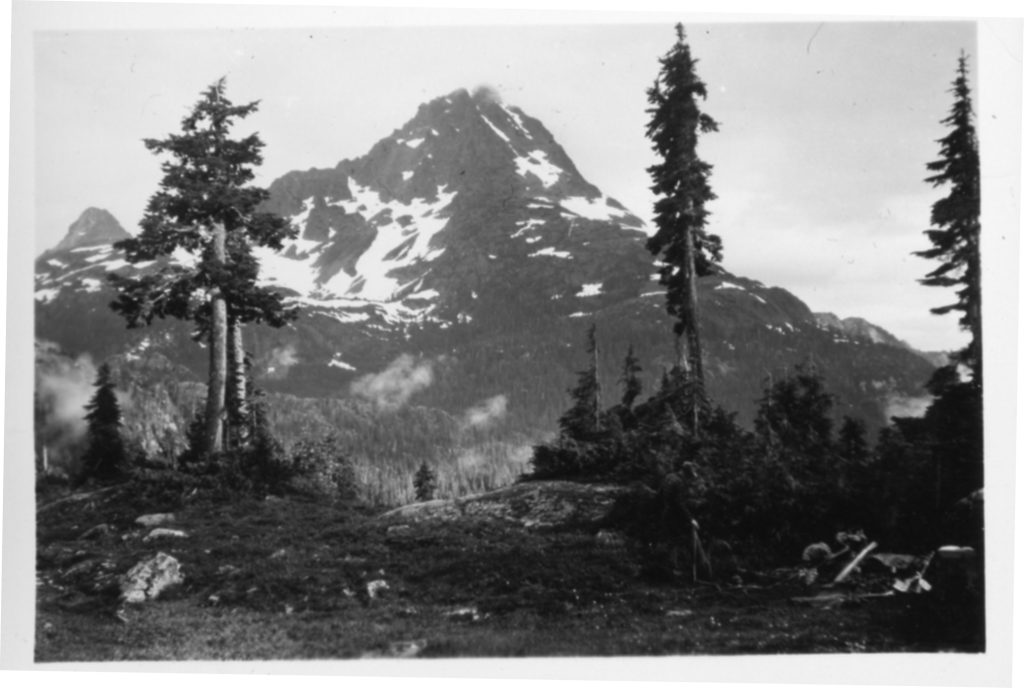
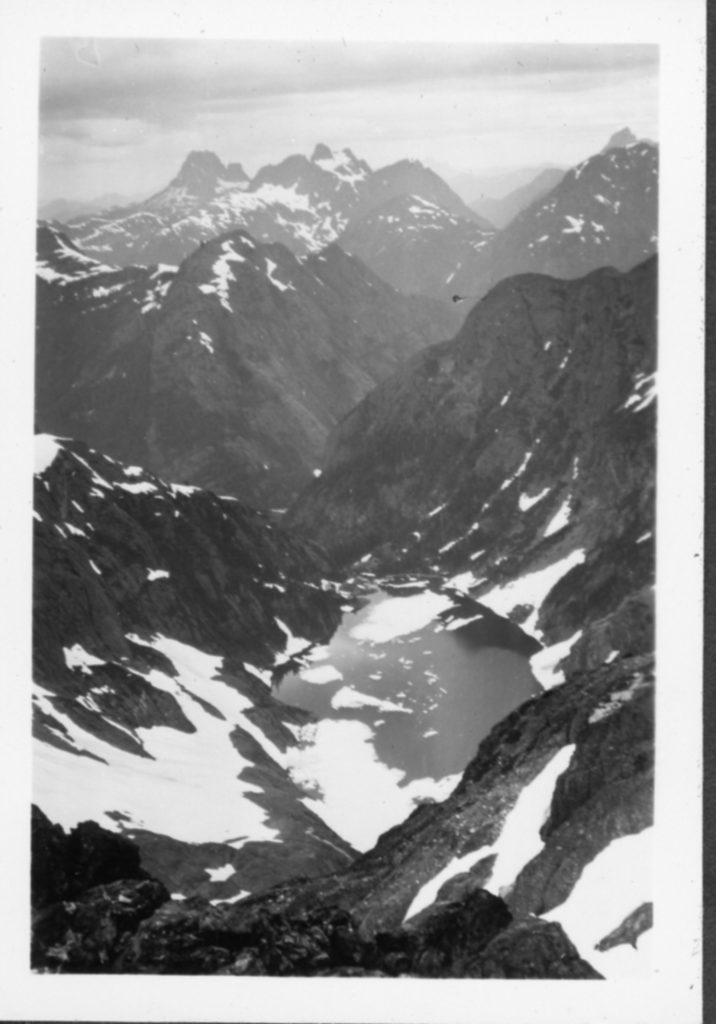


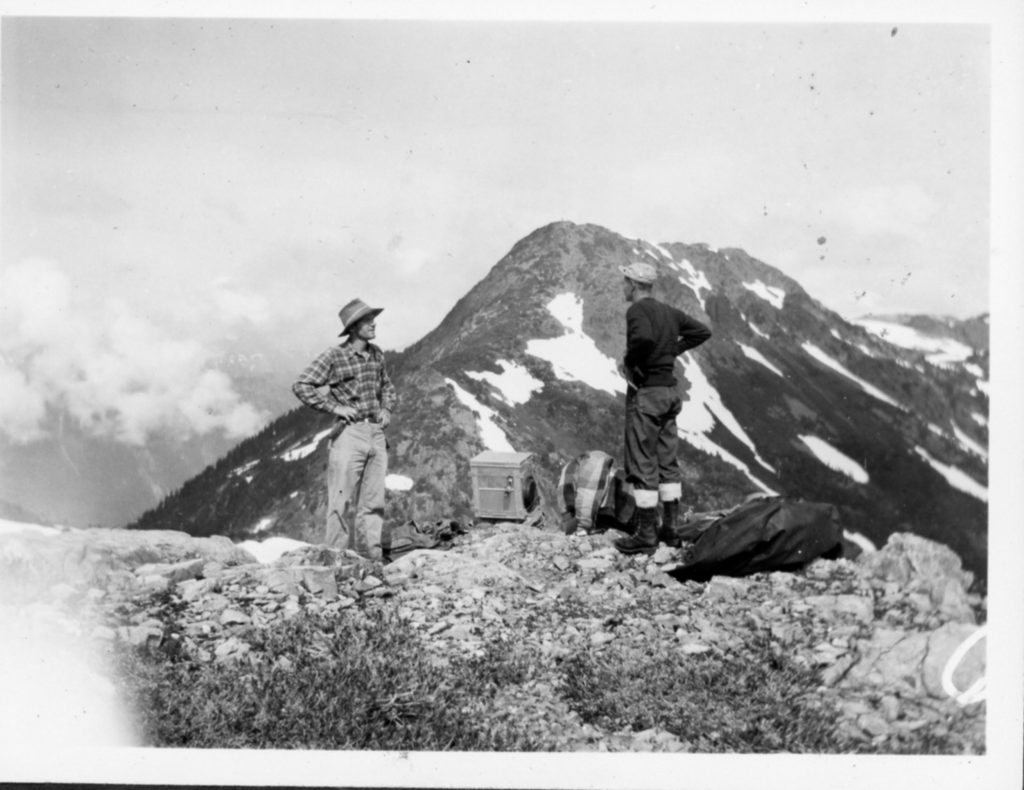
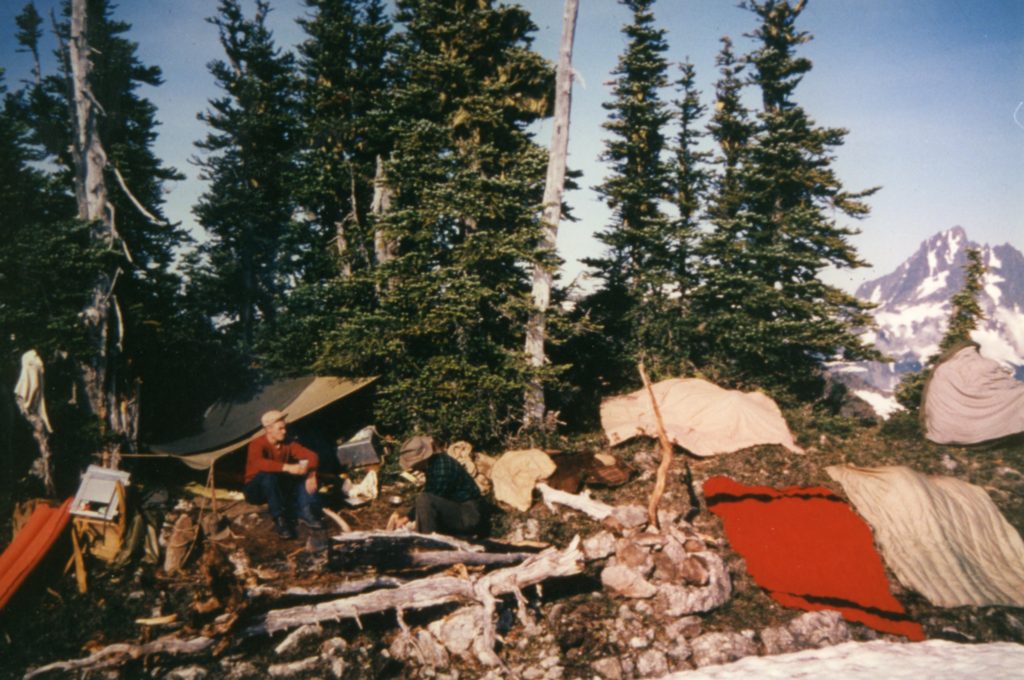
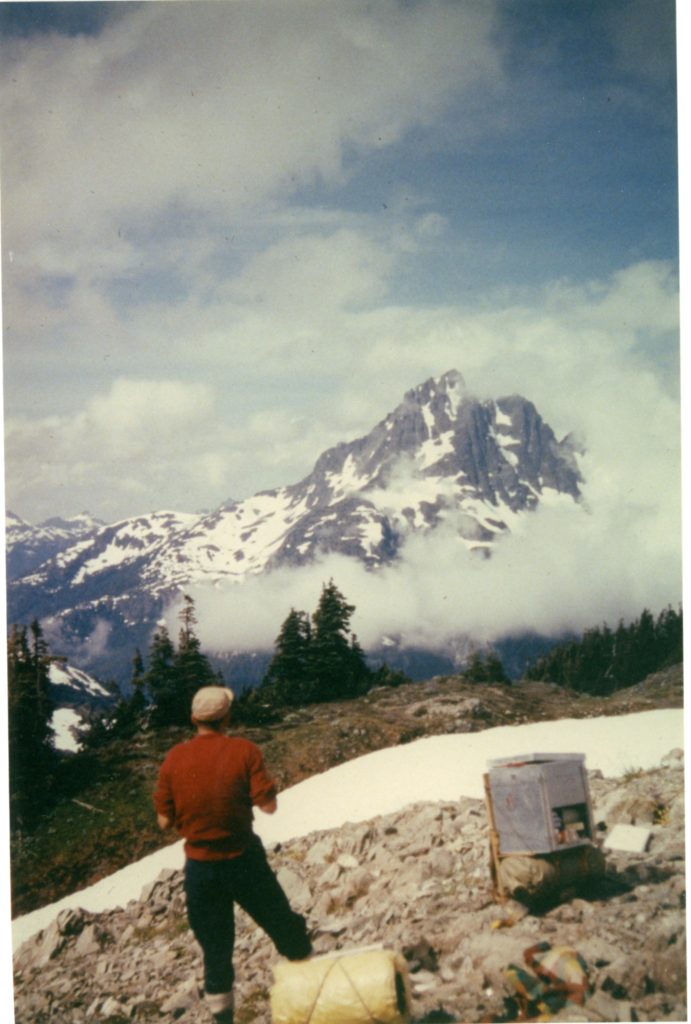
Various photos of QBAC trips up CPR trail to Mt. Cokely1940’s – Harry Dougan photos:
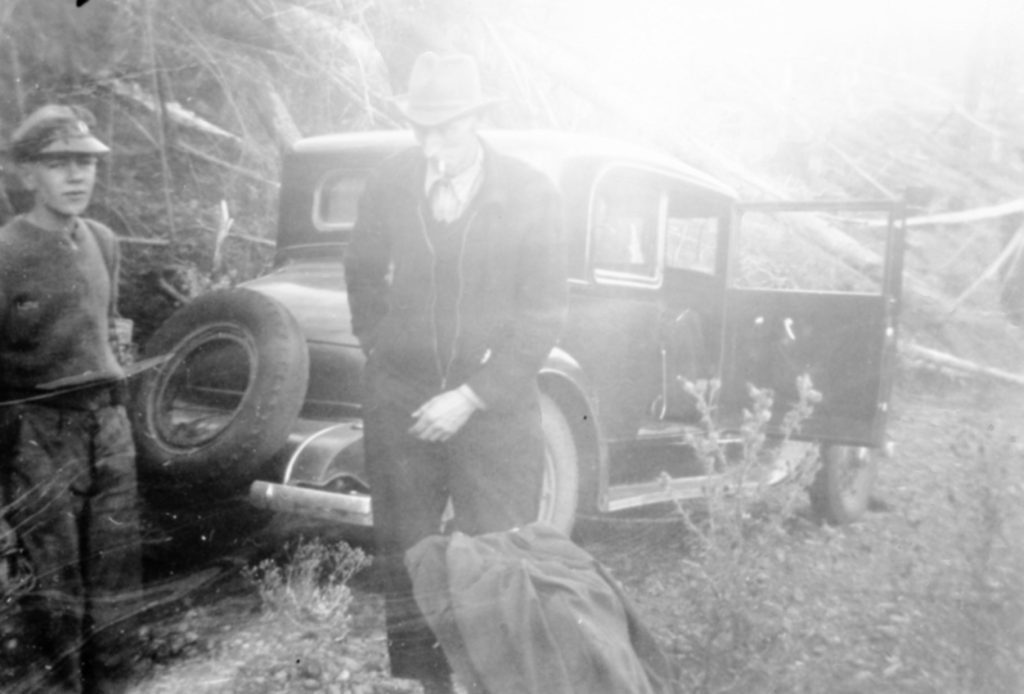
Oscar Frederikson and ? at unknown trailhead – Harry Dougan photo.
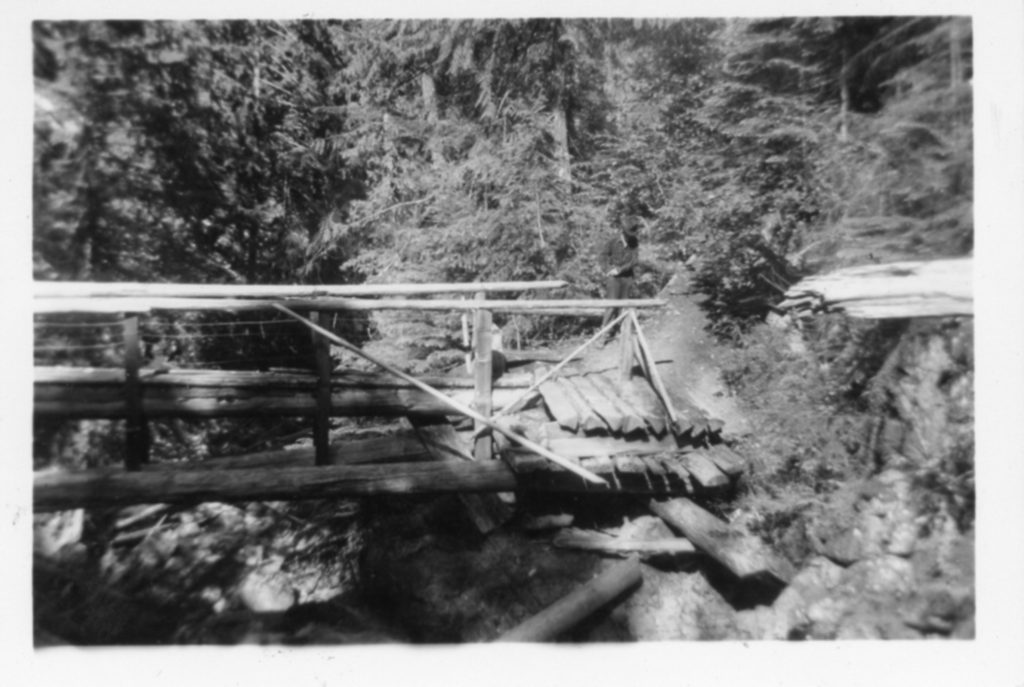
Construction of the McBey Creek bridge 1947 – Harry Dougan photo.
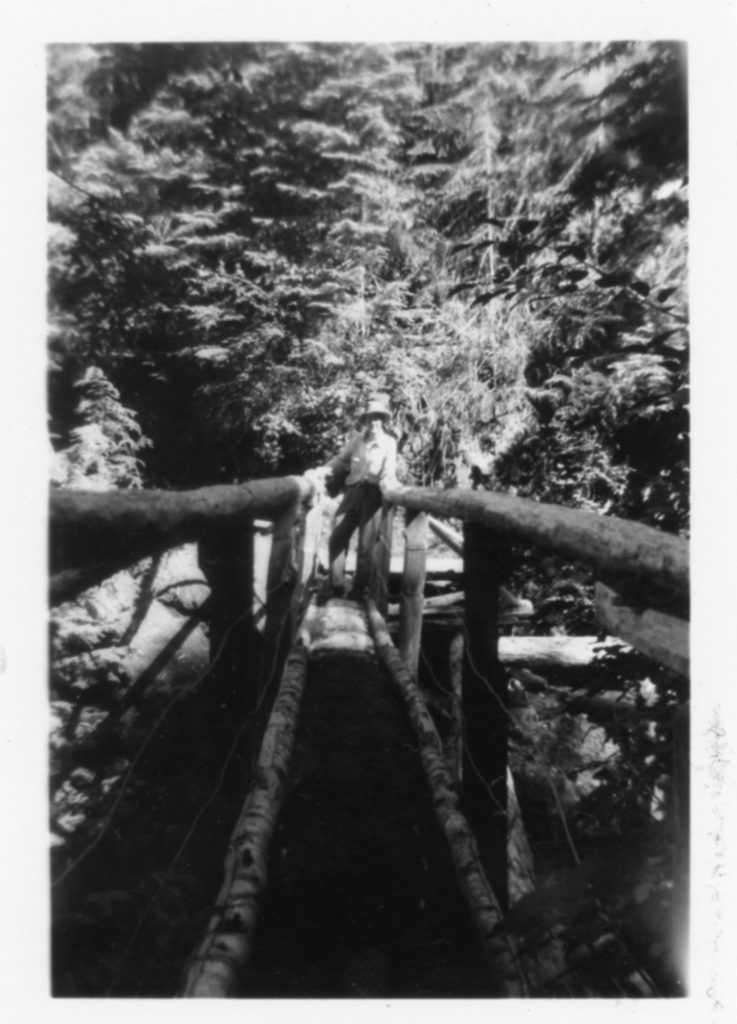
Construction of the McBey Creek bridge 1947 – Harry Dougan photo.


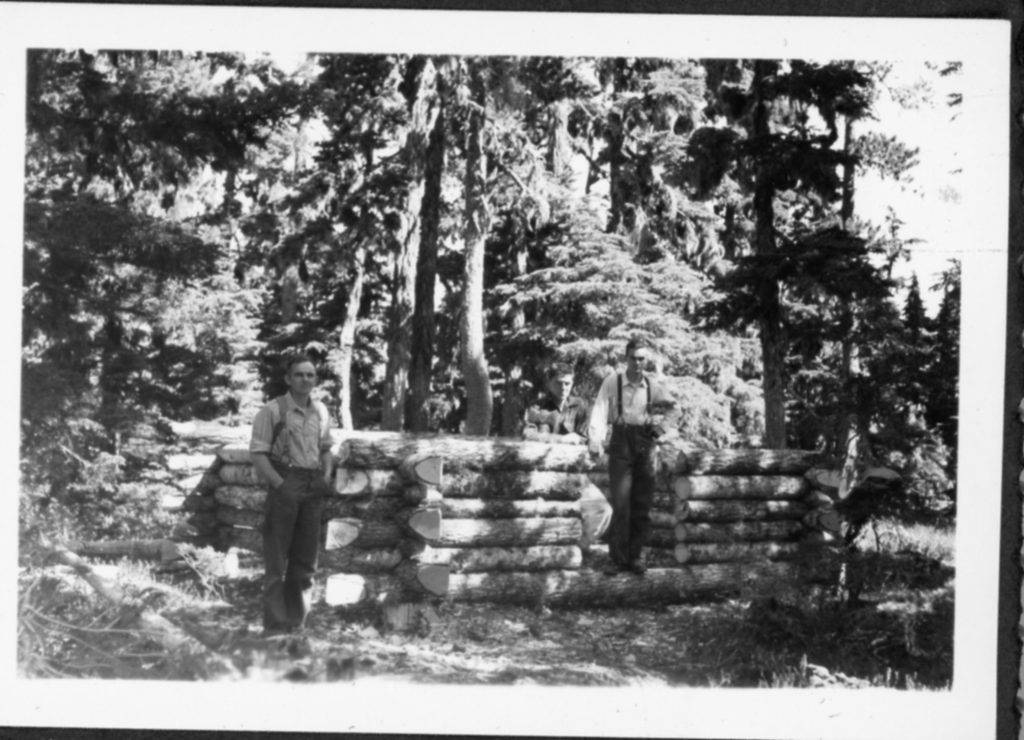


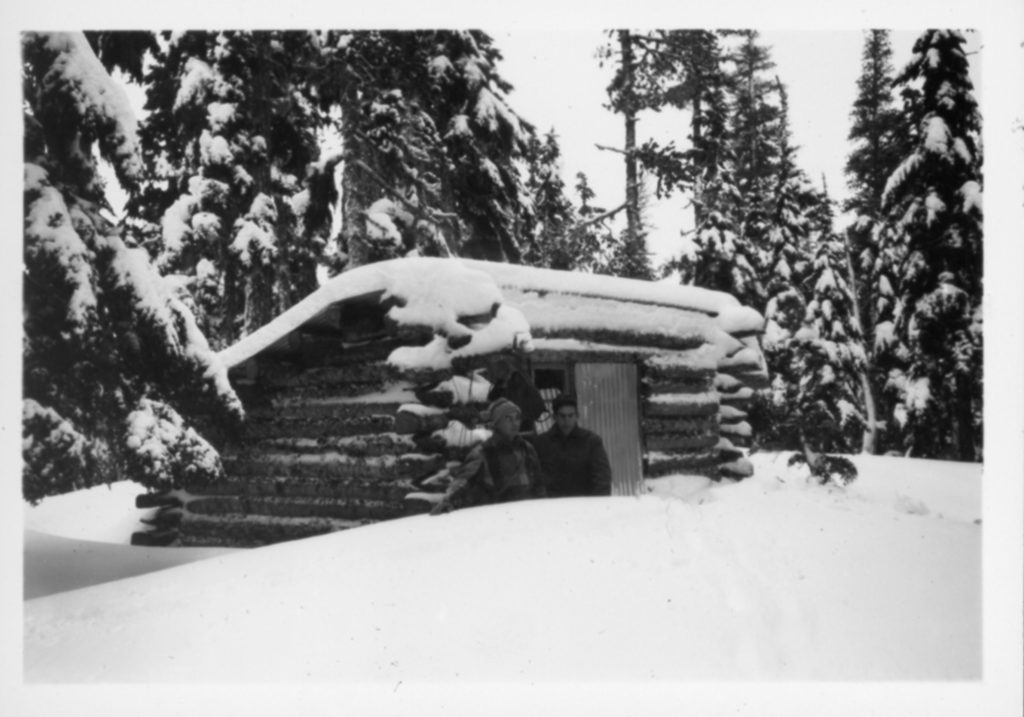
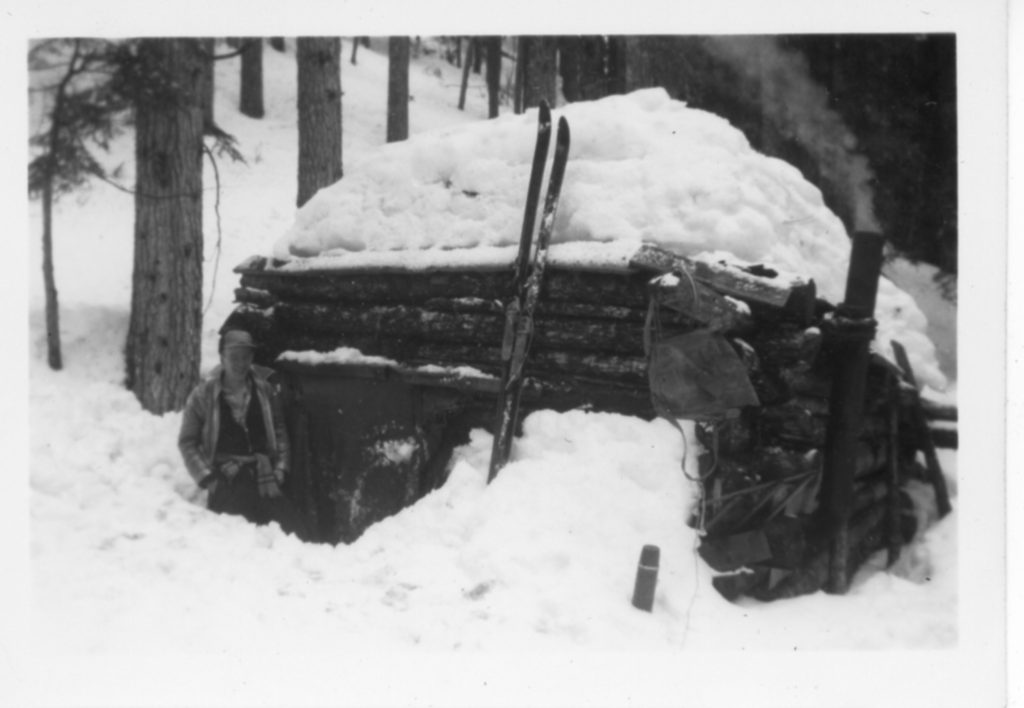
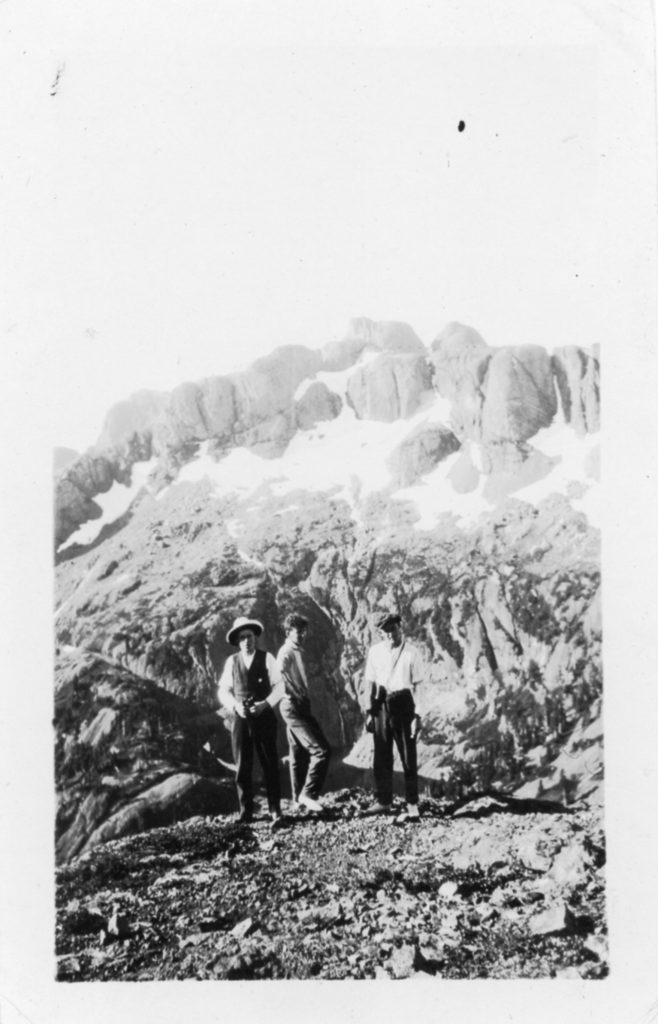

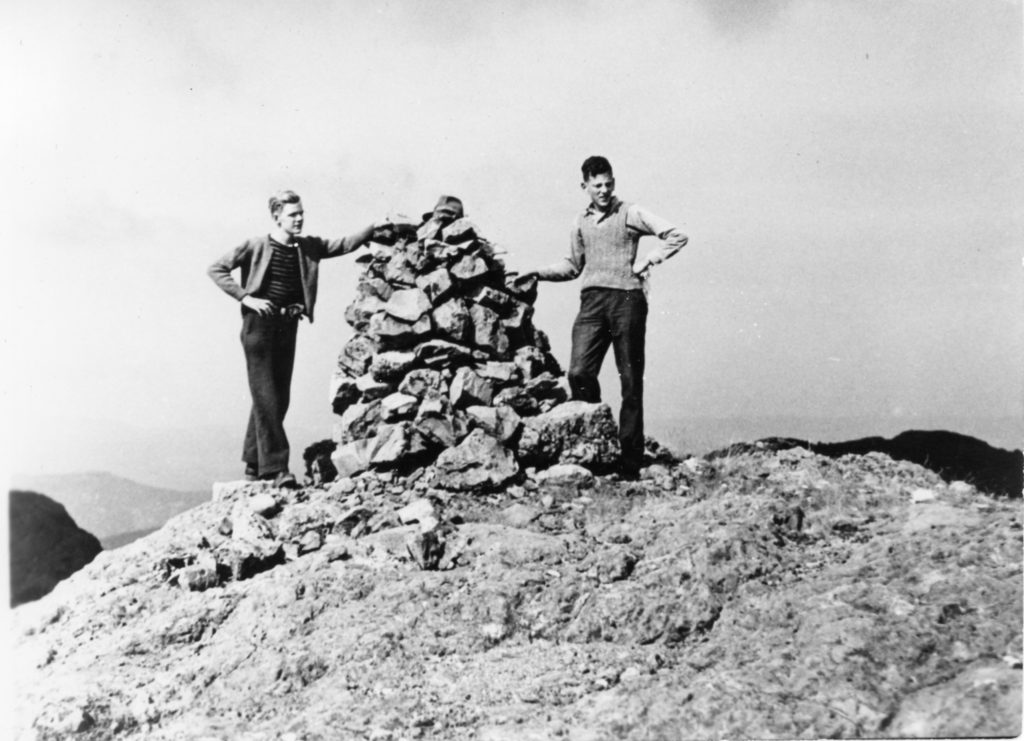


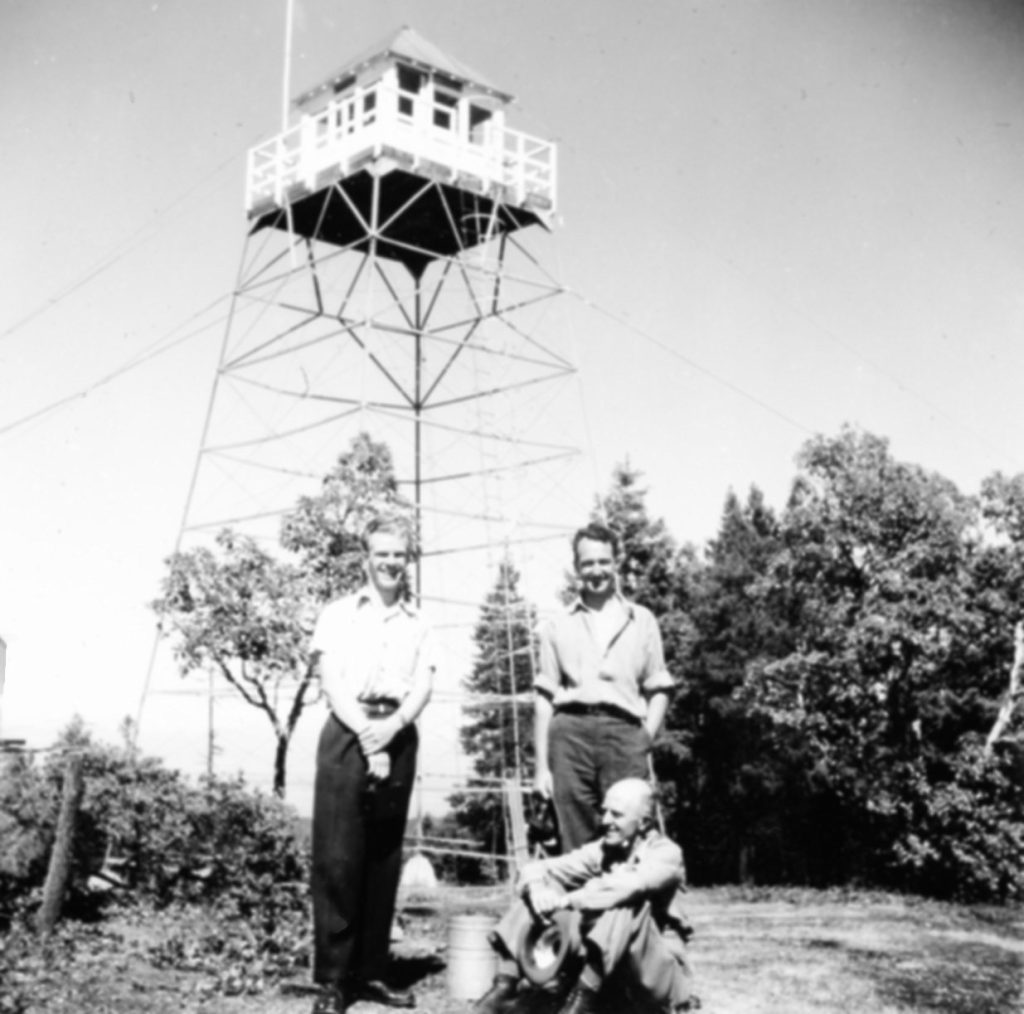
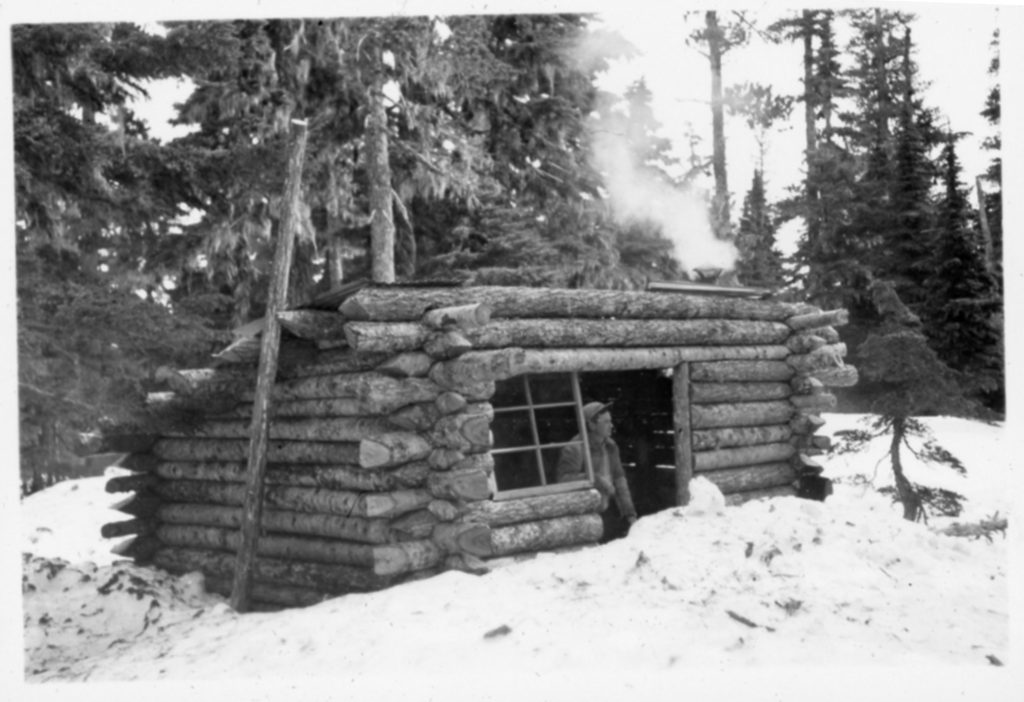
Little Qualicum Mtn. fire look-out – Harry Dougan photo.
Returns From Camp
Reported in The Victoria Daily Times Friday August 3, 1945, p.6.
Dr. Irene Bastow Hudson has returned to Victoria from the Eremite Valley, where she camped with the Alpine Club of Canada.
To Top of Mt. Arrowsmith
Reported in the Comox Argus Thursday August 31, 1945. p.1.
QUALICUM BEACH, August 29—Two young members of the Qualicum Beach Alpine Club, Harry Dougan and Jamie Robertson, accompanied by Commander J.R.S. Moss hiked to the top of Mt. Arrowsmith on Thursday the 27th. They reported tough going the last one hundred feet of the 6,000-foot climb, with visibility only fair. Commander Moss recommends an anchored chain, as used in Switzerland, on the last one-hundred-foot peak would be a great help. The party was accompanied as far as Mt. Cokely by Mike Hobbs and Jim Bisicker.
Mountaineering Club
Reported in the Comox Argus Thursday September 27, 1945. p.1.
The annual meeting of the Comox District Mountaineering Club was held last week in the Sillence Photo studio. The officers for the coming year are: President Bob McPhee, Vice-president, Sid Williams, and secretary-treasurer, Griffin Lloyd. It was decided to reclink the cabin and to put a new window in. It was also decided to procure new lockers from the War Assets Corporation. The cabin is in excellent shape and a large supply of wood is prepared for the number of skiers expected this coming season. Many are expected. Any persons desiring to join the club are requested to phone or see the secretary or any of the officers.

Preparing firewood at the cabin on Mt. Becher for the coming season.
Nine Peaks

Fred Drinkwater and his two daughters on the glacier below Nine Peaks 1945.

Nine Peaks and Bear Pass from Della Lake 1907.

View of Nine Peaks in 1909 – Leonard Frank photo.
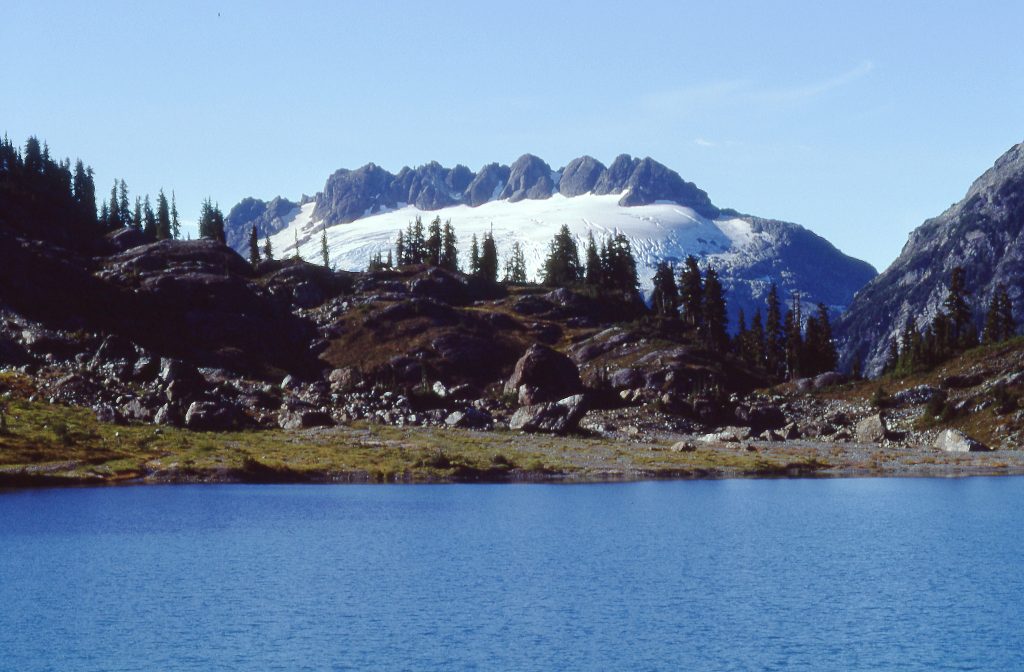
Nine Peaks from Cream Lake – Lindsay Elms photo.
McKay Peak, Vancouver Island
Reported in The Canadian Alpine Journal Volume 29-No. 2, 1946. p.114.
By W.A. Don Munday
The British Columbia Historical Quarterly, October, 1945, records the unveiling of a plaque in Nanaimo, B.C., in memory of William Joseph McKay, the Hudson’s Bay Company official who opened the first coal mine there. In the course of the ceremony, it was announced that “the high peak between Ladysmith and Victoria that has been known as Buffalo Observation Point will henceforth be known as Mt. J.W. Mackay.” Information from the Department of Lands and Forests show that the name is McKay Peak, 4,138 feet, at the head of Haslam Creek, 12 miles west of Ladysmith, and the same distance southwest of Nanaimo. Buffalo Hump is the local name for a smaller feature nearby. A survey triangulation station on McKay Peak was referred to as “Buffalo” but it is thought that that name had any other currency. The original spelling of McKay was Mackay, but the Hudson’s Bay Company insisted on uniformity of spelling of names with the pronunciation. He was born in Rupert House on Hudson Bay, and crossed the Rockies at the age of 15. He was only 23 when Chief Factor Douglas (later Sir James) sent him to open a coal mine at Wintuhusen Inlet, a name soon dropped for “Nanaimo” which was a modification of Snenyimo. (Coal was found first by an Indian chief while digging clams on the beach. He had not seen coal before but tried it in his campfire. When he visited the Hudson’s Bay Company for at Victoria and saw coal in use by the blacksmith, he offered to bring a canoe load in return for a suitable reward. On fulfilling his boast, he was given a bottle of rum and his gun was repaired without charge.) McKay rose to become Chief Factor, and later joined the Department of Indian Affairs, remaining in the government service until his death at the age of 81, in 1900.
1946
ACCVI executive:
Chairman – Mark Mitchell (elected in November 1945).
Secretary/Treasurer – Muriel Aylard.
Executive Committee – Ethne Gale, Jean McDonald, Irene Bastow Hudson, Frederick Longstaff, (Stephanie Bowes elected in November 1946).
Events:
January 6 – Club trip to Mt. Helmcken.
February 11 – Rex Gibson gave an illustrated slide talk on the Rockies.
March 29 – Club’s annual banquet held at the Empress Hotel.
May 24 – A ski ascent of Mt. Baker with the Vancouver Section.
June 9 – Club trip to Mt. Wells, Sooke.
July 1 – Club camping trip to Olympic Mountains.
August 18 – Club trip to Mt. Arrowsmith.
September 1 – Club trip to Mt. Olympus.
September – Five-day club trip to Mt. Olympus led by Mark Mitchell.
October 13 – Club trip to Big Interior Mountain led by Mark Mitchell.
November 22 – Club annual meeting at Muriel Aylards home. Executive members were elected and Rex Gibson gave a talk on the Lovat Scouts.
Section members who attended the ACC general summer camp at Bugaboo Creek July 14 – 28: Mark Mitchell, Pamela Mitchell (graduated on Anniversary Peak), Rex Gibson, Ethne Gale, Irene Bastow Hudson, William Heybroek (graduated on Cresent Spire).
Section members who passed away in 1946: John Forde, Francis Kermode.
Alpine Club of Canada
Reported in The Victoria Daily Times Saturday February 2, 1946, p.2.
Alpine Club of Canada, Victoria section – Lecture illustrated with Kodachrome pictures “Ski Mountaineering in the Rockies” by Major Rex Gibson, February 11, 8 p.m., Victoria Truth Centre, 734 Fort Street. Public is invited.
Fine Skiing at Plateau Lodge
Five Feet of Snow Two Thousand Feet Up
Reported in the Comox Argus Thursday February 14, 1946. p.1.
Two thousand feet up on the slope of Mount Becher at the Forbidden Plateau Lodge there is five feet of snow. Skiers both local and from Victoria are taking full advantage of this. The road to the Lodge is good until the last switchback and most people going up leave their car there and pack their belongings into the Lodge, where they can get everything they want for a delightful week-end. Last week-end there were 32 pupils from Victoria College there. They arrived on Friday morning and left on Sunday night. Parties are coming up from Victoria College for the next four week-ends and most of the guests at the Lodge are from Victoria but on Tuesday there was a large party of airmen from Kye Bay.
J.P. Forde, Builder of Drydock, Dies
Reported in The Victoria Daily Times Wednesday February 27, 1946, p.1.
John Preston Forde, engineer who notable works included construction of the new Esquimalt drydock, died today at his home 1023 Esquimalt Road. He was 73. Born in Belfats, Mr. Forde studied engineering in Ireland and came to Canada in 1891, and was engaged in land surveying in Vancouver, and the Bridge River district. In 1903 and 1904 he was with the engineering and construction department of the Great Northern Railway, and then became division engineers for the C.P.R at Revelstoke. After seven years in this post, he became district engineer for the Federal Public Works Department at Nelson. Subsequently he was transferred to Victoria and in 1933 his headquarters was moved to New Westminster where he had charge of all Dominion public works for B.C. and Yukon Territory. He retired in 1938 after an exceedingly active life. In his younger days he took great interest in the Alpine Club of Canada, being vice-president for several years, and was a member of the Cascade and Henderson Lodge, A.F. & A.M. He leaves a widow, Marion C. Forde, and two sons, George and Jack, and a daughter. Mrs. E.R. Vipond, Calgary.
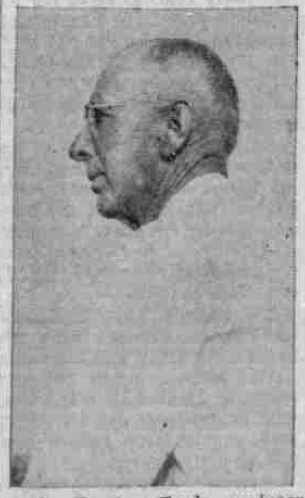
John Forde
20 Feet of Snow at Becher Cabin
Skiing Very Popular at Plateau Lodge
Reported in the Comox Argus Thursday February 28, 1946. p.1.
Last week-end saw seventy-five people at the Lodge on Mt. Becher. The rain and the south-easters have cut down the level of the snow at the Lodge to about three feet but that is plenty to clear the stumps. The trail to the cabin had not been broken last week and it will be very tough going for the pioneers on the trail. No one remembers so much snow at the higher levels. There must be twenty feet at the Cabin, which has disappeared under the drift. Mr. Angus McMonnies, secretary of the Mountaineering Club asks all those who want to go up on the chartered bus to get in touch with him.
Alpine Club Meeting
Reported in The Victoria Daily Times Monday March 18, 1946, p.15.
Annual dinner of the Victoria section of the Alpine Club of Canada will be held at the end of this month. Dr. Mark Mitchell is chairman and Miss Muriel Aylard, secretary-treasurer. Six members will attend the annual club camp in the Bugaboo Mountains, 30 miles southwest of Golden, next July. Evening meetings and outings are being arranged.
Alpine Club Dinner
Reported in The Daily Colonist Friday March 22, 1946, p.5.
Annual dinner of the Victoria Section of the Alpine Club of Canada will be held March 29 at 6:15 at the Empress Hotel.
Tells History of Alpine Club
Reported in The Daily Colonist Sunday March 31, 1946, p.10.
Tracing the history of the Alpine Club of Canada back as far as 1881, Major-General William W. Foster, former president, addressed the annual dinner of the Victoria section of the club at the Empress Hotel. He stated that although the club was officially formed in 1906 by the later Arthur O. Wheeler, the Marquis of Lorne had recommended its formation as early as 1881, after he had made a journey beyond the end of the railway into the alpine country. On this trip he became aware of its beauty and attraction and recommended the formation of the club so that others could appreciate its greatness. Two years later Sir Sandford Cleming and President Grant also made a trip into the alpine country and went even further than the Marquis of Lorne. On their return they reported they had formed an Alpine Club and it was on that tradition that the club was “officially” formed in 1906. Dr. W.E. Mark Mitchell showed lantern slides of mountaineering and skiing in the Rockies, and W.H. Mathew spoke on “Mountain Equipment.”
Wonder Year for Ski-ers
Record Fall of Snow on Mt. Becher
Reported in the Comox Argus Thursday April 4, 1946. p.4.
Among skiers 1946 will be known as the year when there was skiing at the Lodge for months on end and when there was over twenty feet of snow at the mountaineering cabin. Within memory there has not been so much snow back in the hills, for every time it rained in Courtenay it snowed on Mount Becher, and that was on most days this winter. Mr. and Mrs. Gower had to back-pack all their supplies from the last switchback on the road to the Lodge for weeks. Mr. Pope and the Department of Public Works came to the rescue with their grader and now the road to the Lodge is in better condition than it has ever been in the winter months. The Vancouver Island Coach Lines found such a demand from young people to get to the snowfield that for the last few weeks they have been running one and often two buses to the Lodge, where they have taken as many as fifty people. There is still three to four feet of snow round the Lodge and it may hold for two or three more weeks. Then it will not be far away at the Look-out slopes and later at the cabin. At the cabin the weight on the roof has been so great that it has bowed in the timbers and forced open the door. The Lodge has been full al through the winter with guests who very much appreciate the courteous treatment and excellent food provided by Mr. and Mrs. Gower. It is expected there will be skiing at Becher Cabin until July.
Alpine Club of Canada
Reported in The Daily Colonist Sunday June 9, 1946, p.5.
Victoria section exhibition of mountaineering photographs, on loan from Vancouver section, in McDonald Hall, 738 Fort Street, Tuesday 11th, 2-10 p.m.
Local Men to Join Alpine Camp in Southern Selkirk Mountains
Reported in The Daily Colonist Thursday June 27, 1946, p.18.
Between 160 and 170 persons from Canada and the United States will attend the annual camp of the Alpine Club of Canada in the southern area of the Selkirk Mountains for two weeks beginning July 14. Eight or nine members of the Victoria section will make the trip. Dr. W.E. Mark Mitchell is the city section chairman. This will be the 46th annual camp. Actual location of the camp is in the Bugaboo Valley, with the party leaving the train at Golden, traveling by truck to Galena and then moving up the valley. Annual general meeting of the Alpine Club is planned for the second Thursday of the camp. Great Britain and New Zealand were among countries represented at the camp in peacetime, but it is expected that snarled conditions of world transportation will hold this year’s party down to a large delegation from the United States and the remainder from Canada.
Trappers Body Is Found
Tragedy on Upper Campbell Lake in April Is Confirmed
Reported in the Comox Argus Thursday July 18, 1946. p.1.
On Tuesday the body of Mr. Joe Thomas, the trapper who has been lost since April 18th, was found floating in Upper Campbell Lake. Mr. Thomas was a trapper and he also acted as caretaker for Mr. William Reid’s Nootka Lodge on Buttle Lake. On April 18th he was reported missing. He had left the Lodge and was not seen again. Later his boat was found floating on Upper Campbell and it was presumed that it had been caught in a sudden squall and that it he had been drowned. The finding of his body confirms this.
Earthquake and the Forbidden Plateau
June Disturbance Shook Down Pinnacles on Mountain
Reported in the Comox Argus Thursday August 15, 1946. p.1.
Observers who are familiar with the contours of castle crag Mountain in the Forbidden Plateau are quite sure that this spectacular peak has lost some of its pinnacles in the June earthquake. But no one yet has climbed the mountain above Moat Lake since the earthquake occurred and there is no precise account of the change caused. A guide who has been to the top of Mt. Albert Edward, says that the quake also caused some large cracks near the summit. Otherwise, the quake seems to have affected the Plateau less than other sections of this district.
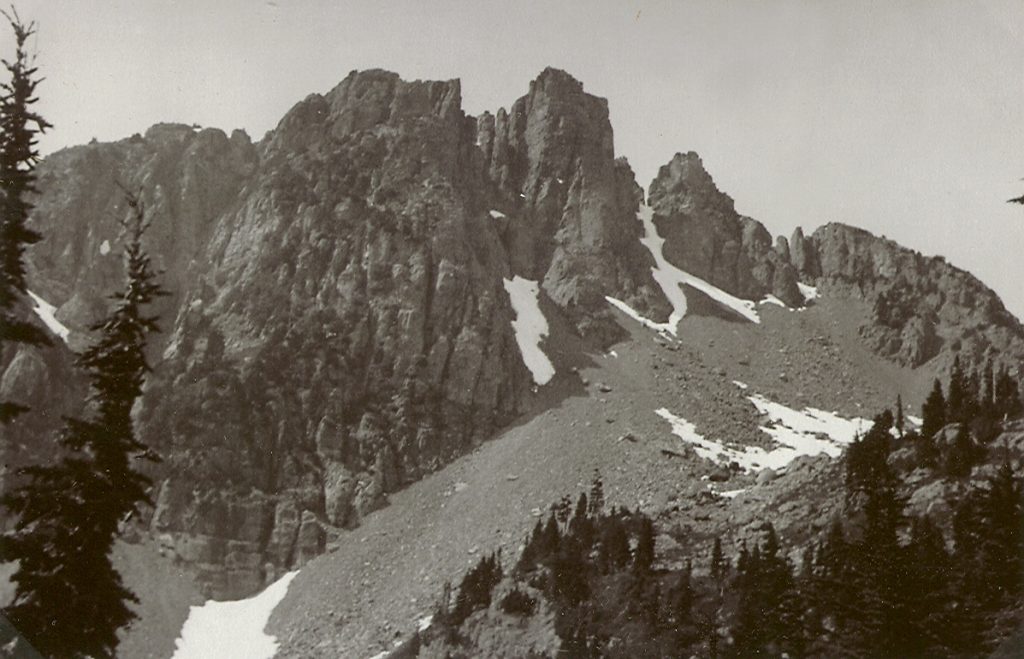
Castlecrag Mountain before the 1946 earthquake.
Local Alpinists Ascend Olympics
Reported in The Victoria Daily Times Thursday September 5, 1946, p.9.
Two groups of local alpinists have returned to the city from rigorous climbing expeditions in the Olympic Mountain Range. One group of the Alpine Club of Canada under Dr. Mark Mitchell attempted the difficult ascent of 8,000-foot Mount Olympus peak on a five-day trip. Dr. Mitchell and Jean Mcdonald were the only members of the party to successful. Others who attempted the climb were Pamela Mitchell and Mr. and Mrs. J. Green. Eleven members of the Outdoor Club of Victoria on a three-day expedition, successfully reached the peaks of 6,000-foot mountains, Boulder Hill and Hurricane Hill of the Olympics. Included in the party were Mr. and Mrs. W. Stenner, Mr. Godon and Mrs. Stephanie Bowes, Mr. and Mrs. Allan Perry, Ruth Sherman, Molly Crickmay, Cyril Jones, Ted Fairhurst and Francis Tuckey.
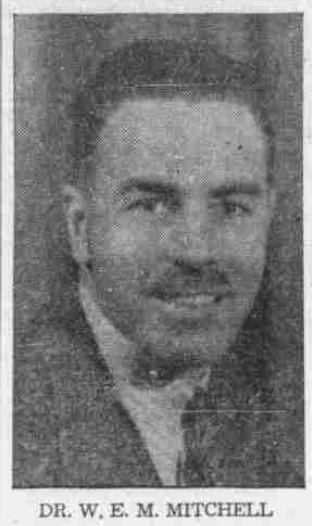
Mark Mitchell
Good Prospects for Skiing
Mountaineering Club Elected Its Officers Last Night
Reported in the Comox Argus Thursday September 19, 1946. p.1.
Prospect for an active skiing season were disclosed at the annual meeting of the Comox District Mountaineering Club held last night at the Parish Hall when forty attended. President Bob McPhee, vice-president S. Strachen, secretary-treasurer, D. Blackburn and an executive and several committees. The report showed a membership of sixty-five with a good financial standing. The cabin will be improved and skiing facilities and it was intimated there might be a tournament. The club is trying to get a section of the hillside above the Lodge from its owner: if they are not successful, they propose to get the aid of the government.
Skiing
Reported in the Comox Argus Thursday October 3, 1946. p.6.
By Alec Linton
Seems a little early to be talking skiing but there’s so damned much activity going on these days at the Becher Cabin that we just had to let you know about it. Last week was bunk carrying day and no less than nine army cots and supports were transported by brute strength to the cabin. Almost forgot the dixies, jugs and mugs that were also lugged up by the girls. The Weatherman had a day off and left the cabin in a cold, damp cloud all day. After a breather for lunch work started on the locker room bunks and six new spring bunks were installed under the able supervision of Bert Chandler. The girls, in the meantime, cleaned up around the kitchen and removed several months supply of ashes from the stove. They also improved the color of the dish towels—a job well done. Bob Gibson and Stan Rushton felled a couple of cedars for our new addition to be commenced next week. We should be able to accommodate some twenty-five members, not bad considering the housing shortage.
Alpine Climbers Had Exciting Trip to Della Falls
Reported in The Victoria Daily Times Monday October 21, 1946, p.11.
Members of the Victoria branch of the Alpine Club of Canada experienced difficulty in returning to their log cabin on a recent expedition to Della Falls and Big Interior Mountain, situated on the outskirts of Strathcona Park. The party, led by Dr. Mark Mitchell, an experienced Alpine climber, was unable to reach shelter before darkness fell. Unable to see, the party had to light a fire and by using its light as a beacon made various attempts to locate their cabin. They finally found it late in the evening. Two women participated in the expedition into the rough mountain country. They were Miss Jean McDonald and Miss Molly Crickmay. The other member was Frances E. Tuckey. Describing the Della Falls district as beautiful, unspoiled country, Dr. Mitchell said a road should be built to Strathcona Park. “It would attract thousands of tourists to the island and the road would pay for itself in no time,” he said.
Annual Meeting of Alpine Club Set for November 22
Reported in The Daily Colonist Sunday November 10, 1946, p.30.
Annual meeting of the Victoria section of the Alpine Club of Canada will be held on November 22 at 8 p.m. in the home of Miss Muriel Aylard, 625 Elliot Street. Dr. W.E. Mark Mitchell will be chairman. A brief description, with slides, will be given of the 41st Annual Camp, held in the Bugaboo Valley last July, when 168 people were present. Dr. Mitchell spent some days at the camp and made some difficult snow and ice climbs. Irene Hudson and other members of the section were also present, when they enjoyed meeting the old timers and other members. The section aims at giving elementary training to young men and women who are attracted to mountain climbing, which can be enjoyed under club facilities at much reduced cost in comparison with ordinary hotels. Details as to suitable boots, equipment and clothes can be supplied. A beautiful sight at the camp was the large white or mountain anemone which was a fortnight later than usual, and covered the high alpine lands above the tree line at the camp in the Bugaboo Valley.
Victoria Alpinists Elect Officers
Reported in The Victoria Daily Times Saturday November 23, 1946, p.15.
Second annual meeting of the re-organized Victoria section of the Alpine Club of Canda was held Friday night at 625 Elliot Street with 20 members and guests present. Newly elected officers are: Chairman, Dr. W.E. Mark Mitchell; honorable secretary and treasurer, Miss Muriel Aylard; members of the executive, Mr. Francis Tuckey, Mrs. Stephanie Bowes, Dr. Irene Bastow Hudson, Miss Jean McDonald, Miss Ethne Gale and Major Frederick V. Longstaff. The chairman reported week-end trips had been made to Mount Baker, Olympics, Mount Arrowsmith and Mount Olympus which is the best trip in the travel range. The last trip was to the head of Great Central Lake to Della Falls and the Big Interior Mountain. The section was represented by 12 active members at the annual camp in the Bugaboo valley. The dates, times and locality of climbs will be announced later. Inquiries should be made to Miss Muriel Aylard, 625 Elliott Street.
Alpine Club
Reported in The Daily Colonist Sunday November 24, 1946, p.3.
Dr. W.E. Mark Mitchell was elected chairman of the Alpine Club, Victoria section, at the second annual meeting held Friday [November 22] night at 625 Elliot Street. Miss Muriel Aylard was elected secretary and treasurer. Named to the executive committee were Mrs. Stephanie Bowes, Dr. Irene Bastow Hudson, Miss Jean K. MacDonald, Miss Ethne Gale and Major Frederick V. Longstaff. After various reports relative to the past year’s activities had been presented, Major Rex Gibson, of Edmonton, showed slides of Lovat’s Scouts being trained in the Rocky Mountains. All interested in activities of the organization have been asked to contact Miss Aylard, 625 Elliot Street.
Skiing On Mt. Becher
Snow Is Just Right at Cabin
Reported in the Comox Argus Thursday December 5, 1946. p.1.
Skiing from Forbidden Plateau has commenced again according to Mr. Alec Linton, skiing representative of the Argus. Members of the Comox District Mountaineering Club have all taken their blades. Twenty were on board the ski special on Sunday. There was eighteen inches of nice powder snow at the Lodge. The new ski lodge at Bald Rock is going to be a great convenience and they are talking about a coffee bar there. There is about five to six feet of snow at Mount Becher. The new wing of the cabin has stood up well under the snow. Skiing round the cabin was tops and fast. The run down the grades from Bald Rock to the Lodge was treacherous and control impossible. The season is now well launched for skiing on Mount Becher.
1947
ACCVI executive:
Chairman – Mark Mitchell
Secretary/Treasurer – Muriel Aylard
Executive Committee – Irene Bastow Hudson, Ethne Gale, Frederick Longstaff, Francis Tuckey, William Heybroek, Stephanie Bowes.
Events:
February 22 – Rex Gibson gave an illustrated slide show of the Yoho Ski Camp.
February 23 – Club trip to Mt. Maxwell, Saltspring Island.
March 31 – Jack Longland, a distinguished member of the Alpine Club and Cambridge Mountaineering Club, gave an account of his trip to the Greenland Ice-cap and the ascent of the highest peak.
March/April – Club members attend the ACC Ski Camp at the Columbia Icefields near Jasper.
April 22 – At the club’s annual banquet Ferris Neave gave an illustrated account of “His Early Climbing Experiences” and General William W. Foster gave a commentary on Mr. S.R. Vallance’s slides of the Glacier Region.
December – Club meeting where executive members were elected. Frederick Longstaff gave an illustrated account of a trip to the Bridge River District.
Section members attended the annual summer camp at Glacier in the Selkirks (July 13 – 26): Bill Lash, Mallory Lash (graduated on Avalanche Mountain), Ethne Gale, Geoffrey Capes (graduated on Eagle Peak), Rex Gibson, Edith Maurice, Mabel Duggan, Mary Cassels, Dr. and Mrs. Joseph Pearce.
Past ACCVI section chairman Horace “Rusty” Westmorland awarded the ACC Silver Rope for leadership.
Forbidden Plateau
Reported in The Daily Colonist Friday January 31, 1947 p.10.
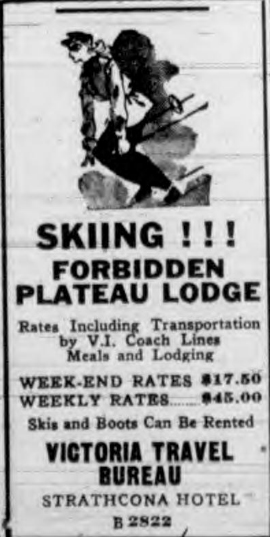
Ad for skiing at Forbidden Plateau Lodge, including meals and lodging. Week-end rates $17.50. Weekly Rates $45.00.
Victoria Hikers Lost on Mt. Becher
Victoria Party of Six Spent Night in Snow Storm on Mountain
Reported in the Comox Argus Wednesday February 6, 1947. p.1.
A Victoria party of five girls and one boy, completely ignorant of conditions at the upper end of the Island, came up from Victoria on Saturday afternoon. They had no skiing gear of any kind and no knowledge of how to look after themselves in the snow. They left Courtenay to walk to the Plateau Lodge, which was blocked off from all communication with the outside. On Saturday night they slept out with no food and no blankets. Two of them staggered in to Courtenay on Monday afternoon. The police were notified and the search was on. Mr. Harry Martin, coming down from the Lodge on skis found the four and they got into Courtenay at three o’clock on Tuesday morning, dazed and bewildered and hungry. However, they are quite alright irrespective of the loss of sleep and they left for Victoria on Tuesday afternoon. The authorities and the management of the Forbidden Plateau Lodge wish to warn young people, who know nothing about winter conditions in the mountains, that they should get local information before they attempt anything so foolhardy again.
Alpine Club Lecture
Reported in The Daily Colonist Friday February 14, 1947, p.17.
The Alpine Club of Victoria has invited the members of the Victoria Outdoor Club on a trip to Mount Maxwell, Salt Spring Island, on February 23, and to a lecture to be given by Major Rex Gibson at the Little Centre on February 23. The speaker will talk on climbing and skiing in the Rockies. It was announced by Stephanie Bowes that the Alpine Club of Canada expects to send about 50 members to Switzerland this Summer. A few Victoria members hope to go.
Will Show Slides
Reported in The Daily Colonist Friday February 21, 1947, p.3.
A display of Kodachrome slides of mountain climbing and skiing will be shown at the Little Centre, 965 Yates Street, tomorrow at 8 p.m. under the auspices of the Victoria Section of the Alpine Club of Canada. Major Rex Gibson, Edmonton, will be the guest speaker during the showing.
Ski Tournament on Mt. Becher
Spring Snow and Fine Course Enjoyed by All
Reported in the Comox Argus Wednesday March 20, 1947. p.1.
In the annuals of the Comox District Mountaineering Club another successful ski tournament can be written up on Sunday afternoon, under ideal weather conditions, a large turnout of ski enthusiasts tried their skill on Mount Becher in the varies events. Everyone was convinced, however, that without the assistance given by Herb Bradley, the local C.D.M.C. instructor, the tournament would not have received the enthusiastic support it did, nor have such enjoyment to all. He is responsible for the fine course laid out and through his encouragement, interest and advice has brought increased skill to any who figured in the novice classes. In fact it was his skiers who took all the prizes in the novice events, a matter of great pride to Herb. Local skiers made a good showing, C.D.M.C. and Alberni Ski Club both participating and showing much interest in the tournament. Three bus loads of skiers and friends left Courtenay and found the snow conditions were favorable spring skiing. The course was laid out on the upper slope at the “top” of Mt. Becher. Eric Laurillard and Gordy Martin, two well-known figures in the skiing world helped conduct the events. Martin opened all the courses. Both men were very impressed with the enthusiasm shown by local skiers and they were also loud in their praise of the excellent skiing abilities. They expressed surprise at the progress made by novice skiers and gave a great deal of credit to Herb Bradley for his fine job of instructing. Eric Laurillard and John Hanson were official timekeepers and Herb Bradley was starter. Alberni skiers took their fair share of honors and prizes are to be presented later when it is going to hold a banquet for this ceremony. The men’s downhill course is five-eighths of a mile long and novice and women’s events are half of the men’s course. Results of the day and winners are:
Men’s Novice: 1. Allen Simpson (CDMC), 59½; Pat Andrews (CDMC)60½.
Women’s Downhill: 1. Doris Sutherland (CDMC) 1:24; Gladys Andrews (CDMC) 1:46.
Women’s Slalom: 1. Gladys Andrews (CDMC) 36; 2, Joyce Driver (ASC) 45.
Men’s Downhill: 1. Bon Green (ASC) 54½; Bob McPhee (CDMC) 59½.
Men’s Slalom: 1. Sid Williams (CDMC) 48; 2, Bon Green (ASC) 50
Novice Slalom: 1. Larry Mitchell (CDMC) 35; Allen Simpson (CDMC) 36.
Educationist to Pay Visit Here
Reported in The Victoria Daily Times Friday March 21, 1947, p.20.
John Longland, educational administrator in England and noted mountain-climber, will be a visitor in Victoria March 31, speaking to several organizations. His visit is part of a speaking tour arranged by the British Ministry of Information. During his stay in Victoria Mr. Longland will address Normal School students in the morning on the new Education Act in England. At noon he will be the luncheon speaker of the Gyro Club on the subject of mountaineering. He will be the dinner guest of the principals of the Greater Victoria school system and conclude his one-day stay by meeting members of the Victoria section of the Alpine Club of Canada.
Attending Ski Camp
Reported in The Victoria Daily Times Monday March 31, 1947, p.8.
Among Victorians attending the 1947 ski camp of the Alpine Club of Canada at Columbia Icefields near Jasper from March 29 to April 7 are Dr. Mark Mitchell, Ethne Gale, Miss Janet Richards, Mr. Dick Georgeson, and Brigadier and Mrs. Bruce Reford. The party left Victoria Thursday evening.
Victoria Ski Enthusiasts at Alpine Camp
Reported in The Victoria Daily Times Saturday April 12, 1947, p.8.
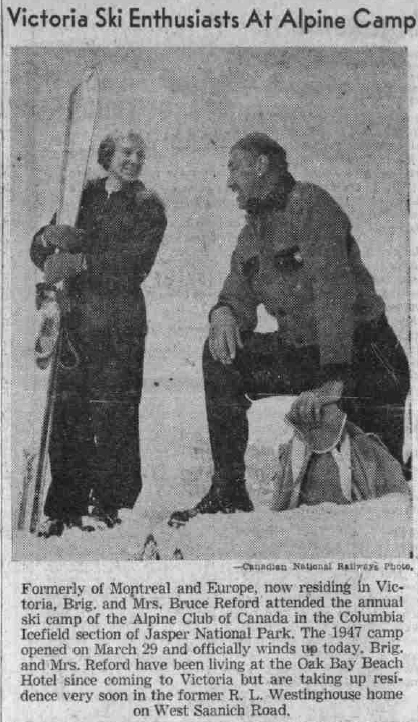
Victoria Ski Enthusiasts At Alpine Camp
Formerly of Montreal and Europe, now residing in Victoria, Brig. and Mrs. Bruce Reford attended the annual ski camp of the Alpine Club of Canada in the Columbia Icefield section of Jasper National Park. The 1947 camp opened on March 29 and officially winds up today. Brig. and Mrs. Reford have been living at the Oak Bay Beach Hotel since coming to Victoria but are taking up residence very soon in the former R. L. Westinghouse home on West Saanich Road. — Canadian National Railways Photo.
Alpine Section Holds Dinner
Reported in The Victoria Daily Times Wednesday April 23, 1947, p.20.
The Victoria section of the Alpine Club of Canada held its annual dinner Tuesday night at the Empress Hotel. The occasion marked the 41st anniversary of the formation of the section. Dr. W.E. Mark Mitchell, who presided, read letters of greeting from Vancouver and Edmonton sections. Ferris Neave, Nanaimo, was guest speaker. He reviewed the outstanding climbs which the group had undertaken during the past 20 years. Dr. Mitchell showed colored slides of the glacial area of the Selkirks, the oldest climbing centre in Canada and where the section plans to hold its annual camp this year. Major-General William W. Foster gave a commentary on the slides shown.
Skiers Meet in Courtenay
83 Attended Banquet in Native Sons’ Hall Last Night
Reported in the Comox Argus Wednesday May 22, 1947. p.1.
Eighty-three people turned out for the banquet of the Comox District Mountaineering Club at the Native Sons Hall last night (Wednesday) and enjoyed themselves immensely. These included twelve members of the Mt. Arrowsmith Ski Club from Port Alberni. The meal was prepared and served by the Canadian Daughters and the fact that they catered is sufficient warrant for its excellence. The banquet opened with a toast to the patron deity of the club, the Indian tribal god of Mt. Becher, Takaschushagain, and Mr. Ad. Clement of Cumberland led the community singing while the tables were being cleared. The presentation of tournament prizes followed along with the Courtenay Recreational Club’s shield to the president of the local club. This shield was given to the club obtaining the most prizes at the tournament. A special award to Mr. Eddie Thompson of an honorary life membership for pioneering the first bus up to the Forbidden Plateau Lodge. His services on that occasion were, the scroll read, “beyond the call of duty” and therefore should be suitably rewarded. Short speeches congratulating the club on the success it had attained came from Mr. Herb Bradley, the C.R.A. director, who has done so much for the skiers this year, Mr. Harry Martin, the proprietor of the Forbidden Plateau Lodge and president of the Mt. Arrowsmith Ski Club, Mr. Bon Green. Movies of the Forbidden Plateau were shown by Mr. Chas. Forest and David Kirk.
Leaving For Alpine Camp
Reported in The Daily Colonist Wednesday July 16, 1947, p.6.
Dr. and Mrs. Joseph A. Pearce will leave on Thursday to attend the annual Alpine Club of Canada camp at Glacier, B.C. Others who left yesterday en route to the camp were Mrs. Fred Maurice, Miss Ethne Gale and Miss Mary Cassels.
Snow Gone from Plateau
Season Much Earlier Than Last Year, Party Reports
Reported in the Comox Argus Wednesday July 17, 1947. p.1.
A party that has just returned from a week’s visit to the Forbidden Plateau says that all the snow has gone from the meadows and as high as Moat Lake, where a year ago there was plenty of it. The road in by Dove Creek, which has been in very bad condition, is now in excellent shape for hiking and there is no danger of getting lost except at one place. Here the Boy Scouts are going to do some blazing. The party climbed Mt. Albert Edward and Castlecrag Mountain and confirm the report that the earthquake did cause many slides. The pinnacle on Castlecrag Mountain has been splintered and the chimney, which was one of the ways to get to the top, is now choked with rock. The cairn at the top of Mt. Albert Edward was disrupted and has been replaced by another. They party says that they almost had the Plateau to themselves.
Remembering the Summer of ‘47
A Native Son Returns to Clear Up A 57-Year Mystery
Reported in The Campbell River Mirror Friday September 3, 2004, p.5.
By Paul Rudan
It isn’t a big mystery but it is a tall tale. At the top of Sayward’s Hkusam Mountain is a cairn. Whie there’s nothing unusual in seeing a man-made stone pile as a landmark, throughout the years many a climber wondered just who erected the cairn. More than half a century later, Joe Antonelli of Campbell River has stepped forward to take the credit. “We were just a bunch of young guys working for B.C. Forest Service in the summer of ’47 and one day we made plans to climb Hkusam Mountain,” said Antonelli, now 84. Antonelli was 27-years old he, his two brothers and four other men were working as tree planters at a camp located between Lower Campbell Lake and the former Loveland Lake. One day in August 1947, the seven men – Joe, Marsh and Ken Antonelli, along with Len Platt, Eddy Glover, Ron Logan, Don Grant and Joe’s dog Pete – headed out to climb the 5,000-foot plus Hkusam Mountain. “There weren’t any trails back then, not like there are today,” chuckled Antonelli. Wearing work shirts, pants and basic shoes, the group headed up the mountain carrying with them a marker Antonelli had specifically made for the day-long journey. It was a destination sign and they built a stone cairn to hold it in place. The arrow-shaped markers on the sign pointed to such places as: North Pole, 2,673 miles; New York, 3,406 miles; Tokyo, 2,631 miles; Hollywood, 1,034 miles; and Courtenay. I made and painted the signs and figured out the approximate mileages and, with a compass, the approximate directions of the destinations,” recalled Antonelli. “When I built the cairn we put a jar in it with all our names inside.” While the destination sign is long gone, the cairn remains and, perhaps, so does the jar that contained the men’s names. Shortly after working at the tree planting camp, Antonelli married and settled in Pemberton where he worked as a ranger with the Forst Service and then went into business for himself. He always intended to return to the Campbell River area and when his wife died, he came back to the Island two-and-a-half years ago. “Since moving back to Campbell River after a 55-year absence, I have talked to several old-timers who said (the cairn) has been a 57-year-old mystery as to who had put that thing up there,” said Antonelli on Wednesday. All the men, with the exception of Logan, are still alive today, said Antonelli, and Grant is a former chief forester of British Columbia. Other than the cairn, the only evidence of their climb in ’47 is a photograph of six of the men gathered around the destination sign – the only person missing is Antonelli. “My regret is not being in the photo myself with the rest of the guys,” he lamented. “I guess the camera I had in those days lacked a self-timer but that’s the way it goes for photographers.”
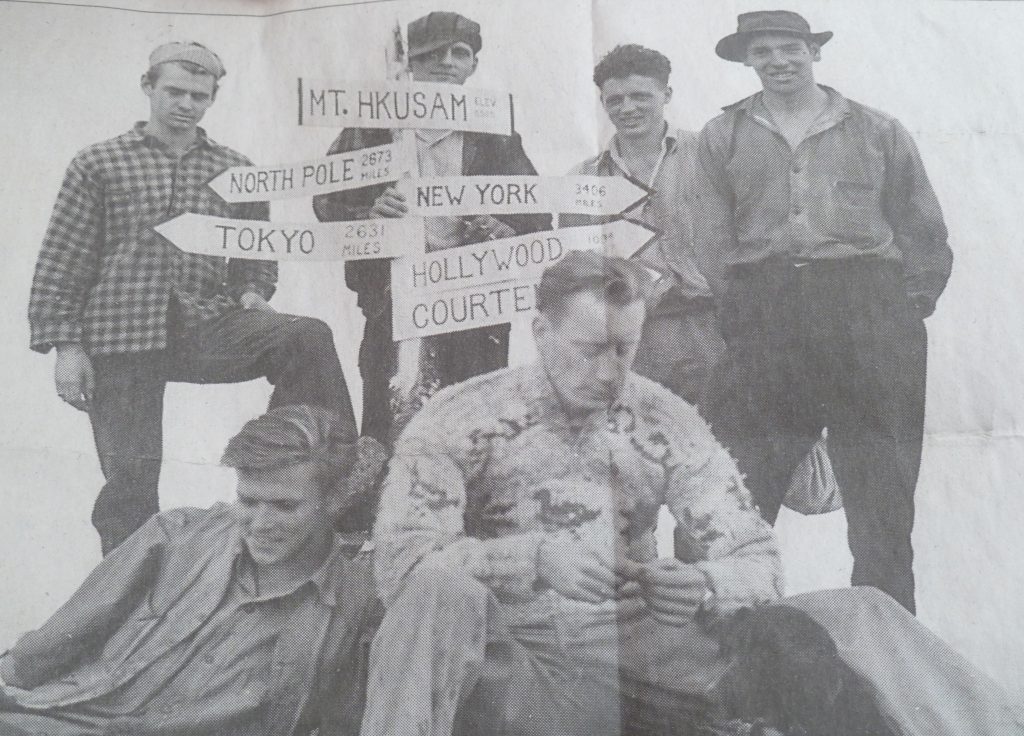
Hkusam 1947
Skiers Get Ready
Mountaineering Club Prepares for Big Season
Reported in the Comox Argus Wednesday September 4, 1947. p.9.
Raring to go in the coming season thirty members of the Comox District Mountaineering Club met last night (Wednesday) in the Boy Scout Hall. They re-elected Bob McPhee as president and other officers were vice-president Mrs. Frances Lloyd-Young, secretary-treasurer, V. Everett, ski-captain Stan Rushton, executive, Messrs. Sid Williams, Mrs. Hobson, Jack Armstrong, Oscar Pettersen and Miss Gladys Skinner. Other committees were formed, dance, cabin and kitchen, with Alec Linton as publicity agent. It is proposed to build a new cabin at the Look-Out, 16 by 30 feet.
Skiing
Reported in the Comox Argus Wednesday September 18, 1947. p.1.
By Alex Linton
The C.D.M.C. went hunting last Sunday morning—for nails—and came back with more spikes than all other hunters combined. These were used liberally in the foundation work and were driven by everyone who could drive — no licences required. Other supplies were delivered right to the site, thanks to the sue of an army truck which made two round trips loaded with lumber. Fortunately, we never have any labor troubles and John Hansen had all the assistance—and advice—he could handle as foreman. We expected Sid Williams would be off the bit having had his teeth out but he was as sharp as ever and came out with some good ones—jokes, not teeth. Next Sunday’s bus (or buses) will leave sharp at 8:00 and we’d like to see all members aboard armed with axes, saws and hammers—and nails. Any prospective members are welcome to come. Be seeing you.
Skiing
Reported in the Comox Argus Wednesday October 30, 1947. p.13.
By Alex Linton
The ski club can relax now and put away those hammers and saws till next fall for our cabin is complete except for a few exterior jobs that can be done anytime or sometime. We are mighty proud of the sixty-five (conservative estimate) who answered the call Sunday and hope they’ll be around plenty this winter to participate in our favorite sport (skiing). Angus McMonnies came out of the bush (or hadn’t you noticed it?) and with a new deck on his truck gave us a hand to transport shakes. Thanks Mac. It saved us a pack. By noon we had the stove roaring (the jokes were that good) and most everyone gathered inside in hopes of getting some coffee that Frances Lloyd-Young had so thoughtfully brought up but the whistle went before we had a chance to wet it. We had five crosscuts in operation and a chain gang was formed to carry the bocks to the woodshed. I never saw so much block passing in my life! A big pile of moss was gathered to fill the chinks but some still insist we should have used rice for that is what they use in China. Iven Aven hung the door and it swung beautifully. I hope some of you members remember to swing it shut! We had to erect an outhouse and Messrs. Clement, Dauncy and yours truly were appointed to the “privy” council. Some members claimed it looked like a Chinese Pagoda but you can rest assured that any similarity was purely “occidental”. Don’t forget gang, our cabin shower next Wednesday night at the Scout Hall so lets really flood the place with useful gifts. Any of you townspeople who would like to contribute something can come along and join the fun. Herb Bradley advises that you should set Tuesday nights aside for his pre-season work outs. Take these settings up exercises now and you won’t fall down so much this winter.
A Solo Trip from Della Falls to the Aureole Snowfield and Back by Ralph Rosseau
From the diary of Ralph Rosseau July 24 to August 5, 1947. Courtesy of Louise Eck (nee Rosseau)
Thursday July 24th
Ralph arrives at Della Falls
Friday July 25th
Takes grub up to Camp 1
Saturday July 26th
S.B. to Camp 2 and back to “7”
Sunday July 27th
To Camp 1 over Septimus
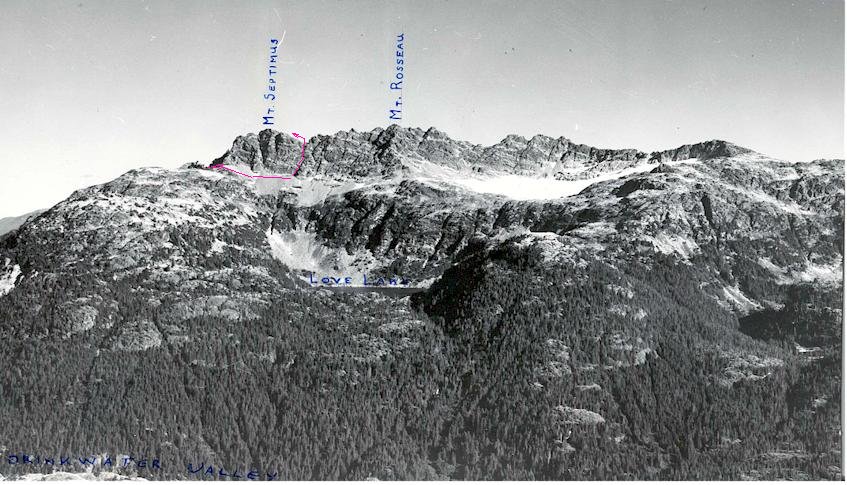
Mount Septimus/Rosseau massif.
Monday July 28th
Weather looks threatening. Down to P.D.Q.* for nails, wire, lumber. Explored mines [Sherwood Mine]. Showers, so hurried back to camp. Rain continues intermittently all day so fired up comfortable camp. Shelter, fireplace, spring. Busy day. Dry under trees. Sky cleared at 5:00. Hurried supper. Left at 6:15 for Camp 2 with pack. Up correct pass on Mount Septimus but could not get down slide on north side. Dangerous. So had to go higher up and down north spur. Hard work with pack. Reached Camp 2 at 9:15. Wonderful spot. Cached grub and started right back. (9:30). Lost route in dark. No flash or candle. Snow hardened so had to cut steps. Feet wet and cold. Startled ptarmigan. White heather showed in dark. Reached summit in wrong place. Moonlight helped difficult descent. Crossed glacier. Hard to find camp. Cloud. Arrived camp 1:00 a.m. Fire. Food. Bed 2:30 a.m.
* P.D.Q. is the name of the mining claim above the Drinkwater Creek near Love Lake. The mine site was known as the Sherwood Mine after W.J. Sherwood who staked the first claim in 1938. In the mid 1940’s Cangold Mining and Exploration Co. Ltd. was incorporated for the purpose of raising money to develop the mine and was actively engaged exploring the property. The company cleared 2700 feet of underground workings. During this period surface crews discovered twelve new veins on the property. In 1946, 18,000 feet of road was constructed from the end of an old logging-grade to a proposed mill-site in the vicinity of the Sherwood mine. At that point Cangold ran out of money and was unable to raise additional funds through the sale of debentures. In result, a mill to be built with production scheduled to start in October 1946 never materialized.
Tuesday July 29th
Awaked at 7:00 by grouse drumming ten feet from shelter. Left Camp 1 for Camp 2 at 9:30 a.m. Heavy pack. Good sky but heavy fogs kept pouring in. Visibility altered constantly. Went to east end of Septimus and spent two hours on pictures at top of glacier. Went around E. Septimus to avoid climb and crossed North West Glacier, keeping low. Reached Camp 2 at 6:00. Too much supper. Kept awake by slides into Iceberg Lake [Green Lake]. Ice constantly breaking off – splashes. Dream synchronized with one slide’s roar. Marvelous campsite. Shelter and view. Plenty of fuel. Water close. Bad night and noises. Too much food.
Wednesday July 30th
Took pictures from vicinity of Camp 2. 10:00 a.m. Started up Flower Ridge with three days rations. Saw three deer. Tried for picture. Left pack at top of ridge and went off for pictures. Doe examining pack when returned. Many ups and downs across divide. Ptarmigan and two chicks. Geology interesting. Camped at 5500 ft. at 6:00 p.m. Took pictures of Tzela Lake, Cliffe Glacier and attempted one of beautiful sunset. Local storm over Elkhorn (?) Beautiful moonlight night. Can see Tzela, Oshinow, Great Central and smaller lakes gleaming. All mountains silhouetted. “Big Three” look formidable. Camped in sheltered depression. Plenty of fuel from dead trees. Pond ten feet away.
Thursday July 31st
Up at seven. Beautiful morning with cumulus clouds. Breakfast. Took pictures. Left camp with full pack at 9:00. Around Mount Harmston to Tzela Pass [between Shepherds Ridge and Tzela Mountain] (5000′)? Up Mount Tzela (6181). Down east side to Cliffe Glacier. Saw three deer. Cougar tracks in snow. Bad rock climbing off Tzela. Circled Harmston to upper Cliffe and crossed Glacier to Milla Pass [between Mount Harmston and Argus Mountain]. Dangerous couloir down to Moving Glacier. Ice. Snow. Loose rock slide. Jumped form ledge to snow below, turning in air to land face down. Slid 30 ft. and checked with axe blade. Shower of snow. Stopped to regain composure. Snow gave way and slid another ten feet. Edged off to rock but pack too wide for bergschrund. Cut steps and worked down in zig zag. Got on rock slide but too dangerous so back on snow. Stopped on ice block unexpectedly, fell back on pack, which tobogganed me down one hundred feet before able to roll over and use axe. Getting worried, so unstrapped one arm from pack and cut steps with one hand. Lost snow glasses somewhere, but to hell with them. Finally reached bottom. Large rocks frozen in ice. Moving Glacier badly crevassed, but in uniform pattern. Chose to traverse part where crevasses visible. Mostly 75 to 100 ft. deep and 2 to 6 ft. wide. Bottom of glacier rutted and cracked and dropping bergs into lake. Pattern of ice floes on lake changes with the wind. Chose point on North shore of lake with marvelous view both ways, water, fuel and shelter. Left pack and climbed ridge to N.E. Full view of Mirren Lake. Back to camp (7:00 p.m.) Enjoyed supper. Wonderful sunset on lake, glacier and mountains. Not a cloud in sky tonight. Moonlight on ice floes.
Friday August 1st
Spent morning exploring and photographing the Moving Glacier. Crossed the crevasses. Climbed down into some. Walked along knife-edge ridges. Broke a snow bride, got trapped on way back. Step-cutting hard work. Crevasses near lake 75-100 ft. deep and have slushy ice floating on bottom. Farther back, same depth but rocky bottom. Run in semi-circular pattern. “White” snow dangerous. One hole ten feet in diameter and one hundred feet deep covered by patch. Interesting study of glaciation. Rocks slide on to glacier. Warmth makes holes. Then frozen in. Carried on and in bergs to far end of lake. Trees ground into soil. Spectacular slide occurred in gully I came down yesterday. Rocks rolled off Harmston in night. Left camp at 11:30 a.m. Took pack to the top of Mirren Pass [between Iceberg Peak and Comox Glacier]. Continued towards Memory Lake with rucksack only. Had to climb around head of several deep gullies. Saw Memory at 2:00 p.m. Beautiful but not spectacular. Not much ice or snow. Climbed Iceberg Peak (6519) from Memory Pass [between Mirren and Memory Lake]. Saw Comox Airport. Down from Iceberg. Crossed upper Aureole Snowfield. One mile to Mount Celeste (6695). Climbed Celeste [high point on Rees Ridge]. Getting tired and had decided to head back when caught glimpse of Ink Lake. Worked over to N.W. spur of Celeste and got beautiful view. 6:00 p.m. but last chance to make Ink Lake, so glissaded, scrambled and ran down N.E. Celeste into Crimson Cauldron. Bottom of cauldron frozen lake with piles of moraine floating on ice rafts. Crossed low divide between Cauldron and Ink. Beautiful view of N. end. Glacial flood plain. Two magnificent waterfalls. Small patch of trees. Meadow. Fine campsite. Gets setting sun. 7:30. Eight hours from camp! Decided to go as far as I could then build fire and sit out. Not as tired now as was on top of Celeste. Climbed around E. wall of Cauldron, up giant fissure with waterfall on one side. Great pictures but too dark. Along “goat ledge” to pass between Cauldron and Aureole Snowfield. Tried to photo sunset from pass. (1/25 – 4.5 Meter reg. 50-75). Crossed Aureole Snowfield in twilight. Dips over to Memory Lake. Full view of Comox Valley. Lights. Took 1hr. to cross 1 and ½ miles. Round scree on S, Iceberg and down to Rees Ridge. Devilish mess of scree, gullies, etc. Moon up now. Beautiful panorama. Down Rees Ridge to Mirren Pass. Arrived at pack at 11:30 p.m. No supper. Found campsite and turned in. Ptarmigan on Rees Ridge. Deer in Aureole Snowfields.
Saturday August 2nd
Worried about route out of Milla Basin. Can’t get up to pass. Had swim in natural bathtub at campsite. Left campsite at 9:30. Up north wall towards Comox Glacier. Not as bad as appeared. On top of Glacier Peak (6440) by noon. Traversed upper glacier to south peak. Mist rising from snow. Wonderful view. Back across glacier to Argus Mountain. Hoped to get around N. side to Cliffe Glacier but blocked by deep canyon. Had to climb Argus with pack. Up N. col – bad ice and rock – stuck in bergschrund with pack. Reached depression between two peaks. Left pack there and went to top of higher peak (6542). Ptarmigan (friendly). Only route off peak down S. side so had to go back for pack. Over peak and off Argus across Cliffe Glacier to base of The Red Pillar. No apparent route up. 8:00 o’clock so decided to camp on ledge. Changed mind and made for top. Difficult climb complicated by pack. Reached top at 9:45. Half bare rock and half snow covered. Unpacking when “attacked” by mother ptarmigan. Looked huge in twilight. Slipped down snow bank. Kept me under observation. No fuel except heather which burned poorly, but warmed up some soup. Made T.P. shelter with pack-board and rocks. Wind howling. Cold. Slept with all clothes and mitts on. Moonlight.
Sunday August 3rd
Up at 7:00 Birds (swallows?) feeding on dead mosquitoes on snow. Took pictures, some on Infra-Red. Searched for fuel and water. Few dead heather roots and juniper. Found trickle of water from snow. Used T.P. for fuel and made breakfast. Clouds blew in, ruining photography. Looked like a storm so packed in hurry and started down. Tried better looking route. Got nearly to bottom and came to straight cliff. No alternative but to climb back up. Took nearly same route as down. Tough with pack. About 3 and ½ hours getting down. Went down to Tzela Lake. – Deer – Duck and family. Around Tzela to south and west sides. Beautiful meadows with glacial streams. Profusion of flowers. Red Pillar meadows. “The Reaper”. Dense woods. Left Tzela at 5:30 very tired. Climbed 2000 ft. to Skyline route. Passed former camp at 7:00. Over Skyline to Camp 2. Up Flower Ridge in dark, then waited for moon. Down S. side by moonlight. Some difficulty. Reached Camp 2 at 11:30. Too tired to eat so went right to bed.
Monday August 4th
Up early. Big breakfast from cached food. Boots playing out – me too. Made good cache, then up Septimus. Waited on top for sun to break through. No luck, so down Rusty pass across Septimus Glacier to Camp 1. Noticed big difference in snow on way back. Took down and cached shelter at Camp 1. Down to P.D.Q. and Cangold Trail. Left pack and went up to Cangold to return borrowed items. Back down to Della cabin [Joe Drinkwater’s] at waterfall. Arrived 9:15. Too tired to light Coleman. Just crawled in.
Tuesday August 5th
Up at 7:00. Breakfast. Shave. Cache. Cleaned up cabin. Put in wood. Down to Great Central Lake. Time 2:35. Paddy Burke’s boat there but no Paddy. Had swim. Paddy, sister and brother-in-law arrived with kicker. Troubles all over now.

Ralph Hilton Rosseau.
Postscript:
By Lindsay Elms
It is not known the exact route that Ralph Rosseau took from Love Lake when crossing the ridge of Mount Septimus, but this is most likely the first ascent of the mountain. If he had crossed further along the ridge between Mount Rosseau and the Misthorns he would have descended into Price Pass, but it appears that after climbing Mount Septimus he descended the glacier to Green Lake. It can’t be confirmed that his was the first ascent of Tzela Mountain as this could possibly have been made by surveyors in the 1930’s, however, his climb of Argus Mountain was the first ascent – two years before Bill and Alec Bell claimed the first ascent in 1949. Both Iceberg Peak and Mount Celeste (Rees Ridge) had been previously climbed in 1922 by a party from Cumberland including George Kinney, Harold “Bing” Banks, James Tremlett and Alfred McNevin. The Red Pillar was first climbed in 1931 by a party from Courtenay that included Ben Hughes, Adrian Paul, Arthur Leighton and Jack Gregson. Rosseau’s trip in 1947 was an incredible achievement at the time considering it was undertaken solo, but also by the distance that he travelled each day where there were no trails. Most days he was moving for more than twelve hours and usually late into the evening where he arrived in camp sometimes too worn out to cook any supper. It is an amazing journey which demonstrates his incredible stamina but also his keenness to explore and photograph the remote regions of Strathcona Park.
Art Group Admires Mountain Scenery
Reported in The Victoria Daily Times Friday November 28, 1947, p.16.
PORT ALBERNI—Members of the Alberni Valley Art Group expressed amazement at the wonder of Vancouver Island mountain scenery after viewing photographs taken by Ralph Rosseau on a mountaineering expedition from Della Lake to Comox. Some felt the glaciers, lakes, Alpine meadows and wild flowers photographed over about 50 miles of country equal even those of the Rockies in beauty. A seasoned mountaineer, Mr. Rosseau showed pictures taken as he traveled from Mount Septimus to The Red Pillar, from Mount Harmston and Argus to Mount Celeste and the Forbidden Plateau.
Cruikshank Canyon
Reported in The Daily Colonist Thursday December 11, 1947, p.22.
![Top photograph shows Cruickshank Canyon at edge of Forbidden Plateau, eight miles west of Courtenay. Plateau has elevation of more than 4,000 feet, and is reached by roads and trails. Hairtrigger Lake, in lower view, is one of many picturesque bodies of water in area. Indians called the 100 square miles of tableland “Hiyu Cultus Allah,” which actually mean Forbidden Plateau. According to legends, it was once inhabitated [sic] by a race of tall, hairy Indians, who threw intruders over Cruickshank Canyon. Coast Indians kept clear of plateau because of red snow, caused by minute form of plant life.](https://accvi.ca/wp-content/uploads/1947_dec_11_p22_canyon.jpg)
Top photograph shows Cruickshank Canyon at edge of Forbidden Plateau, eight miles west of Courtenay. Plateau has elevation of more than 4,000 feet, and is reached by roads and trails. Hairtrigger Lake, in lower view, is one of many picturesque bodies of water in area. Indians called the 100 square miles of tableland “Hiyu Cultus Allah,” which actually mean Forbidden Plateau. According to legends, it was once inhabitated [sic] by a race of tall, hairy Indians, who threw intruders over Cruickshank Canyon. Coast Indians kept clear of plateau because of red snow, caused by minute form of plant life.
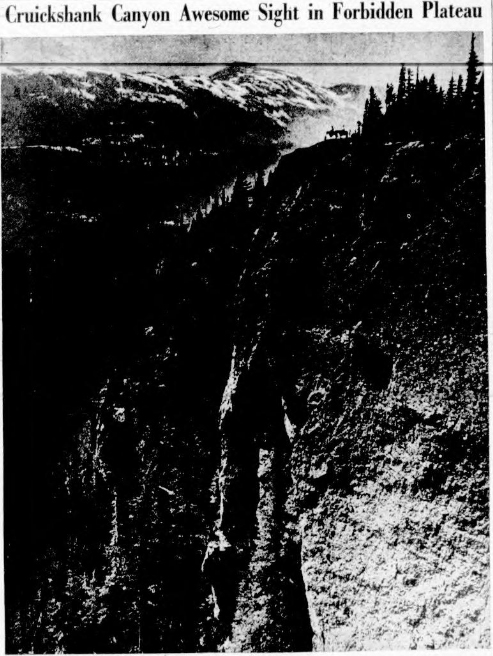
Cruickshank Canyon Awesome Sight in Forbidden Plateau
Zeballos Peak
By Walter (Red) Moffat
In 1947, the mountain that stood out for all employees at the Privateer Gold Mine was called Mount Zeballos. The peak was clearly visible from the road near the Recreation Hall. Its proper name may be Zeballos Peak, and it may be a part of the Rugged Range, but we were mine workers, not mountain climbers or naturalists, and we knew it as Mount Zeballos. Some of us thought that the peak we could see just begged to be climbed. That spring, we got at least two months of continuous rain. Not pouring down rain, but the steady drizzle that kept up day after day. After that there was another two months or so of on-again rain, so it was well into summer before I could do anything about climbing that mountain. While I was waiting, I asked questions. How far was it? How do you get there? What else was up that way? There were more questions than answers. To get close to it the road went past the Privateer and the Central Zeballos and on to the Homeward Mine. I did get a chance to walk the road as far as the Homeward on a decent Sunday for exploring. It was about four or five miles from the Privateer. Not much there, and it was obviously too far to the right. Next week I would do better. The next decent Sunday (we worked six days a week) I went past the Central Zeballos to where I could see the river from the road. This was Nomash Creek, just before it met the Zeballos River. It was shallow enough to wade across. On the other side of the creek, there was supposed to be a blazed trail to Zeballos Lake, which was at the foot of the mountain. I found the trail then lost it, and then I got lost. It should be remembered that this was before the logging got started in that valley. By the time I found myself again, the day was shot. The following week I found the trail and the lake, it wasn’t easy but I didn’t get lost. The distance from the Privateer was probably about five miles. I had a swim, ate my lunch and headed back. Now, who was I going to talk into climbing that mountain? Even I wasn’t foolish enough to do it on my own. I didn’t know the accountant, Bill McDermot very well, he was married so he didn’t live in the bunkhouse or eat in the cookhouse. When talking about Zeballos Lake and how I got there, Bill showed a fair amount of interest, and asked if I would show him the way to the lake. I asked when? He wanted to go on the following Saturday. I couldn’t go on that Saturday. By that time, I was the assayer at the mine and my own boss, but I had work to do that had to be done. We compromised, I drew him a map and I would leave as soon as I could on Saturday afternoon, and meet him and the manager’s son, Wilf Hewat, at the lake. The next Saturday I started early, worked hard and was able to get away from camp just after 1 p.m. (I skipped lunch as well). I went up that road at a good clip and was on the blazed trail by about 2:30. Not far up the trail I ran into Bill and Wilf, they had gotten lost and had only just got back to the trail. They were packing a lot of stuff that I hadn’t bothered with; sleeping bags, food and utensils. I had food and a blanket (I was young and foolish in those days). We made the lake and they were beat. I went for a swim. I didn’t realize that Bill had a camera and took a few pictures of me, in the buff; the pictures showed up in camp a few weeks later! I don’t remember the other two swimming. We decided to try the climb on the Labour Day weekend, so we went back to the mine after lunch. Bill and I left the mine camp just after breakfast on the Sunday [August 31]. Wilf backed out. We had our lunch at the lake, and then looked for a good place to start up. We found a good place and started to climb. It was not a hard climb and we took our time. I had never climbed a mountain before and Bill was out of shape. There were problems with the underbrush at first, and then it got a bit steep in places. Right near the top it was more difficult, but we made it. Wow! The view was terrific! We could look down on Zeballos Lake and I took one picture showing the shadow of the mountain on the lake. We took other pictures showing each of us with a cairn we built at the peak. We also left our names and the date in a can for somebody else to find later. I was surprised to find that we were not up as high as some of the peaks on the other side of the lake. That was the Rugged [Haihte] Range, and a couple of its peaks are about 1,000 feet taller than the one we were on. We later found out that Mount Zeballos was only about 5,100 ft., and the ones across the lake were over 6,100 ft. None of those peaks stood out as well as the one we were on, and they looked further away as well. I think we picked the right peak to climb. Darkness came suddenly. There was no way we were going down that mountain in the dark. We had food but no water. Bill thought I had the water and I thought he had it; I think I was the one to make that goof. It did cool down considerably, and there was a breeze on the peak, so we dropped down below the peak. There was no flat space to lie flat and we had not brought a blanket. We were thirsty, cold and miserable. It was a long night and we were both glad to see the dawn. We went up again for another look around before the final decent. What a breathtaking sight it was, with the sun just coming up and everything below in the shadows! I had always thought that climbing down a mountain was the easy part. Don’t believe it! We had to be careful or we would be going straight down. It was hard to pick the best path to follow. Coming up we could look ahead and pick the best way, going down we couldn’t choose as well, but we made it with no accidents! It was still fairly early in the day so we drank about a gallon of water each and climbed into our blankets for a few hours. We started home after we ate our lunch. The weather had turned cloudy and cool. I am glad we had such perfect weather for the climb. It was slow going back to the mine. Bill’s knee was acting up and he was hobbling a bit before we got back. I was beat. The climb had taken a lot out of me. We were both quiet and thoughtful on the trip back. I don’t know what he was thinking, but we had been as close to nature as you can get, and that can make you contemplate as to who you are and where you were going to live. Those thoughts only stayed with me for a few days but they came back to me many times in the years that followed. I still remember that climb and my first time looking down from the “Top of the World!”
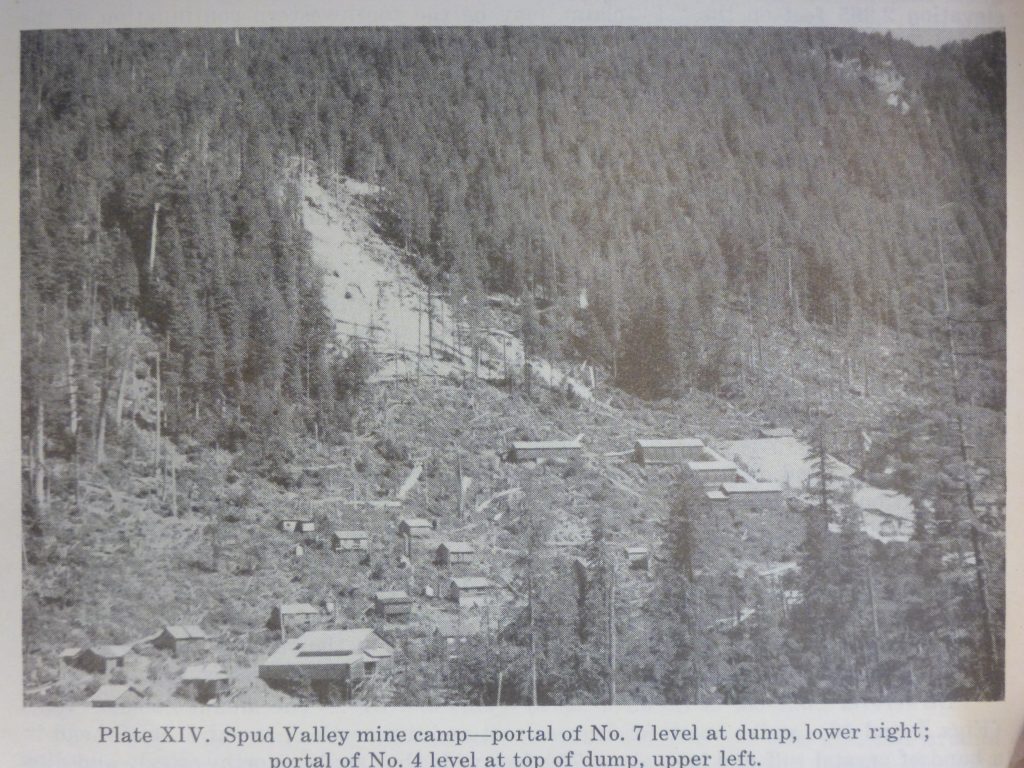
Spud Valley mine camp-portal of No. 7 level at dump, lower right; portal of No. 4 level at the top of dump, upper left.

A view up Spud Creek showing Privateer Camp.
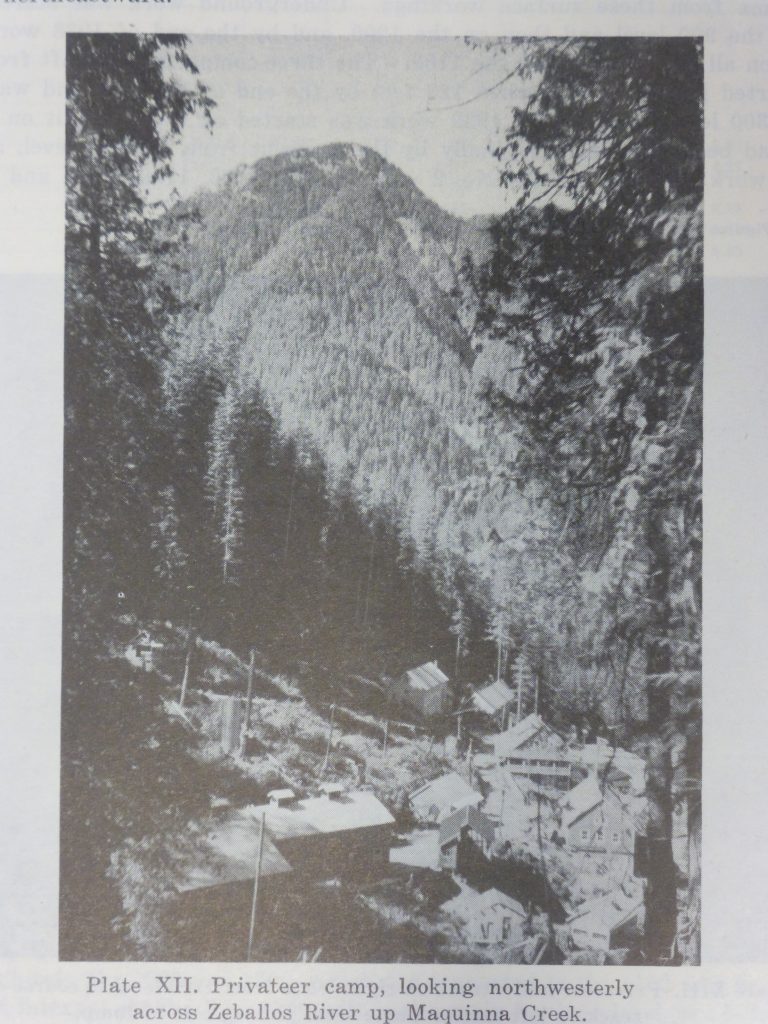
Privateer camp, looking northwesterly across Zeballos River up Maquinna Creek.
1948
ACCVI executive:
Chairman – Mark Mitchell
Secretary/Treasurer – Muriel Aylard
Executive Committee – Irene Bastow Hudson, Ethne Gale, Frederick Longstaff, Francis Tuckey, William Heybroek.
Events:
February – Rex Gibson gave an illustrated talk on an expedition to the Lloyd George Group of mountains in Northern British Columbia.
March – At the club’s annual banquet the special guests were Don and Phyliss Munday and Reverend George Kinney. Don Munday showed slides of the Coast Mountains.
June – Ethne Gale and Rex Gibson were married.
October – Club annual meeting was held at the home of Dorothea Hay. After the election of officers, Reverend George Kinney showed sketches and slides of his mountaineering adventures, as an accompaniment to his account of “Mountaineering in the Canadian Rockies.”
December – A club meeting at the home of Muriel and Aileen Aylard. Rex Gibson showed slides of his trip to Britain and of Peyto Lake Camp.
Local climbs were undertaken with occasional weekend climbing and ski trips to the Olympic and Cascade Mountains in Washington state.
Section members who attended the ACC general summer camp at Peyto Lake July 11 to July 30: Aileen Aylard, Muriel Aylard, Connie Bonner, Geoffrey Capes, Mabel Duggan (graduated on Mistaya), Ethne Gibson, Rex Gibson, William Heybroek, Dorothea Hay, Bill Lash, Mallory Lash, Sylvia Lash (graduated on Mistaya), Dorothy Lash, Pamela Mitchell, Mark Mitchell, Frederick Longstaff.
Fine Skiing on Mt. Becher
Four Feet of Powder Snow at Lodge Now
Reported in the Comox Argus Wednesday January 8, 1948. p.1.
Neither of the regular reports for the ski column were up the mountain last week-end, but if they had they would have seen that two bus loads went up and that there weas excellent skiing right around the Lodge itself. There was four feet of powder snow and most of the skiers stayed there. There were some pioneers who broke their trail through to Becher but they were the exception: the majority tried their turns round the Lodge with herb Bradley as instructor. The C.R.A. snowball special proved very popular. There will be a special Saturday morning ski bus for all children under 16 leaving at 9 a.m. to return at 4:30. For reservations phone 329-X.
Ski Tourney on Plateau
Tournament Next Sunday
Reported in the Comox Argus Wednesday January 15, 1948. p.1.
The Comox District Mountaineering Club in holding a club tournament at the timberline just above the Forbidden Plateau Lodge on Sunday January 18th to start at 11 a.m. The programme will start with the senior men’s downhill, followed by the novice and then 1st year skiers’ downhill. Ladies’ events will be run concurrently and in the same order. Slalom events will start at 2:30 p.m. and will run in the same order as the above. All the events will start at the timberline and the downhill races will finish in front of the Lodge, while the slalom will finish at the bottom of the new run. There are no entry forms and the draw for the starting positions and grading will be made immediately before each event. All club members are asked to turn out and make this first monthly tournament a success. Skiers wishing to take the 7 o’clock bus are asked to pick up their tickets before Saturday night.
250 Skiers on Plateau
Reported in the Comox Argus Wednesday January 22, 1948. p.1 & 4.
All skiers converged on Courtenay and the Plateau slopes on Sunday. While fog veiled the view on the coast it was sunshine and blue skies up at the Lodge. News of the wonderful skiing conditions had gone abroad far and wide and two hundred and fifty people made their way up the road to the Lodge and the ski run above the timberline. One bus load came from Campbell River, and one from Victoria and four from Courtenay. In addition to the buses fifteen cars drove up to the Lodge and on Sunday morning it seemed that ski poles and skis were sticking out of the sides of every other car on Courtenay streets. The ski run above the Lodge is 250 yards long and is where the crowd congregated but there was plenty of opportunity for beginners to try their skis anywhere around the Lodge itself as there is six feet of snow there now. The monthly ski tournament of the Comox District Mountaineering Club was held on Sunday in a blaze of sunshine at the timberline on Mt. Becher.
Results of the races were as follows:
Men’s Downhill: 1st Bob McPhee, 1 min. 21 sec., 2nd George Hobson, 1 min. 22 sec., 3rd, Sid Williams, 1 min. 23½ sec.
Ladies Downhill: 1st Gladys Andrews, 2 min. 3 sec., 2nd, Irene Andrews, 2 min. 22 sec., 3rd, Maude Hobson, 2 min. 37½ sec.
Men’s Novice Downhill: 1st. Alan Simpson, 1 min. 25 sec., 2nd. Robert Gordon, 1 min. 29.5 sec., 3rd. John Hoglo, 1 min. 30 sec.
Ladies’ Novice Downhill: 1st. Doris McQuillan, 2 min. 10 sec., 2nd. Joan Lloyd, 2 min. 16 sec., 3rd. Bev Geidt, 2 min. 23 sec.
First Year Men’s Downhill: 1st. Robert Kirk, 1 min. 33 sec., 2nd Ted Tronson, 1 min. 34 sec., 3rd. Doc Temeroy, 2 min. 30 sec.
Men’s Slalom: 1st. M. Dudley, 32 sec., 2nd. George Hobson, 33 sec., 3rd. M. Belcher, 36.1 sec.
Senior Ladies’ Slalom: 1st. Gladys Andrews, 41.8 sec., 2nd. Maudie Hobson, 1 min. 30 sec.
Men’s Novice Slalom: 1st. Larry Mitchell, 22.6 sec., 2nd. Fred Blackburn, 27.4 sec., 3rd. Alan Simpson, 27.7 sec.
Too Much Snow Even for Skiers
Thirty Feet at Becher cabin and Nine at Lodge
Reported in the Comox Argus Wednesday February 18, 1948. p.1.
There was too much snow last week-end in the hills even for skiers. Two Vancouver Island Coach Line buses are stuck up on the road to the Forbidden Plateau Lodge, where there is nine to ten feet of snow. The rear axle was broken and the bus is blocking the road. The other bus is farther up and so cannot get out ither. The drivers staying up there also. The skiers had a pretty miserable time too. Some of them went as far as the first switchback at the Brown’s River turn and had to get out there and ski up. They got a lift in a car but that got stuck also and they had to come down again. Some other skiers made the Lodge but the snow was too soft for good skiing. Three Courtenay boys had a grueling trip when they set out on Wednesday to go to Mt. Becher cabin to cut wood. They were Dick Downey, Angus Strachan and Roy Carlson. It took them five hours of the first day to get to the first cabin and the second day they made Becher. When they got there it took them hours to dig down to the door and get it open but it was mighty cozy once they got inside. They claim that there is thirty feet at the cabin and of course, it does not show all. They came back Saturday. The fall of snow dimmed any hope of the loggers at the Tsolum operation going to work and the miners strike held up a hundred men who wanted to set logs out in Comox Lake. The B.C. Telephone Co. gang have been out all the day and night putting up lines after the soft snow of Monday night. Many lines were down to Cumberland and all through the district. The south-easter of last night is taking the snow away fast. Owing to the heavy rains of yesterday, traffic was delayed. The E. & N. train got through to Courtenay at 8:25 owing to a mud slide at Nanoose and the afternoon stage was one hour later. Later in the evening the approach to the temporary bridge was barricaded off by the highway gang as it was considered dangerous for traffic. The night stage did not get through. This morning the flood had gone down and the road was open. The Alberni highway is still closed and likely to be for a day or two.
Snow Blocks Plateau Road
All Skiing Has Ceased. Protest to Government
Reported in the Comox Argus Wednesday February 25, 1948. p.1.
The road to Forbidden Plateau Lodge and the skiing grounds is still blocked with snow and all activity has ceased. Three feet of fresh snow fell after the bulldozer opened it up two weeks ago. The Comox District Mountaineering Club and the Forbidden Plateau Ski Club are joining with the Courtenay Board of Trade to induce the Provincial Government to have the road opened. The following brief has been presented to Mr. H.J. Welch and the Department of Public Works Victoria. At a combined meeting of the Comox District Mountaineering Club and the Forbidden Plateau Ski Club executives, the following resolution was passed.
WHEREAS the “Forbidden Plateau” is recognized as the only accessible area on Vancouver Island catering to summer and winter activities;
AND WHEREAS it is the only area that has excellent skiing facilities for five months of the year; AND WHEREAS skiing is recognized as the fastest growing sport on the American continent, having developed locally to date at the rate of eleven times that of 1945, in that this season alone five hundred outside visitors and twelve hundred local people have participated from December 25th to February 15th. This sport draws people from the entire Pacific North West are and regular week-end bookings have been made for the entire season;
AND WHEREAS this attraction and continuance of same definitely depends on the road being maintained in a passable condition;
AND WHEREAS present bookings are being cancelled because of road closure due to the snow falls;
AND WHEREAS if immediate action is not taken to remedy this situation a tourist attraction with unlimited possibilities will receive a set back that will take several years to rebuild with consequent loss of Canadian and American dollars;
AND WHEREAS this is considered an emergency in that the area is completely blocked off, although the local Public Works Department has made a definite effort to open it with its available equipment and funds;
BE IT RESOLVED that the Minister of Public Works for the Province of British Columbia be urgently requested to cause the “Forbidden Plateau” Road to be opened and kept open so that the present tourist business may be maintained and developed for the future.
Thrills And Spills on Local Hills
Reported in the Comox Argus Wednesday March 10, 1948. p.12.
By Rosie Muir
Howdy strangers! I’m afraid the old ski column has taken a beating these last few weeks—however, one of these days it will be back to normal (?). What an over statement. This week’s effort is a bit feeble—even the news is secondhand—but it’s hard to get a bargain at any price these days. A little serious thought is in order before starting on the usual line of nonsense. As you all know the C.D.M.C. sent a letter to the “powers that be” in Victoria requesting that something be done about the road up to the Lodge. According to reliable sources a ‘cat’ was a-rolling up the hill within on hour after the receipt of our letter. Thanks to the fine co-operation on the part of Mr. Welch and the Public Works Department. Not only was the road opened in a hurry—but a good job was done it. That’s the way we like to get things done—and our appreciation is extended wholeheartedly to all concerned. This week-end a crowd went up on Saturday night and stayed at the Lodge. They arrived about 11 p.m. all set for action. In the traditional manner of the ski club the fun began. Musical instruments were brought to light and singing and dancing continued until “lights out”. They even had their “corn” popped, thanks to “Skinny”—most times you have to take it as it comes—don’t you? Be skiing you!
Death of Fanny Bay Pioneer
Mr. F.J. Curran Died in Port Alberni Last Week
Reported in the Comox Argus Wednesday March 31, 1948. p.1.
Mr. Frederick Johnson Curran of Fanny Bay, who came to Cumberland 53 years ago and to Fanny Bay in 1903, died at the home of his daughter in Port Alberni last week in his 85th year. He was born in Providence, Rhode Island, USA and he came to Cumberland as a miner in the early days. He took up a homestead at Fanny Bay in 1903 and lived there until his death. He was visiting his daughter, Mrs. Gordan Campbell in Port Alberni when he was taken ill and passed away. Before he came to Cumberland he worked for some time in New Westminster and he well remembered the Great Fire in Vancouver in 1884 when most of Gastown was destroyed. He was married in Nanaimo in 1890.
Postscript:
By Lindsay Elms
Mount Curran was officially adopted 2 June 1949 and was named after Mr. Frederick Johnson Curran of Fanny Bay, an old-time resident of the area who was also a captain in the PCMR’s. (Pacific Coast Militia Rangers – Experienced men such as loggers, trappers, prospectors and ranchers were sought for this distinctive role. These men had knowledge of the local topography and terrain. Those who were close to populated centers were trained and employed at a local Ranger Training Camp in intelligence duties and local defense against minor raids. They were also instructed in tactical situations that included observation, especially coast watching against the possible Japanese invasion, anti-sabotage measures and protection of lines of communication and transportation. As these newly formed companies of PCMR were so geographically spread out, many could not attend a training camp.)
Plan Ski Contest at Mount Becher
Reported in The Daily Colonist Sunday April 11, 1948 p.15.
COURTENAY, April 10—Vancouver Island Ski championships will be held on the slopes of Mount Becher by the Forbidden Plateau Ski Club. Events scheduled are men’s and women’s slalom and downhill contests. Silver trophies will be presented to the winners. Skiers from Campbell River, Port Alberni, Nanaimo and Victoria, as well as a contingent from the Royal Roads College are expected. In novice races held recently on the timberline hill above Forbidden Plateau Lodge, Beverly Geldt and Phyllis Pritchard placed first from the ladies’ slalom and downhill events. Miss Pritchard and Frances Lloyd-Young placed second and third in the slalom, while Georgina Bunbury and Beverly Geldt were second and third in the downhill. Keith Morton, Frank Stapley and Earl Woods placed in the novice men’s slalom, while Frank Stapley, Morris Beck and Harry Squire placed one-two-three in the men’s downhill event.
Mountaineering Club Banquet
Eighty Sat Down to Excellent Dinner on Wednesday Night
Reported in the Comox Argus Wednesday June 2, 1948. p.8.
The Comox District Mountaineering Club held its second annual banquet at the Native Sons Hall last Wednesday evening with eighty members and guests present. Specially invited guests for the occasion included Mr. Jack Pratt of Vancouver, who came over to open courses for the Mount Becher tournament in April, and the Victoria Royal Roads Navy students who took all the men’s prizes in the tournament. After a toast in apple juice to Takaschushagan, the skiers’ patron saint, the guests sat down to a delicious meal prepared by the Canadian Daughters. Table decorations were the cause of much comment and amusement. In addition to low bowls of lovely flowers there were tiny replicas of this year’s new log cabin, a picture of which has also been chosen to decorate the paper napkins. Tiny skiers made from pipe cleaners and representing members of the club careened down the white table cloth between slalom flags, and there was a miniature lodge and bus. Edible decorations were provided in the way of snow-covered marshmallow trees. After a rousing sing-a-long led by Mr. Sid Williams, President Bob McPhee gave a brief resume of the club’s activities during the past season—the building the new cabin, the new ski path, and the local tournament. Several get togethers had been enjoyed, the ski dance was great success and they had won the C.R.A. trophy for their skit.
An Up and Down Road
He said special thanks were due to the many outside friends of the club and to Mr. Fred Balmer and the Coach Lines and drivers—true they had had ups and downs with the Bus Lines but a mountain trip is mostly ups and downs anyway. The heavy February snow falls had created difficulties but the Board of Trade and Department of Public Works had done everything possible. Others in the line for thanks were Messrs. Bert Marriott and Jim Crockett for the sue of their trucks, Herb Bradley, Sid Williams and the C.R.A. A new plan is to be discussed at the June meeting whereby the work in the future will be more evenly distributed and those not able to go up in work trips will contribute more in dues.
Life Memberships
Called upon to present Honorary Life Memberships to Captain Hargood-Ash and Mr. Bert Chandler. Mr. Sid Williams said some folks were too soon old and too late smart, but there were two who never grew old and were always smart, and because of their spirit of good sportsmanship and willingness to help others the club was pleased to honor these two members in this way. In expressing his thanks Captain Ash remarked on the progress made by the skiers—they even fell down more gracefully!—and Mr. Chandler recalled that some of his happiest times had been spent at Becher. Mr. Chambers and Mr. Haymer, new managers of the Forbidden Plateau Lodge, were introduced, and Mr. Bob McAllister, on behalf of the Royal Roads students thanked the Club for their hospitality at the banquet and at the tournament. Presentations of the C.R.A. shield was made to Mr. Ad Clement, and Mr. Bob Gibson received a token of appreciation from the cast of the skit.
Trophies Presented
Silver cups and trophies were presented by Herb Bradley as follows:
Vancouver Island Championships:
Ladies’ silver cup donated by Central Builders: Gladys Andrews. Silver spoon: Irene Andrews.
Men’s Slalom silver cup donated by Seale’s Shoes: Bob McAllister, Royal Roads student, Victoria. Silver spoon: Walter Tilden, also of Victoria.
Ladies’ Downhill silver cup donated by Peter’s Sporting Goods: Gladys Andrews. Silver spoon: Doris McQuillan.
Men’s Downhill silver cup donated by Cumberland Drug: Bob McAllister. Silver spoon: Walter Tilden.
Forbidden Plateau Kandahar, C.R.A. trophy: Robert Gordon (age 14).
The Comox District Mountaineering Club trophies for annual competition for combined Slalom and Downhill winners were won by Gladys Andrews and Bob McAllister. Mr. Herb Bradley said he hoped there would be more and keener competition next year. He thanked those who helped in giving ski lessons as the number grew. Mr. Jack Pratt, the class ‘A’ skier from Vancouver and holder of numerous ski titles, praised the enthusiasm of the club and said Vancouver Island looked to Courtenay for the development of skiing. After the banquet committee had been thanked for their splendid work members adjourned to the lodge room where several reels of skiing pictures were shown, and the evening wound up with dancing.
Scout Lost Near Lake on Plateau
Reported in The Daily Colonist Thursday July 15, 1948 p.1.
COURTENAY, July 14—Fears are felt here for the safety of 14-year-old Jimmy O’Brien of Cumberland, who went missing from Croteau Camp in the Forbidden Plateau area, 30 miles northwest of Courtenay. O’Brien was one of ten Boy Scouts who hiked into the camp from Cumberland Saturday afternoon. Tuesday afternoon, with three other Scouts, he walked to a bluff overlooking Lady Lake. The boys decided to go down to the lake, but could not agree on which of the two trails to take. O’Brien took one path while his companions followed the other. He has not been seen since. Three of the Scouts trekked to Forbidden Plateau Lodge, 13 miles from Courtenay, this morning with the news that O’Brien was missing. Charles Hamer, one of the Lodge owners, and George McLean, guide, immediately set out on pack horses to look for the boy. Jonathan Ward of Dove Creek also set out on pack horse this morning to help in the search. Courtenay Scoutmaster Ron Hornsby and Scouts George Berghams, Harold Beckensell and James Lamb, all of whom are thoroughly familiar with the territory, left this morning to join the hunt for O’Brien. Herbert A. Chandler, District Scout Commissioner, who has led many expeditions into the Forbidden Plateau region, states the job of finding O’Brien may be a difficult one. The area around lady Lake is marked by jutting precipices, some of them hundreds of feet high, and it is feared O’Brien may have fallen over one of these. Sargent A.T. Lashmar, head of the Courtenay police detachment, states police are awaiting results of the preliminary search. If the lad is not found quickly, the Courtenay force will join the search.
Alpine Club Opens Camp
Reported in The Daily Colonist Friday July 16, 1948 p.6.
The 43rd annual camp of the Alpine Club of Canada was opened early this week near Lake Louise. According to Major Frederick V. Longstaff of Victoria, who is attending the camp, it is located twenty-two miles from the lake on the Jasper Louise Highway. More than 40 members arrived for opening ceremonies on Sunday with President Sydney Vallance of Calgary in charge. On Monday several parties were formed to explore the ice field in the area. Officials present include James Simpson, packer, with about thirty horses; Charles Richardson, manager and construction boss and Ken Jones, in charge of cooking.
Boy Returns Home
Reported in The Daily Colonist Friday July 16, 1948 p.21.
CUMBERLAND, July 15—James O’Brien, 14, Cumberland Boy Scout feared lost on Forbidden Plateau, returned home Wednesday afternoon. He slept overnight in a hole in the ground near Lady Lake after being separated from two companions. He walked 20 miles to Forbidden Plateau Road where he was picked up by a United States tourist and taken home.
Mariwood Camp
Reported in The Daily Colonist Sunday August 22, 1948 p.8.
Among Victorians registered at Mariwood Camp on the Forbidden Plateau are Mr. Edward “Ted” Goodall, Mr. and Mrs. M. Longridge, Miss Olive M. Ashe and Mr. R. Foster Tully.
Diamond Drill on Plateau
Gold Claims Are Being Tested Near Circlet Lake
Reported in the Comox Argus Wednesday August 25, 1948. p.1.
Alderman Sid Williams and Mr. Jimmy Aston are away on the Plateau with a diamond drill outfit. A syndicate is diamond drilling their claims on the Plateau near Circlet Lake. The stuff is packed in over the Dove Creek Trail. The two Courtenay men are partners in some gold claims they have been doing assessment work for a number of years. This year they got a mining syndicate interested in the claims and the drilling outfit has been taken in under condition to purchase.
Sid’s Cabin History
By Lindsay Elms
Local Courtenay shoemaker and part-time prospector James “Jimmy” Aston had a unique way of finding gold and other precious metals. He had a pair of leather gloves which in the fingers of one glove he stashed samples of different metals and with a wand in hand he then walked around waving it over the ground just the way a water diviner searches for hidden springs. Jimmy also happened to be well versed with water divining so it didn’t appear unusual for him to use this technique to find precious metals. In fact, he believed it worked like a charm. Unfortunately, he could never lay claim to the fact that he had struck it rich from prospecting. Late summer 1946, while searching near Strata Mountain with another part-time prospector Sid Williams, Jimmy’s wand began quivering. Jimmy and Sid had both been searching the streams and mountains of the Forbidden Plateau during the summer and although there were numerous signs of colour in the rocks, nothing appeared to be of any consequence. Jimmy became quite excited about the way the wand was moving and they began digging in the ground. The initial results showed signs of gold in what appeared to be a prosperous vein. Unfortunately, the season came to a close, but they were determined to return the next season and undertake a more thorough search. In the summer of 1947, they returned with two other locals, Joe Ducca and Bruce McPhee, who were hired to work for a couple of weeks helping them with drilling and the construction of a cabin. Their temporary home was a canvas tent they carried in and erected on a wooden platform. The outline of the structure can still be seen near the diggings. The construction of the new log cabin which soon became known as Sid’s Cabin, was from trees cut down nearby, however, it was the roofing shakes that the men were most proud of. Some distance from the cabin a large fallen yellow cedar was found that had some good straight grained wood. After sawing it into three-foot lengths they then split the log into thick shakes. It was Bruce’s job to use a pack-board to carry all the shakes back to the cabin. While construction was taking place the cabin had its first visitor. Ruth Masters was hiking in the area and not one to pass by without offering to help, Ruth spent the day chinking the walls with moss to cut down on the draft. Although the cutting and carrying of the logs was hard work, the hardest and most tiring job was the drilling into the rock to take core samples at various locations to get an idea of the extent of the gold vein. It required using a long drill or auger and a heavy sledge hammer. The fretful job of holding the drill fell upon Bruce while it was Joe’s job to hit the end with the hammer, subsequently, Bruce couldn’t help closing his eyes and cringing just as Joe struck the head of the drill. One missed swing of the hammer and it would be Bruce’s hands that would take the brunt of the steel on the end of the hammer handle. Fortunately for Bruce, Joe’s aim was good and he never missed. It took many hours to drill one hole several feet into the rock, but eventually the extent of the vein was found to extend for quite a distance. After reporting on the extent of their find, Sid and Jimmy were able to persuade a large mining company to come out in 1948 to assess the site for further development. The major drawback was that this claim was in a provincial park, however, they did test the site using a diamond drill and the trays of the core samples can still be seen laying on the ground partially buried under heather from the years in the open.
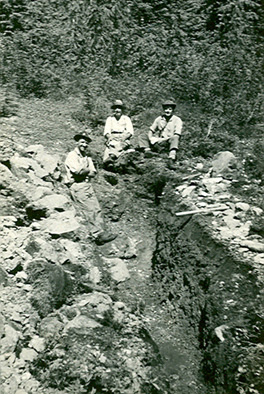
The Strata Mountain mine 1947 – Betty Fisher photo.

Strata Mountain mine site in 2004 – Lindsay Elms photo.
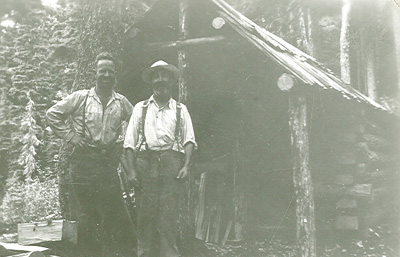
Sid Williams and Jimmy Aston outside Sid’s Cabin 1947 – Betty Fisher photo.
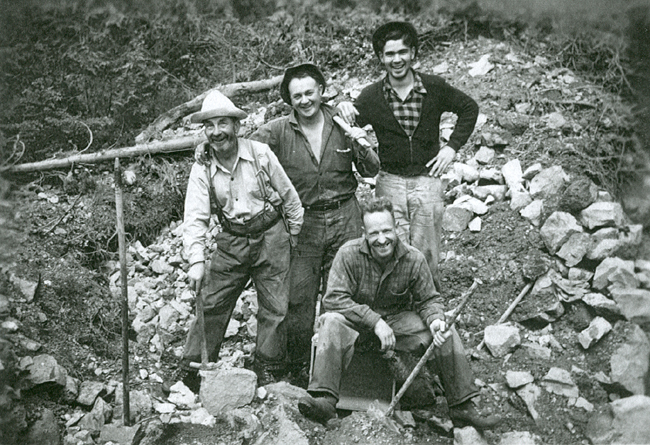
Jimmy Aston, Joe Ducca, Bruce McPhee and Sid Williams (sitting) at the mine site near Strata Mountain 1947 – Betty Fisher photo.
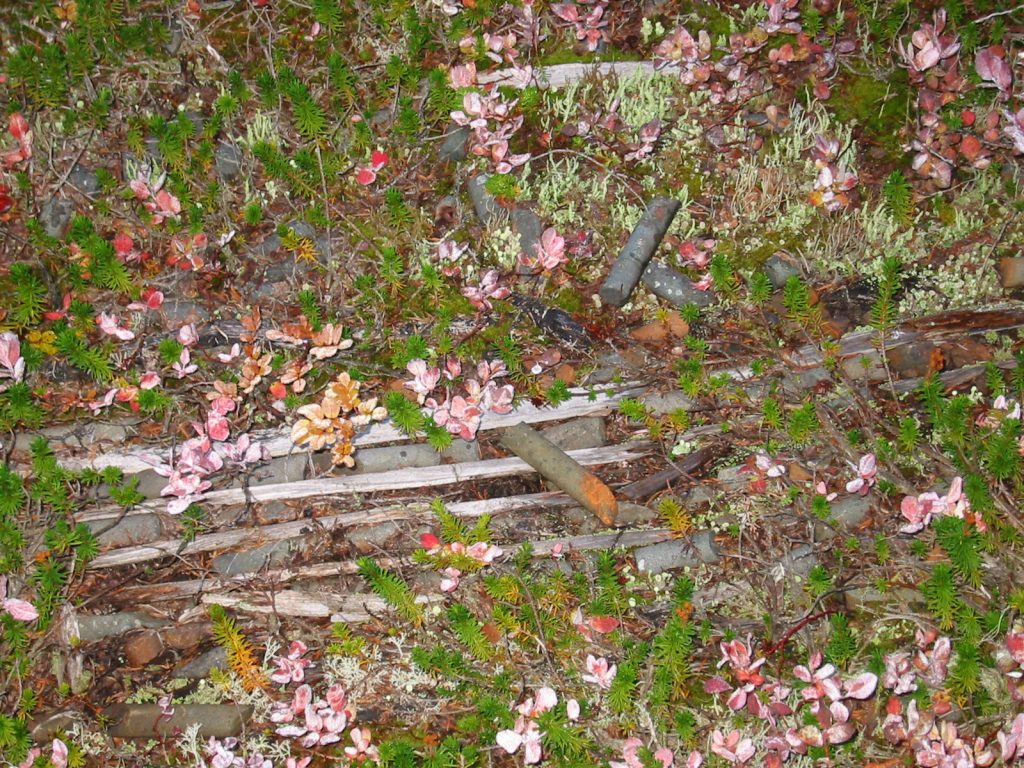
Core samples buried in the heather, 2004 – Lindsay Elms photo.

Sid’s Cabin, 2004 – Lindsay Elms photo.
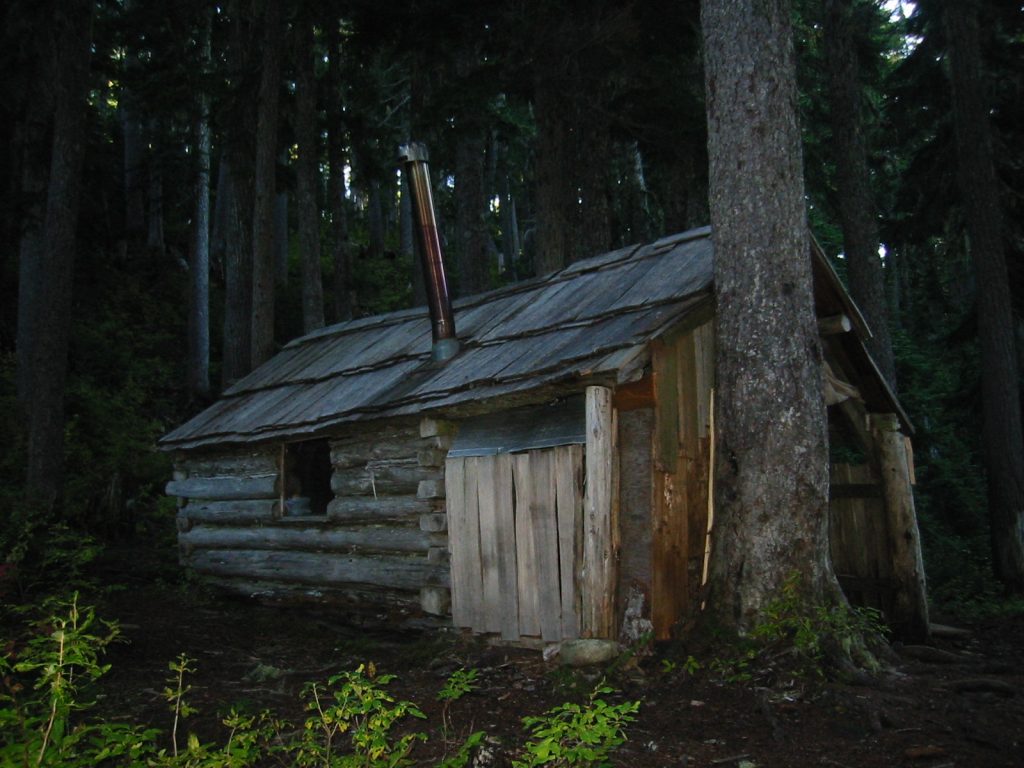
Sid’s Cabin, 2004 – Lindsay Elms photo.

Footing remains (2004) of the initial fly-camp built by Jimmy Aston and Sid Williams 1946 – Lindsay Elms photo.
Comox Glacier Climbed Again
Earthquake Had Shaken Down Cairn on Top
Reported in the Comox Argus Wednesday September 15, 1948. p.1.
According to the report of Mr. Bill Bell, the leader of a party of three to make the ascent of the Comox Glacier, the cairn at the top had been shaken down presumably by the 1946 earthquake which had toppled spires on the adjacent Castle [Castlecrag] Mountain. They found the can in which the names of those who had climbed the peak in 1929 had been placed. The lid had come off but the names decipherable. The cairn was re-built. The party took four days for the trip. The weather, for the most part, was foggy.
Getting ready for Skiing
Two Feet of Snow at Look-Out Cabin
Reported in the Comox Argus Wednesday November 10, 1948. p.1.
A small party of eight from the Comox District Mountaineering Club went up to the new cabin near the Lookout on Sunday to fix it up preparatory to the skiing season. They had to plough through two feet of powder snow to get there. A bus load came down from Campbell River and were enthused at the prospects. No one so far has broken the trail through to Becher Cabin but it is expected that there is at least three feet of snow there.
Skiing Good on Becher
Snow Seven Feet Deep at Look-Out Cabin
Reported in the Comox Argus Wednesday November 24, 1948. p.1.
Whilst every one else was cursing the south-easters the skiers saw the hills whitened with snow with joy. There is good skiing as far down as Forbidden Plateau Lodge where between four and five feet of snow fell though the level has gone down since. Up at the new cabin there is seven feet of snow and the ten who went up at the week-end had to slide down into it as if they were on a shute. No one has been up to Mt. Becher Cabin as yet but it is sure to be buried and the trail has to be broken. The provincial government has ploughed the road through to the lodge.
“Snow Queen” May Be Named
Reported in The Daily Colonist Sunday November 28, 1948 p.27.
COURTENAY, November 27—Possibility that a “Snow Queen of Forbidden Plateau” may be chosen from girls of Courtenay, Cumberland, Comox and Campbell River came up at a meeting of the Comox District Mountaineering Club here. The queen would be crowned at the annual club dance in February. At present the only in the discussion stage, the idea will be given further consideration at a later meeting of the club. Plans were made for the club members to sing Christmas carols during the Christmas week. All donations will be turned over to the Queen Alexandra Solarium for Crippled Children. Also discussed were plans for a ski party at Forbidden Plateau Lodge on the week-end before Christmas. Ten feet of snow is reported at the club’s first cabin on Mount Becher and skiers will turn out on Sunday morning in full force for the first time this season.
Skiers To Sing Christmas Carols
Reported in the Comox Argus Wednesday December 15, 1948. p.11.
The Comox District Mountaineering Club choral group under the direct of Ad Clement plan to give the people of the Comox District an old-fashioned Christmas season treat. Approximately 25 members of the C.D.M.C. will commence a four-evening tour singing Christmas carols on Tuesday, December 21 in Courtenay. Present plans call for a horse drawn sleigh that will carry the choristers all around Courtenay, Cumberland and Comox. If there is not enough snow for the sleigh a wagon will be used for the singers.
To Solarium
Collections taken up from the public during the singing of the carols will be sent to the Queen Alexandria Solarium in an effort to help brighten the less unfortunate children’s Christmas.
Tuesday Till Friday
Starting each evening at about 7:30 the group will commence in Courtenay on Tuesday, Wednesday they will go to Cumberland, Thursday to Comox, and on Friday they will again serenade in Courtenay. Arrangements are under way to have a short choral concert given at the Cumberland and Comox Hospitals.
1949
ACCVI executive:
Chairman – Mark Mitchell
Secretary/Treasurer – Nora Piggott
Events:
January 10 – A public lecture by Noel Odell on Mt. Everest at the Normal School.
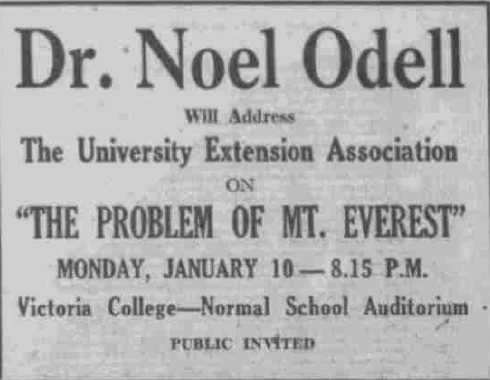
Dr. Noel Odell: “The Problem of Mt. Everest”
January 16 – Club trip (7 participants) to Mt. Tuam on Salt Spring Island.
January 22/23 – Club trip to Deer Park in Washington’s Olympic Mountains.
January 29 – Rex and Ethne Gibson had an evening party at their home “Bardsey” in Saanichton. Raymond Patterson gave a talk on his explorations by canoe in the region of the Nahanni River.
February 19 – Club trip to Mt. Baker was turned back by snowslides and members skied Hollyburn Ridge instead.
March 4 – In conjunction with the Outdoor Club of Victoria, Tom Walker gave a talk on his trip to the Cassiar Range at the Prince Robert House.
April 2 – The club’s annual banquet was held at the Strathcona Hotel. Noel Odell was the guest and gave an account of his ascent of Nanda Devi in India.
June 12 – Club trip (5 participants) to Mt. Whymper.
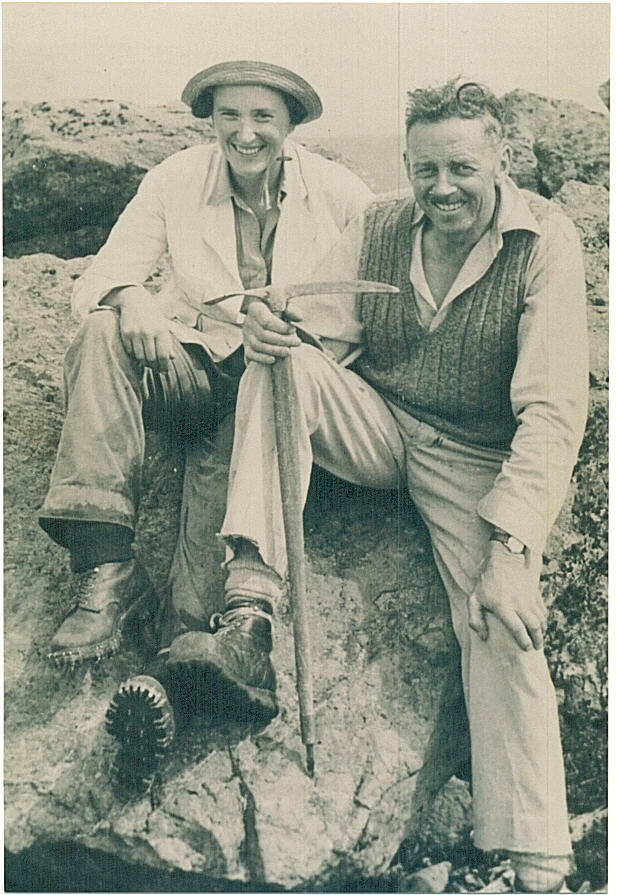
Rex Gibson and Ethne Gibson (nee Gale) on the summit of Mt. Whymper 1949 – Kathleen Gibson photo.
June – William Foster talked about the building of more than five hundred miles of pipeline across the northern wilderness from Norman Wells to Whitehorse and showed the accompanying film “Canol.”
July 2 – Club trip (9 participants including 2 from Vancouver) to Mt. Baker.
September 30 – Club meeting at the home of Dorothea Hay. Alan Bruce-Robertson showed slides of the 1948 expedition dubbed “Operation Snow Cornice” in the Yukon.
Other winter club trips included: Mt. Tzouhalem, Mt. Macdonald and Mt. Wells.
Three section members attended the ACC Ski Camp at the new C.G. Wates Hut at Outpost Lake, Jasper Park.
Section members who attended the ACC general summer camp at Freshfields July 18 – August 6: Muriel Aylard, Connie Bonner, Geoffrey Capes, Rex Gibson, Ethne Gibson
Section members who passed away in 1949: Jane Dorothea Hay, Richard Greer.
At Top of Mount Benson with Herb Bradley
Reported in the Comox Argus Wednesday January 5, 1949. p.1.
By Herb Bradley
The twenty C.R.A. youngsters who were up at the C.D.M.C. cabin for a week during the Christmas holidays returned on Sunday [January 2] at 5 p.m. tired and a bit on the dusky side, but happy and healthy. We were supposed to be back in Courtenay at noon but due to unforeseen difficulties we were late. Phyliss Williamson, one of the ten girls, gave her knee a bad twist at 4 p.m. Sunday, rather bad luck after a week of hard skiing. The others say it was on purpose so she could keep “Baldy” Archie Rankin company as Archie hurt his knee on Saturday. Aside from these two casualties the trip was very successful. We arrived at the new cabin Sunday, December 26th about 5 p.m., most of the children carried 30-pound packs which made the two miles to the cabin a tough climb. As soon as all had reached the cabin everything was a beehive of activity getting supplies sorted out, paths dug and bedding spaces ready, but by 10 p.m. all was set and the crowd turned in for the night. There was not much sleeping for the excitement proved too great.
The Ski Lesson
On Monday, morning broke clear and cold with the prospect of a perfect week ahead. All had a hearty breakfast of fruit, oatmeal, eggs, bacon, toast, jam and coffee. The group had ski lessons twice a day from 10 to 11:30 a.m. and from 1:30 to 3 p.m. and four nights we spent 2½ hours skiing on a hill behind the cabin by lamp light which was real sport. A trip was made to the Lodge on Wednesday and much improvement had already been made in the youngsters’ skiing. This was quite noticeable as there were only a couple sitzmarks all the way from the cabin to the Lodge. Everyone of them claims someone took a tuck in the trail for the trip back up as they all made it in 1½ hours or less. Don Geidt took 41 minutes, real travelling. The first time we made the trip it took four hours.
Breaking Trail
On Thursday during a terrific storm, we made a trip to the Courtenay Look-out, breaking trail through a foot and a half of new snow, but everyone wanted to go just to see what it was like. They soon found out for a strong wind filled with swirling snow was driving with such force that they could hardly stand against it.
On Top Mt. Becher
Friday we went up to Becher Cabin, in one and one quarter hours, a distance of one and two thirds miles. We had dinner there and then went to the top of Mt. Becher, another three quarters of a mile where a real blizzard was blowing. However, everyone kept on until he had touched the brass plate atop Mt. Becher. Coming down again was a nightmare for one couldn’t see more than 10 feet ahead but aside from Bryan Williams nearly leading the gang onto Boston Canyon we arrived safely back at the new cabin where a New Year’s Eve dinner of chicken and all the trimmings, even plum pudding, was waiting. That night we skied from 10 p.m. to 12:30 a.m. bringing the New year in properly and then had a sing song to the accompaniment of a pop bottle orchestra until 2 o’clock. We arose at 10 a.m., our usual schedule calling for breakfast at 7:30 and bed at 10:30. Lessons were carried out no matter what the weather conditions so that the youngsters would learn to skin in any kind of weather.
Girls On Kitchen Duty
Two girls were on kitchen duty each day as kitchen help and two boys assisted with wood, water and snow shoveling. Phillip Bickle still claims “I knew it was going to snow a foot and a half on Thursday”, his day for shoveling snow, it really kept him hopping. All in all, I believe it was a very successful camp. The youngsters showed keen interest and excellent co-operation. Their skiing is much improved and I believe all had a good holiday. We wish to extend our most sincere thanks to the Comox District Mountaineering Club for the use of their cabin, for without it the camp could not have been held. Each and every year one of the youngsters says “thanks a million.” Included in the trip were two dogs “Dusty” and “Joe.”
Alpine Club Shows Interest in Extension Group Speaker
Reported in The Daily Colonist Sunday January 9, 1949, p.3.
One group of Victorians will know, from experience, exactly what Dr. Noel Odell is taking about when he describes his mountain-climbing experiences to a Victoria Extension Association audience Monday night. They are members of Victoria’s Alpine Club, who keep in practice Winter and Summer by scaling peaks on the Island and Mainland. Two of them, Major-General William Foster and Major Rex Gibson, have climbed with Dr. Odell in the Yoho Valley in the Rockies. All members of the club were notified that Dr. Odell will speak tomorrow [January 10] and most of them are expected to attend the lecture. It will start at 8:15 p.m. in the Victoria College-Normal School Auditorium. Dr. Odell will discuss the problems involved in climbing to the highest point in the world, the peak of Mount Everest. He came within 2,000 feet of the 29,000-foot summit in 1924 on the same expedition with which the British alpinists [George] Mallory and [Andrew] Irvine lost their lives in an attempt to complete the climb. Now teaching at the University of British Columbia as visiting professor of geography and geology from University of Cambridge, he is a veteran of two expeditions that tried to climb Everest. He has published 17 works on the Himalayas.
Club To Stage April Contest
Reported in The Daily Colonist Saturday January 29, 1949, p.6.
COURTENAY, January 28
Vancouver Island open ski championship tournament will be held on the Forbidden Plateau ski fields April 10, it was announced by the Comox District Mountaineering Club. District skiers are hopeful of regaining the slalom and downhill trophies won last year by three Montreal naval cadets stationed at Royal Roads College, Victoria. A club tournament will be held Sunday on the ski run below the Mount Becher timberline. A Kandahar race is slated for March 20.
Skiers Break Record Sunday
Hundreds Enjoy Ideal Conditions for Club Tourney
Reported in the Comox Argus Wednesday February 2, 1949. p.1.
The skiing slopes were at their very best on Sunday [January 30] when the Comox District Mountaineering Club held their first competition in 1949. The forthcoming open tournaments prompted the club membership meet Sunday and good times were turned in. Perfect weather conditions made the snow surface very fast and although there were numerous spills no accidents mar the day.
Rushton Wins
On of the most promising young plank artists to use the local slopes, Stan Rushton, clipped from the former downhill track record with is time of 49 seconds for the 900-yard run. George “Hobby” Hobson flashed off the near half mile run in 50.5 seconds to pick up second prize and taking the third prize money, Frank Stapley crossed the line 1½ seconds later. A tie between Carl Lamb and Angie Strachan with the time of 58 seconds filled in fourth.
Chic Again
The girl who upheld the C.D.M.C. honors last year in the big tourney, ‘Chic’ (Gladys) Andrews is again the ladies choice to take top berth this year. On Sunday she made a clean sweep of the women’s competition in both downhill and slalom. Her downhill time of 59 seconds, (which figures out close to 30 m.p.h.) was exactly a minute faster than her closets rival, Gladys Skinner who clipped it off at 1 minute 59 seconds. Doris McQuillan copped 3rd place with the time of 2 minutes 20 seconds.
Pro Time
Both Herb Bradley, C.R.A. instructor and Pete Olenick took a crack at the downhill race but did not officially enter the competition. Their times were: Bradley 44.5 seconds and Olenick 45.5 seconds.
Better On Curves
Angie Strachan will be taking a ribbing about being pretty fast around the curves after his whirlwind running of the slalom in which he captured first place in 22 seconds. Frank Stapley and George Hobson were right behind him like greased lightning of 22 1.5 and 22 4.5 seconds for second and third places respectively. Herb Bradley opened the slalom with the non-competitive time of 16 3.5 seconds as a mark for his proteges to strive for.
Ladies Slalom
As was expected, Chic Andrews carried off the ladies Slalom in 38 1.5 seconds but Doris McQuillan tagged her all the way down with the running time of 44 seconds and Gladys Skinner came in at 1 minute 23 seconds for third place.
Sailors Expected
A party of Royal Roads R.C.N. personnel are expected up on the slopes this coming week to acquaint themselves with the runs in preparation for their invasions at the forthcoming tourneys. It was the R.C.N. boys who snapped up the big majority of silverware in the 1948 Kandahar and it is understood that they will be returning to try and retain their ownership on February 20 when the second annual Kandahar will be run.
Junior Date Undecided
In an effort to further foster juniors into taking to the slopes a junior competition will be staged at an early date but until all arrangements can be completed a definite date has not been set.
April Wind Up
The big annual wind up of the winter ski activities will be held about April 30th (confirmation of this will be published later) and it is at this meet that great things are expected from the local artists.
Courtenay Critical of Robert Mayhew’s Plan
Reported in The Daily Colonist Friday February 25, 1949, p.6.
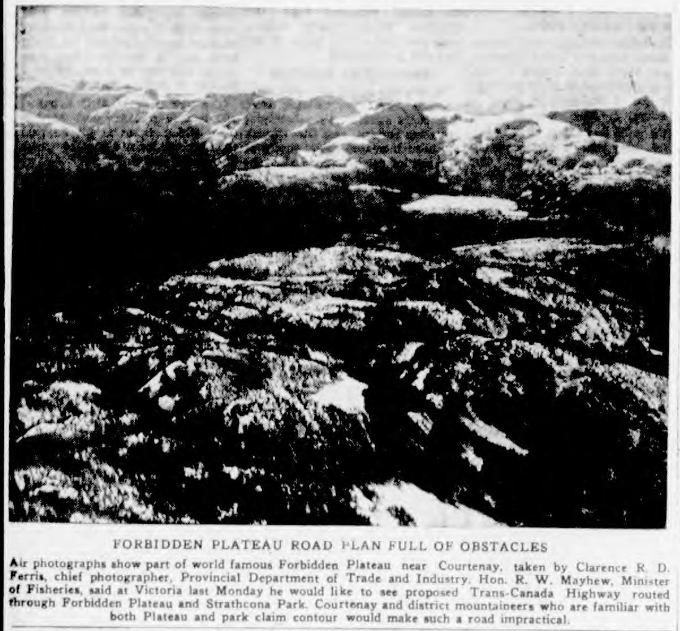
FORBIDDEN PLATEAU ROAD PLAN FULL OF OBSTACLES
Air photographs show part of world famous Forbidden Plateau near Courtenay, taken by Clarence R. D. Ferris, chief photographer, Provincial Department of Trade and Industry. Hon. R. W. Mayhew, Minister of Fisheries, said at Victoria last Monday he would like to see proposed Trans-Canada Highway routed through Forbidden Plateau and Strathcona Park. Courtenay and district mountaineers who are familiar with both Plateau and park claim contour would make such a road impractical.
COURTENAY, February 24—A proposal of Hon. Robert W. Mayhew [Mayhew was a Liberal and was re-elected in 1940, 1945 and 1949. From 1945 to 1948, he was the parliamentary assistant to the Minister of Finance. From 1948 to 1952, he was the Minister of Fisheries. From 1952 to 1954, he was the first Canadian Ambassador to Japan.] that the Trans-Canada Highway be extended across Vancouver Island through Forbidden Plateau to the West Coast is deemed impractical by Courtenay men who know the terrain through which the road would have to pass. Mr. Mayhew said at Victoria Monday night he would like to see the proposed highway routed across the Island through Forbidden Plateau and Strathcona Park areas. Mountaineers in this district say the contour of the area varies so much as to make a road impractical. F. Sidney “Sid” Williams, who has hiked many times into the plateau and park, asserted the cost of the road would be prohibitive since it would involve mile after mile of blasting rock and constructing switchbacks to avoid precipitous descents and to surmount the numerous high peaks in the area. “The cost of keeping the road free from snow during the winter would alone be too much,” he stated, adding that the area had a minimum of 20-foot snowfall each year.
Suggest Loop Road
Mr. Williams thought a loop road into the Forbidden Plateau would be much more practical. He also suggested that the proposed highway be built to link Courtenay, Cumberland and Port Alberni, with an extension to Ucluelet and Tofino. Robert Gibson and Angus McMonnies, who also know the Plateau area thoroughly, declared Mr. Mayhew’s idea was too ambitious. Mr. Gibson thought such a road might be built inland from Campbell River, follow the Campbell Lakes watershed back to Buttle Lake, and down behind the Comox Glacier to great Central Lake and Port Alberni. “Even that would call for tremendous expenditure,” he explained. Reports of the spectacular grandeur of the Forbidden Plateau and Strathcona Park have been brought back by numerous mountaineers who have gone into the country on foot, and also by airborne sightseers, but most agree the areas present well-nigh impossible problem to road builders.
Ski Club
Reported in the Comox Argus Wednesday March 2, 1949. p.10.
Members of the newly formed ski club were unable to make their usual trip to Forbidden Plateau last Sunday [April 30] as the roads were blocked with ice and snow. However, they spent a very enjoyable day skiing at Forbes Landing. Frank Stapley and Alex Linton plan to look into possibilities of locating a suitable ski site on Menzies Mountain. At their meeting held at the home of Alice May Jennings on Thursday evening [April 27] the members agreed to buy an auto ski rack. At the present time members are hiring a U-drive which only accommodates six persons as a means of transportation and are finding this to be quite expensive.
To Tell of Province’s Wonders
Reported in The Victoria Daily Times Thursday March 3, 1949, p.8.
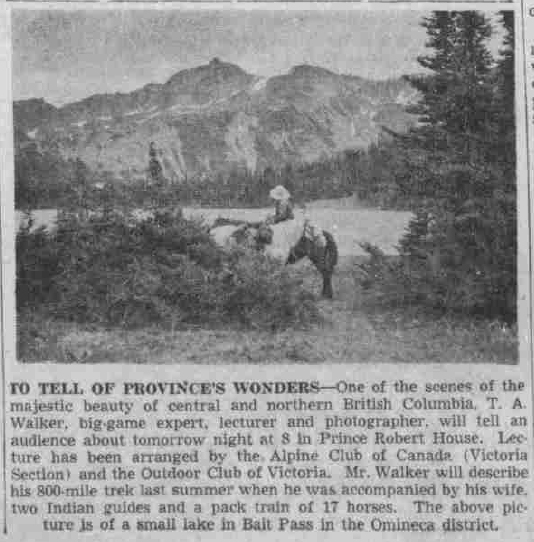
TO TELL OF PROVINCE’S WONDERS — One of the scenes of the majestic beauty of central and northern British Columbia, T. A. Walker, big-game expert, lecturer and photographer, will tell an audience about tomorrow night at 8 in Prince Robert House. Lecture has been arranged by the, Alpine Club of Canada (Victoria Section) and the Outdoor Club of Victoria. Mr. Walker will describe his 800-mlle trek last summer when he was accompanied by his wife, two Indian guides and a pack train of 17 horses. The above picture is of a small lake in Bait Pass in the Omineca district.
Plateau Ski Tow
Reported in the Comox Argus Wednesday March 30, 1949. p.1.

This is a picture of the famous ski tow near the Forbidden Plateau Lodge on Mount Becher.
The plank artist, who is looking round at the camera is Cliff Graham taking a ride to the top. This is the Argus picture of the week and was taken by Miss Peggy Boyd.
Ski Tourney at Mt. Becher
Chic Andrews and Stan Rushton Win Top Honors
Reported in the Comox Argus Wednesday April 13, 1949. p.13.
Misses Gladys (Chic) Andrews and Stan Rushton skied their way to top place in both the downhill and slalom races held at Mt. Becher on Sunday [April 10]. It was Miss Andrew’s second straight year of winning the coveted trophies in the girl’s division. She bettered her time by 9 and 4.5 seconds over last year with the downhill time of 38 1.5 seconds.
Kandahar Too
For Stan Rushton it meant the pilling of more laurels to his Kandahar victory of two weeks ago. His double win on Sunday makes him the undisputed winner of all C.D.M.C. sponsored races.
Ladies Downhill
Min Sec
Gladys Andrews 38 1.5
Margaret Morrison 39
Irene Andrews 39 3.5
- Strachan 51
Doris McQuillan 51 1.5
Marilyn Pimm 54 2.5
Gladys Skinner 1 06 2.5
Linda Williams 1 11 3.5
- Williamson 1 38 35
Ladies Slalom
Gladys Andrews 1 16
Linda Williams 1 18 2.5
- Williamson 1 18 4.5
- Bridgers 1 18 4.5
Doris McQuillan 1 19
Irene Andrews 1 19 3.5
Margaret Morrison 1 22 2.5
- Strachan 1 22 4.5
Gladys Skinner 1 32 3.5
Marilyn Pimm 1 40 2.5
Men’s Slalom
Stan Rushton 1 2 1.5
Sid Williams 1 17 3.5
Ed. Bartle 1 20 4.5
- Veitch 1 27 3.5
Frank Stapley 1 32 1.5
Alex Linton 1 36
Angus Strachan 1 36 4.5
Keith Morton 1 39 1.5
Bob McPhee 1 42
Alan Simpson 1 46 1.5
- Nicholson 2 22
Men’s Downhill
Stan Rushton 1 41 3.5
Angus Strachan 1 23 3.5
Ed. Bartle 1 48 3.5
Frank Stapley 1 51 3.5
- Veitch 1 52
Alan Simpson 1 56 3.5
Sid Williams 2 3 1.5
- Nicholson 2 4 2.5
Gerald Fitzgerald 2 15 1.5
Ad Clement 2 21 1.5
Bryan Williams 2 21 3.5
- Hatt 2 22 1.5
Keith Morton 2 22 3.5
Alex Linton 2 25 2.5
- Dargie 2 33 4.5
Philip Bickle 2 37 1.5
- Thompson 2 45 2.5
- Rankin 4 8 2.5
Men’s Combined
Stan Rushton 2 43 4.5
Ed. Bartle 3 9 2.5
Sid Williams 3 20 4.5
Ladies Combined
Gladys Andrews 1 54 1.5
Irene Andrews 1 59 1.5
Margaret Morrison 2 60 2.5
Mountaineering Club Dinner
Seventy Attended It in Courtenay on Friday
Reported in the Comox Argus Wednesday May 25, 1949. p.1 & 9.
The Comox District Mountaineering Club held their Third Annual Banquet on Friday [May 20] evening at the Legion Hall, Comox. Seventy skiers and their guests were present. The tables were beautifully decorated with bowls of pansies, tulips and lilac, and everyone received a souvenir of the evening in the form of a model of Takaschushagen, the patron saint of skiers. Mr. Ad. Clement explained for a few moments what Takaschushagen stands for and then proposed a toast to him. Immediately after the toast Mr. Sid Williams moved a few of the eligible bachelors who had been sitting together at one table, to chairs between the girls. This, of course, caused a few embarrassing moments for the boys and provided the wits of the club with chances to make several remarks.
Too Many Activities
Following the signing of a few songs by the group led by Mr. Sid Williams, president Bob McPhee reviewed the work of the club during the past year and discussed the problems that the organization faced in the future. He felt that too many activities were being entered upon by skiers and he feared that new members might be lost if they found it difficult to find time for this work. The president said that of course the club has certain work to do that is essential, such as work parties and the support of the C.R.A. in the annual Skattered Skit, but that we should in future try harder to keep as close as possible to just skiing. Mr. Chambers of the Forbidden Plateau Lodge gave the members a short talk on the desirability of the district and especially the club in encouraging and welcoming visiting skiers to our town. Mr. Bob McPhee welcomed two representatives of the Junior Ski Club, the Fanny Dunkers, to the banquet. He remarked that their skits this year in imitation of a senior Ski Club meeting was appreciated by us as “imitation is the sincerest form of flattery.” A vote of thanks was extended to Miss Doris McDonald for her fine work in writing the news column for the club this past year. The presentation of the trophies was done by Mr. Herb Bradley. Stan Rushton received the awards Mens’ Downhill and Mens’ Slalom. Gladys Andrews took the Ladies Downhill and Ladies Slalom. The Comox District Mountaineering Club Trophy for Combined Downhill and Slalom was won by Stan Rushton, and the Women’s by Gladys Andrews. Second prize for Downhill, Sid Williams, second for slalom, Angus Strachan. Second for Combined, Ed Bartle. Second for Women’s Downhill, Linda Williams. Second for Combined, Irene Andrews. The Tall Tales Contest was started off by Mr. Bob McPhee, but the judges awarded first to Mr. Sid Williams for his tale of how he attained the amazing speed of 120 miles per hour on a scientific (?) type of ski he devised. Mr. Bill Bell won the second prize for the story of how cold it becomes on Mt. Becher even to the point of freezing smoke. The evening wound up with games, singing and dancing.
Virgin Peak Is Climbed
The Bell Brothers Made the Ascent of Argus Mountain on Dominion Day.
Recorded in the Comox Argus Wednesday July 6, 1949.
Messrs. Bill and Alec Bell of Courtenay climbed Argus Mountain on Dominion Day (July 2). They are the first to make the climb. The peak is on the left side of the Cliffe Glacier and is considerably lower.
Postscript:
By Lindsay Elms
Bill and Alec Bell didn’t make the first ascent of Argus Mountain. In July/August 1947, Ralph Rosseau of Port Alberni undertook a two-week solo trip into the mountains at the head of Great Central Lake. After ascending Drinkwater Creek, he then climbed over Mount Septimus (July 28) to the Cliffe Glacier and continuing on to the Aureole Snowfield climbing Argus Mountain (August 2), Tzela Peak, Iceberg Peak and Mount Celeste (known then as Rees Ridge) along the way. He returned by the same route.
Ascends Towering Peak
Reported in The Daily Colonist Friday July 8, 1949, p.22.
Courtenay, July 7—First ascent of 6,400-foot Argus Mountain was made by William [Bill] Bell, Courtenay. The precipitous crag, towering into the air at the south end of the Cliffe Glacier, in Strathcona Park, had previously turned back climbers’ attempts. Mr. Bell, who made the trip back of the Comox Glacier with his brother Alec, said broken rock, soft snow, and almost sheer surfaces made climbing extremely hazardous. The only vegetation on the mountain is dark lichen which clings to the rocks.
Argus Peak is Conquered
Mr. Bill Bell Made First Ascent on July 2nd
Recorded in the Comox Argus Wednesday July 13, 1949.
Back-packing into the rugged country west of the Comox Glacier Messrs. Bill and Alec Bell found very deep snow on the Cliffe Glacier of which the guardian peaks are the Red Pillar and the Argus Mountain. On the morning of July 2 Mr. Bill Bell climbed to the top of Argus Mountain but found The Red Pillar too treacherous. Eighteen years ago, a party consisting of Messrs. Ben Hughes, Arthur Leighton, Jack Gregson and W. Adrian B. Paul climbed The Red Pillar for the first time. Two years before they had seen the great mountain to the west when they were on their way to the Comox Glacier and had resolved then to attempt it. At that time there was no logging up the South Cruikshank and the Trout [Willemar] Lake at the end of Comox Lake had not been logged so that their journey started from the end of Comox Lake with fifty-pound packs. They took boats to the middle of the second Trout [Forbush] Lake and then continued up the valley to the source of the Puntledge.
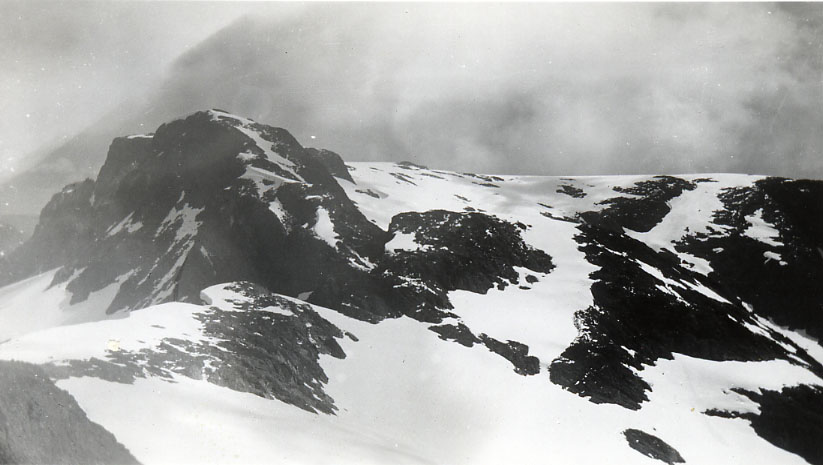
Looking back at the Comox Glacier from near Argus Mountain 1949 – Bill Bell photo.
The Red Pillar
They came to the Red Pillar at the west face. It looked very formidable. They scouted the north face and it was impregnable. They came back to the west face and went up the rock, moving slowly from hand-grip to hand-grip. Once they thought they were stalled when they found a great rock chimney but they found another chimney and came out on a small plateau on top where they startled a ptarmigan and her brood. Once on top they found an easier way down the south face. On top they left their names in a cairn asking that the mountain should be called The Red Pillar to denote its characteristic color and shape. They hoped to get back by way of the ridge that runs from the Comox Glacier to the Argus but found the going so steep on the scree of the flank of Argus and the footing so treacherous that they turned back when they came to a snow bridge that went off very steeply a thousand feet or so. They had no ropes. Shortly after this a member of the typographical section of the Department of Lands from Victoria came up to Courtenay to consult with local climbers to decide the nomenclature of peaks and other prominent points in the area of the Forbidden Plateau and Strathcona Park. They confirmed The Red Pillar in its name.
Too Many Camels
The party who made the ascent suggested for the companion peak the name of Camel, but the official said there were numerous “camel” mountains already in Canada. He suggested that it should be called Ben Hughes Mountain but the proprietor of the Argus objected to this as being too personal, but agreed that it should be named after the paper he owned, and so it was. The color of the Argus rock is as black as The Red Pillar is red suggesting that there is a fault running down the centre of the Cliffe Glacier, one of the chief sources of Comox Lake.
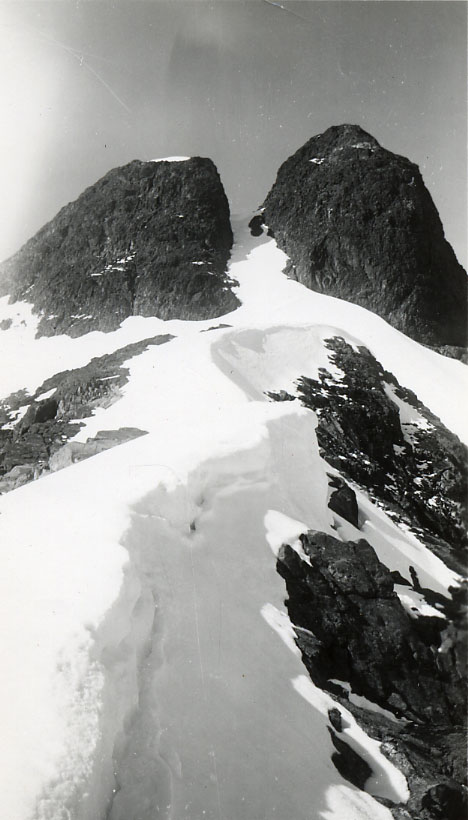
The final snow gully to the summit of Argus Mountain. 1949 – Bill Bell photo.
A Tough Trip
On their trip two weeks ago the Bell brothers had the advantage of a flying start up the South Cruikshank branch of the Comox Logging. They struck from it across to Evans Mountain [Mount Kookjai] and camped on it for the first night at the 3,500-foot level. It rained hard and they were traveling light without any protection from the elements. They followed the usual route to the Comox Glacier and crossed its half mile of snow in a dense fog, a hazardous business as the cliffs at its edge are precipitous. On July the first they camped on a ledge of rock on the ridge between the Comox Glacier and Argus Mountain. They had to lose some altitude to find some fire wood to make a fire. On July the second Mr. Bill Bell climbed the Argus Mountain. Five to six inches of snow had fallen recently on this flank.
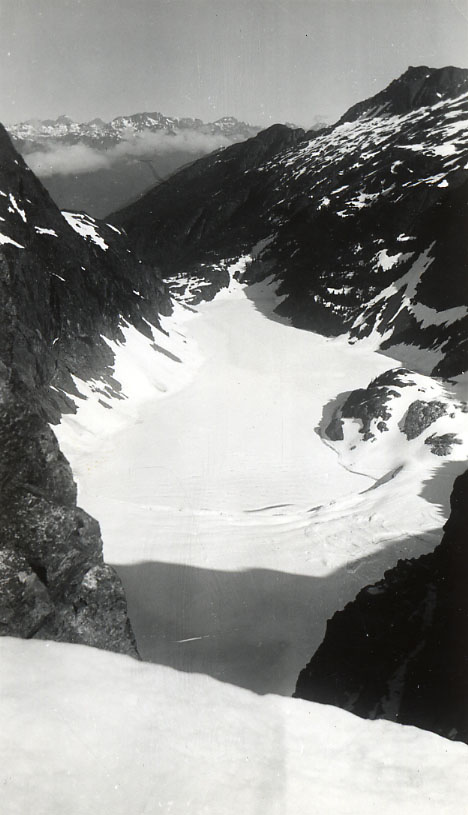
Looking down on Milla Lake from the summit of Argus Mtn. 1949 – Bill Bell photo.
Snow Too Treacherous
This is a loose scree dropping off at a very steep angle and it was tough going. The Argus has a snow cleft down its centre and once there the ascent to the top was easy. Mr. Bell then turned a longing eye to the Red Pillar but it was already getting on in the day and the snow on its steep flank looked very treacherous and he decided that without ropes it would be foolhardy to attempt it so the brothers went back the way they had gone without misadventure.
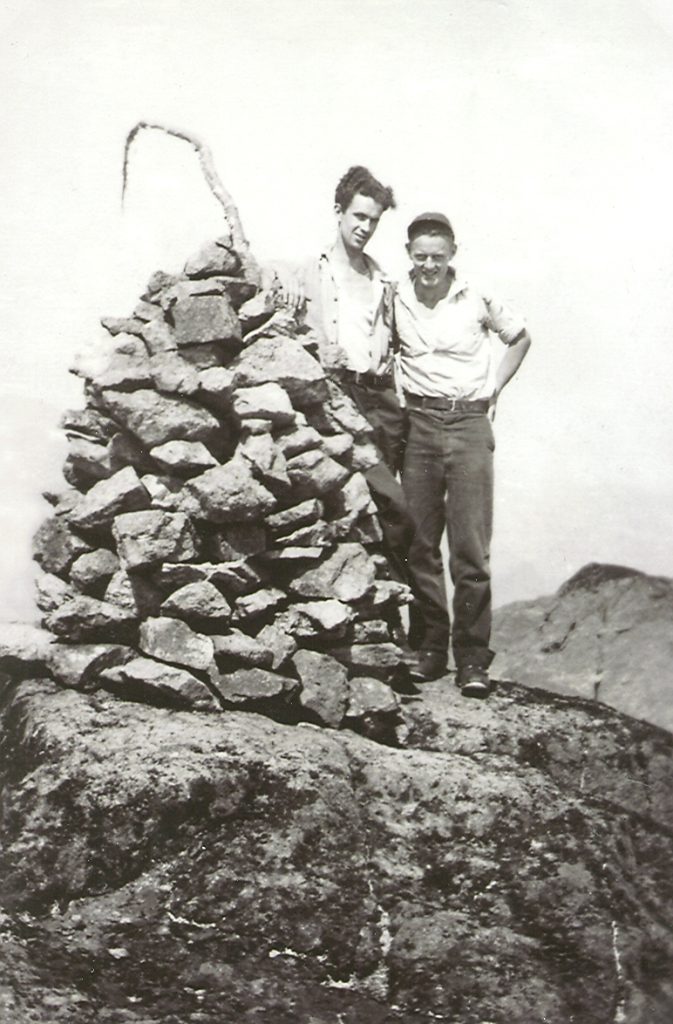
Bill and Alec Bell standing next to the summit cairn on the Comox Glacier 1936.
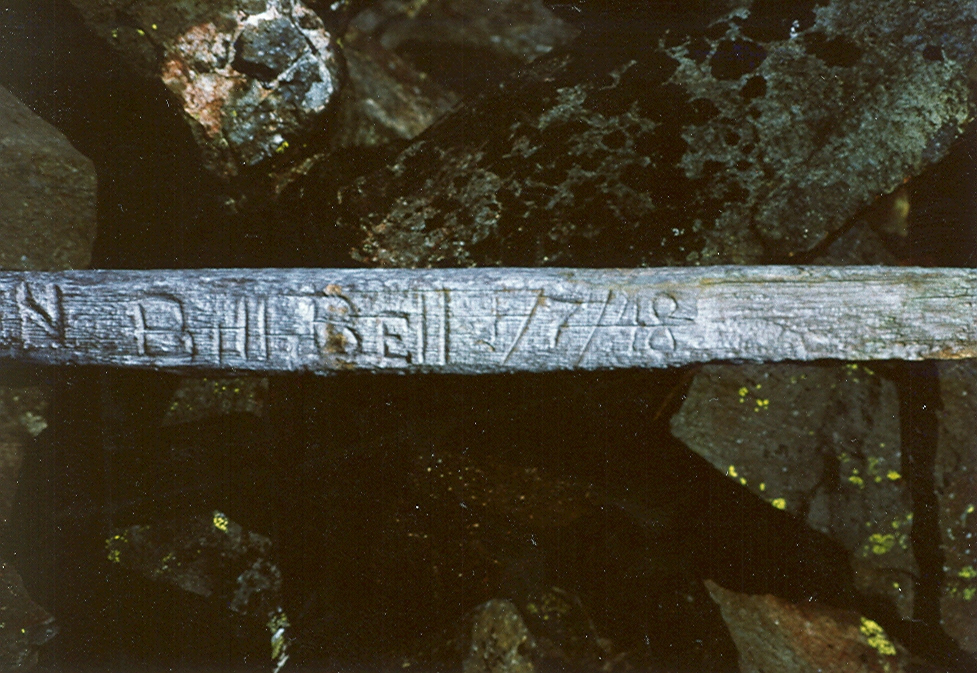
A stick of cedar carved by Bill Bell on 1 July 1948 found on the summit of Iceberg Peak in 1992 – Lindsay Elms photo.
Argus Mountain
Reported in the Comox Argus Wednesday July 20, 1949. p.1.
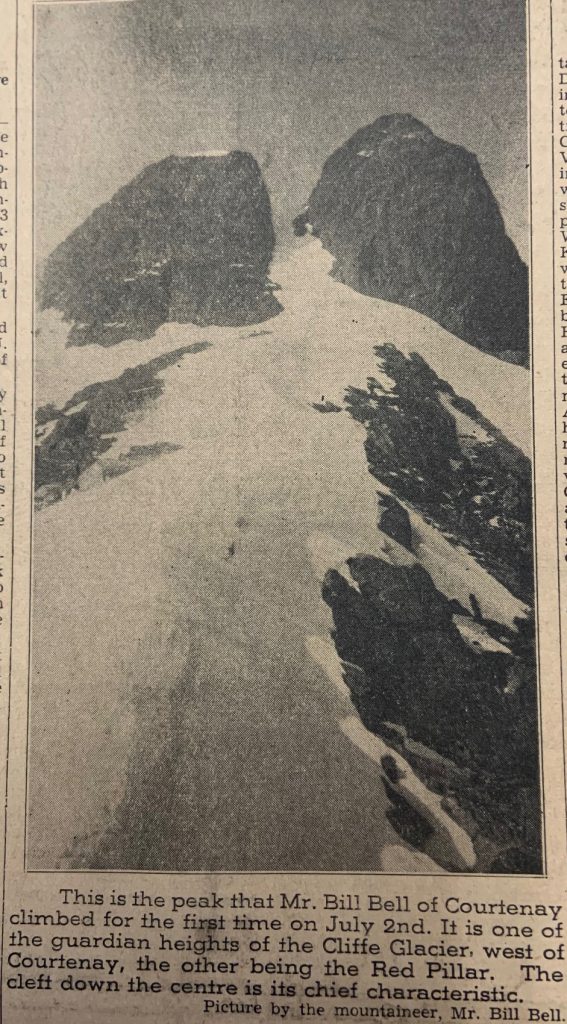
This is the peak that Mr. Bill Bell of Courtenay climbed for the first time on July 2nd. It is one of the guardian heights of the Cliffe Glacier, west of Courtenay, the other being the Red Pillar. cleft down the centre is its chief characteristic. The Picture by the mountaineer, Mr. Bill Bell.
The Second Ascent of Elkhorn Mountain
From the diaries of Geoffrey Capes September 2 – 6, 1949
Charley Nash picked me up in Courtenay at 5 p.m. Friday. We proceeded up the highway through Campbell River to Camp 8 of the Elk River Timber Company where we waited for Phil Wolstenholmes from Campbell River and Bill Lash and his son Mallory Lash from Victoria. When the others arrived Charley and I drove to Upper Campbell Lake to arrange with Sutherland to have a boat to Camp 9 at 7 p.m. Tuesday for three of us (the Lash’s were staying till Thursday). That done we waited for the speeder from Camp 8, which came bringing the rest and pushing a flat car bearing the Lash’s car. Charley and I piled on. At Camp 9, where we got off, there was a station wagon belonging to an American family who had started up the road to Drum Lakes for fishing. Seven miles up the road the piles under a bridge had collapsed and their car had suffered serious damage. Their bad luck saved us from this catastrophe. Camp 9 was deserted but most of the doors were open. As it was too dark to go on we each got a cot and a mattress and slept very comfortably in our sleeping bags. The weather was superb as we set off next morning up the road in Lash’ overloaded car, five men with five packs. We carried two narrow planks eight feet long and with these we were able to get across the broken gap at the beginning of the bridge. Driving on 13 miles to beyond the logged off area, we parked the car on a wide bridge over the Elk River. It was 9:50 a.m, groaning, we lifted our packs weighing variously from 48 to 58 lbs. Proceeding through the woods we climbed steadily, the going not too bad. We rested frequently. At two we reached the only accessible water on this route. The mountain is steeper here but we made good progress. We rested at our campsite of a year ago, when fog finished our trip. We were all getting tired as we made our way up steep bluff after steep bluff, the rhododendron bushes helping us in the steeper spots. At last we reached the top of the ridge where the heather grew and could walk in the open. At 6:20 we found a fairly level camping spot above a small bank of snow with a tiny pool of running water. Soup and hot tea was the favoured menu. It was a breezy dawn but the sky was clear. We got away at 8:30 and traversed around King’s Peak, continually climbing over a series of terraces. The views were superb under a cloudless sky. Mount. Waddington was visible, its terrific mass rising above the other mountains of the Coast Mountains. In the other direction we could see the Pacific. At lunch cups of snow, which we hoped would melt in the sun, had to suffice for drink. Elkhorn was now in view but the route to it was still not clear. From here we descended over long, gentle slopes. At last, at 2 o’clock we were able to gaze at the majesty of Elkhorn, rising from a circular basin 1500 feet below. We could see a fair-sized creek running to one side of a beautiful campsite. Our ridge was at an end, blocked by a mass of rock we named The Thumb. The Lash’s plan was clear; below lay the camping spot for the advance on Elkhorn. To Phil, Charley, and me the issue was clear too; we could not climb Elkhorn and return to the boat rendezvous by 7 Tuesday evening. It was a bitter disappointment to have carried 50 lb. packs over miles of tough country to no avail, and this the second attempt. Persuaded however, by the attractiveness of the scene below, we decided to go down with the Lash’s to the camp. It was not an enjoyable descent. For about 1000 feet we slid down heavy and light scree, then into gulches. At last we struck the remains of a snow slide and at the bottom flung down our packs. We could go no further had we wanted. This basin was the end of the valley blocked by Elkhorn. We contemplated the mountain. It was a tough looking climb but did not seem to be more than 3000 feet. We just wondered; normally one descends a mountain faster than one ascends. Could we possibly make the climb tomorrow and start on our return after getting down? My own calculation was that we could do the climb and be back by 3. The decision was changed; the five of us would attempt the climb. Now there was nothing to do but rest, a glorious feeling! I walked down to a small pool, bathed, and sunned on a rock. We woke to another day of superb weather. The climb started with a walk up rock slabs to a snowfield. It was not difficult up the snow to the col. At this point we could see something of our route and it did not look like an easy walk. In fact, from here on, except for one spot near the top, there is no place one could say is easy climbing. The mountain is composed of loose rock and we had to watch our handholds. Phil soon decided it would be better if he did not accompany us; he had not had much experience. The rest of us went on. There were no lack of hand and foot holds but one had to be continually watchful about knocking rocks down on the man below. Mallory led the party magnificently. The Lash’s had luckily brought a 60-foot rope; a longer one would have been better. We could not have made the climb without it. There was no way we could see to by-pass our first real difficulty, a 25-foot chimney with practically no holds and the two walls at a wide angle. Mallory got up and belayed each of us separately. Just above was a nasty spot, about 100 feet of sloping rock with no handholds. The slope was not excessive but it was covered with a thin layer of light, slippery scree. Mallory got up and belayed the others. I managed to find a little safe going, more to the right. This brought us to the base of the gendarme. Around a buttress of this, where one could not see, was another tricky spot. It was only a few feet but there were no hand or footholds on either the buttress or the sloping rock on which we stood. We belayed each other around. We had arrived at a steep snow slope. We roped up, four of us on a 60-foot rope. The two Lash’s had ice axes. The snow was very firm and it was not difficult cutting steps. The top of the snowfield brought us to the bigger area of flat space on the mountain. The final peak was now ahead of us. The ice axes were left here. The climbing continued to be very steep, in some spots very exposed, but there was only one more spot where the rope was used. We had a breather before tackling what looked to be the last of the worst of the climb; another chimney, though not as bad as the lower one. While being belayed a small stone hit Bill on the head. One trouble with this mountain is that when belaying there are hardly any spots where one can get out of the way. Once up the chimney the slope grew less steep. Near the top of the mountain about six small grey-coloured birds flew past, they looked something like swallows. A bee was buzzing around. We reached the summit at 1 p.m. (I had estimated noon). An hour on top taking photos and admiring the view passed very quickly. We roped down the chimney near the summit; Mallory coming last, rappelled. On the rope down the snow slope the two Lash’s, having ice axes, brought up the rear. We belayed each other around the buttress. Then came the tricky part over the light scree on the sloping rock. Mallory belayed us down this. At the bottom there was a space to dodge rocks. Bill and I, waiting there, were lucky that a big rock that was dislodged stopped before reaching us. The most difficult part of the whole descent came last. This was the first chimney we had tackled. Mallory had only one place he could stand from which to belay us; he kept his head down as low as he could behind a boulder while each man lowered himself to where he could tie on the rope. This chimney took a lot of time. I was down first and got the full benefit of the sun shining against me and the mountain behind. It was a beautiful sight to see the Pacific shimmering miles away in the sunlight. After Mallory had rappelled down, we did not use the rope again. We followed the rocks to a scree slope which took us down easily t the snowfield below. Phil was waiting for as at the col. According to taste we proceeded down the rocks or the snow. We reached camp at 6:40 p.m. There was no argument; it was impossible to pull out that evening. I wakened Phil and Charley at 6:10 a.m. It was barely light. I glanced back at Elkhorn and in a notch half way up the summit gleamed a blue morning star. We breakfasted, packed up, and the three of us were away at 7:20. Another wonderful day. We were able to travel mostly in the shade up the 1500-foot rise. The route picked was good but it took two and a quarter hours before we began the descent. First, we quickly disposed of a tin of tomato juice leaving the tin on a rock to guide the Lash’s. We hit our previous camp right on the nose at 11:35, had a good lunch of bacon, sausages, and tea and, starting again at 12:50 were soon on the steep bluffs. We made good progress hanging on to the bushes. We were lucky and struck the only pool of water at 2:15, drank quite a lot of it, ate some chocolate, took off our boots and socks, and bathed our feet. For the rest of the way we kept to the open bluffs as far as possible. Twice we had difficulty finding our way down and had to retrace our steps. The last hour was the worst, we thought the land was never going to flatten; it was an effort to put one foot before the other. Just before we reached the road we came upon a garter snake, 24 to 30 inches long, crawling backwards, the hind end of a huge toad in its jaws; the toad appeared dead. A long conveniently felled tree at last took us to the road, within 100 yards of the car at 5:10. After cooling off in the river we drove to Upper Campbell Lake. We left Phil there to arrange our transportation with Sutherland while Charley and I took the car back for the Lash’s. I went as far as the broken bridge to guide Charley across then started the seven-mile return walk. Charley drove on the other three miles; it was decided he would walk back quicker than I. I tried to make three miles an hour. It was 6:40 p.m. Although the sun was behind the mountains the still air felt very close. Occasionally from the open logged off land a delicious perfume was wafted on the air. At this time of day there should have been deer, elk, and bear, but I saw only signs along the road. Through the low-lying wooded area near Camp 9 the mosquitoes were bad. A deer fly buzzed around my head for a mile. I reached Camp 9 at 8:50 p.m. and saw smoke coming from one of the buildings. Phil and Walter Sutherland were waiting. They had soup and tea ready. Charley came along half an hour later. We had trouble with the outboard motor but at last proceeded down the lake, a full moon lighting up the landscape. It was after 11 when we got into the car. We left Phil at his place in Campbell River. Going down the highway we noticed a bush fire blazing near Cumberland. We reached Courtenay at 1 a.m.

Preparing packs at the trailhead 1949 – Charles Nash photo.

Charley Nash during Elkhorn Mountain ascent 1949 – Charles Nash photo.

Taking a snack break on the first day during the ascent of Elkhorn 1949 – Charles Nash photo.

View of Elkhorn from their basecamp1949 – Charles Nash photo.
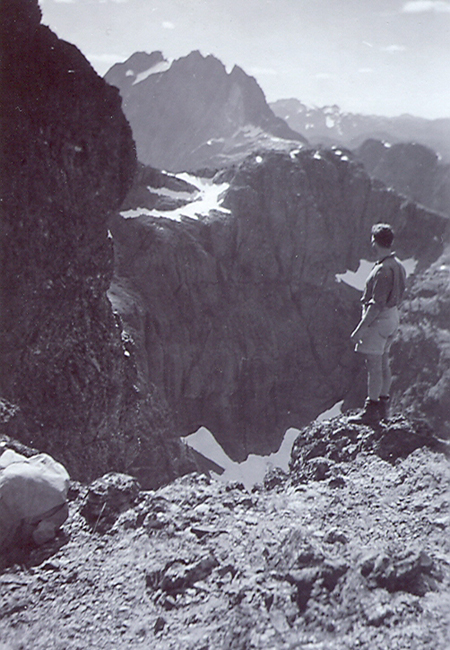
Looking at Mt. Colonel Foster from Kings Peak1949 – Charles Nash photo.
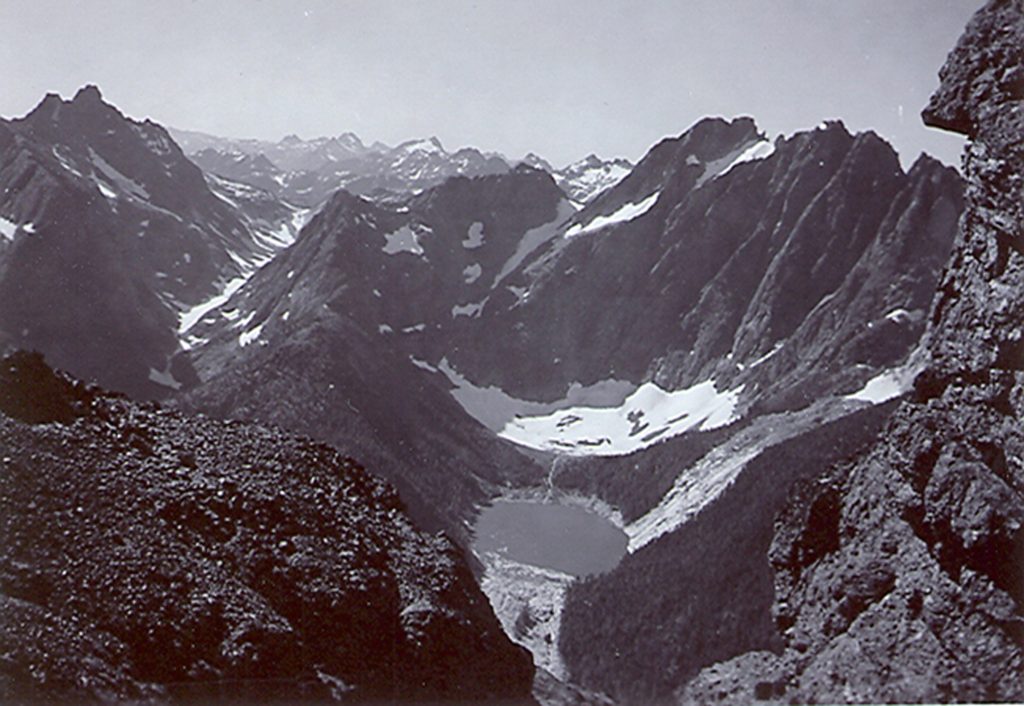
Looking across to Mt. Colonel Foster and Landslide Lake from near the summit of Elkhorn 1949 – Charles Nash photo.

Taking a break during Elkhorn climb 1949 – Charles Nash photo.

Climbing a chimney during the ascent of Elkhorn 1949 – Charles Nash photo.

Mallory Lash on Elkhorn 1949 – Charles Nash photo.
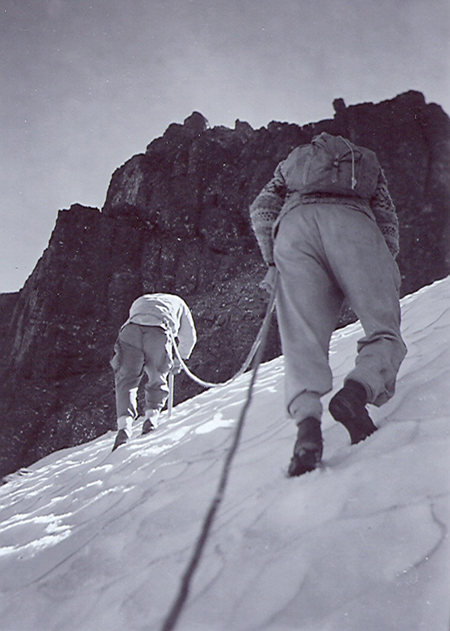
Ascending the snowfield on Elkhorn 1949 – Charles Nash photo.
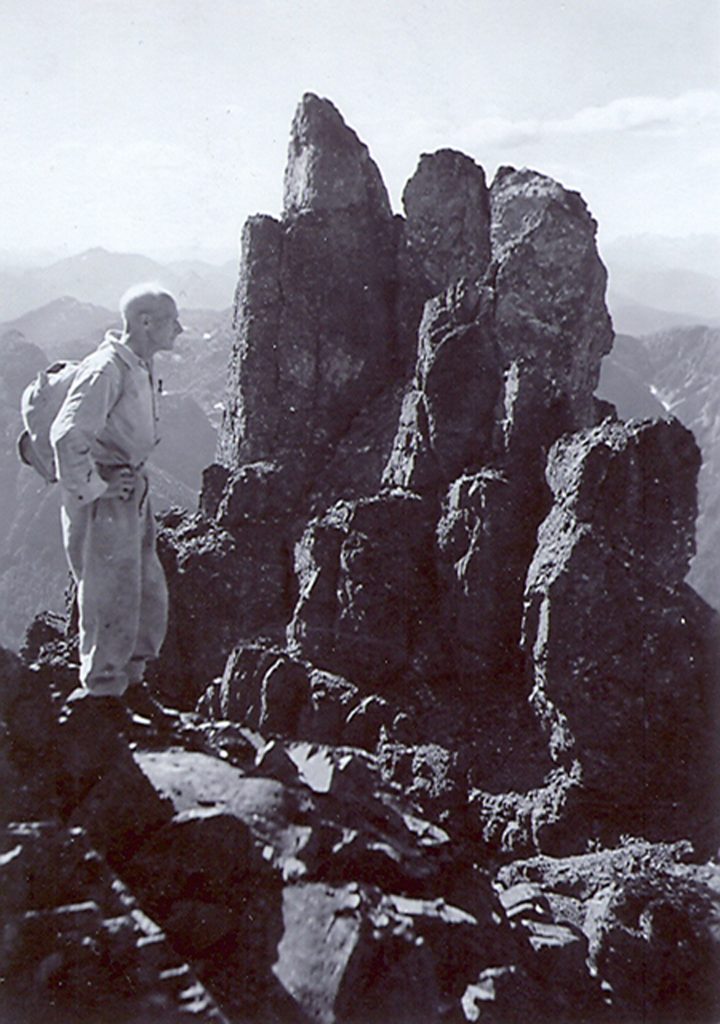
Geoffrey Capes standing near the needle on Elkhorn 1949 – Charles Nash photo.
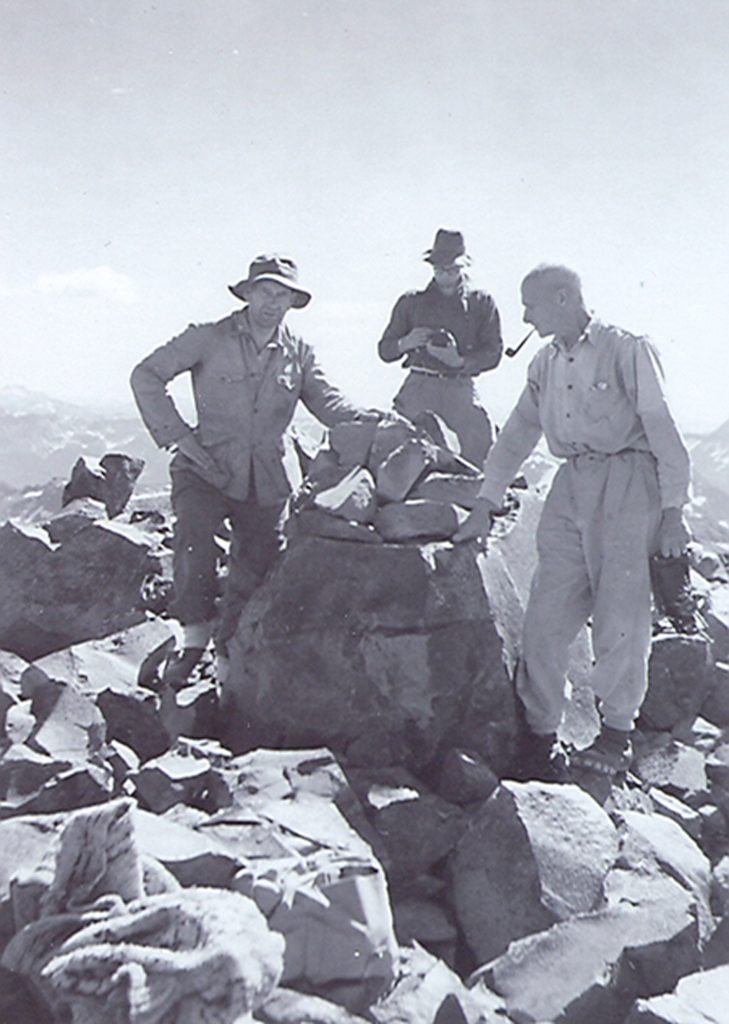
Bill Lash, Mallory Lash and Geoffrey Capes on the summit of Elkhorn 1949 – Charles Nash photo.

Bill Lash on the summit of Elkhorn looking towards Campbell River 1949 – Charles Nash photo.

Mallory Lash rappelling during Elkhorn descent 1949 – Charles Nash photo.

Taking a rest out of the sun after climbing Elkhorn 1949 – Charles Nash photo.
Elkhorn is Conquered
Reported in the Comox Argus Wednesday September 7, 1949. p.9.
Two parties had exciting mountain climbing experiences during the holiday week-end. Mr. Bill Bell and Mr. Ted Greig took a plane out of Campbell River to Buttle Lake on Friday [September 3]. Then they went up Phillips Creek and climbed the high ridge to get to the slopes of the Golden Hinde, the highest mountain on the Island. Mr. Greig browsed round the lower slopes of the mountain looking for plants whilst his companion went to the top. They both had a wonderful view being able to see both the Gulf of Georgia and the open Pacific when the sun was setting. At the 6,000-foot level Mr. Bell found what Mr. Greig believes is a douglasia, a plant new to the Island and very rare anywhere. He has sent it down for positive identification. The other party was Mr. Geoffrey capes from Courtenay, Mr. Bill Lash and his son Mallory, and Messrs. Phil Wolstenholmes, and Charles W. Nash, all of the B.C. Power Commission staff. The Elk River Timber Company gave them very valuable assistance to get to Camp 9. They made their base for the assault on the spectacular spire, the Elkhorn in Strathcona Park at Drum Lake. They made the top of the 7,200-foot peak but found it very difficult. At one point they had to lose considerable altitude because they had come to a point where it was too precipitous to go any further. It was a very memorable experience, said Mr. capes, and the hardest climb he has ever made.
Tough Trails Hide the Way into Fairyland of Della
Reported in The Victoria Daily Times Saturday October 8, 1949, p.2.
By Harry Young
A few weeks ago there appeared in this magazine a lovely picture of Della Falls. Reproduced today it shows this phenomenon of Vancouver Island with the water literally spilling out of the clouds, hitting rocky ledges, and tumbling in silvery threads into the depths of the valley below. Taken through a gap in the firs of the lower slopes of Mount Septimus, the picture successfully creates the impression of tremendous height and grandeur. The Falls of Della are indeed remarkable. From the top to the bottom the falls are over 1,500 feet. That makes, if not the highest, then the second highest in the world.
Beats Niagara
The publication of the picture brought to this office a woman visitor from Toronto. She had recently probed into the Della country and was overwhelming in her enthusiasm. “I have seen Niagara and lots of other falls,” she said, “but you can take it away from me that in sheer magnificence and rugged splendor, Della has them all licked.” She went on to express surprise that such a gem of beauty so near to a populous centre (Victoria is only 100 miles away as the crow flies) should be so little known. Of greater surprise was the fact that so little has been done to hold out the beauty spot as an attraction for tourists.
Regular Visitor
A similar view was taken by an Oak Bay resident to whom the Della country is more than a wonderland—it’s all obsession. This enthusiast, Lorne Campbell, has made three trips in the last four years into the region, and his appetite for more has merely been whetted. “Della Falls,” he says, “is unquestionably one of the greatest beauty spots in the world. It is outstanding because it is so different. But the beauty does not stop with the falls. This view from the valley is only the opening vista of a veritable fairy land.” Campbell describes how those who are agile enough to make the climb to the top of the falls are immediately transported into another world.
Fed by Glacier
The waters of the falls spill directly out of Della Lake, a mile-long sheet of gleaming blue beauty. Behind are the serrated peaks of Big Interior Mountain (6107 feet), clad in eternal snow. At the far end off the lake is a deep, narrow canyon leading into the bed of an extinct volcano crater. Campbell claims this crater to be a geologist’s dream. He has collected from its vast interior specimens or perfect quartz crystals formed thousand of years ago in the molten heat of the flaming inferno. “You could put the whole of the Oak Bay municipality into the crater, and it is so vast that I have explored only a very small part of it, Campbell says.
Crystal Clear
The crystal-clear water of Della Lake comes from a glacier which lies on another shoulder of Big Interior Mountain, and feeds not only Della, but the aptly named beauty lake, reached by climbing over a minor range of mountains. The strange thing is that while Della Lake is gin-clear, the circular Beauty Lake is milky blue in color. This is due, no doubt, to the nature of the volcanic ash under that part of the glacier which supplies the Beauty water. “Beauty lake is the loveliest thing I have seen. Surrounded by stunted trees, and with the glacier ending almost at the lakeside, it is a sight never to be forgotten,” extols Campbell. Della and Beauty are each about 3,500 feet above sea-level and both tumble their surplus water into the Drinkwater Creek valley below. The Beauty Falls, however, are so heavily wooded that they are not distinctly apparent in the way that Della Falls are.
Icebound Lakes
Owing to their height, Della and Beauty are ice-bound for most of the year. They are free of ice, according to Campbell, for little more than a month—August and early September. And it is the month of August when the surrounding mountains lose much of their snow that there is a short but wonderful display of alpine flowers. Whole mountainsides gleam with blue phloxes, right to the edge of the snow lines. Some of Campbell’s collection of photographs of the area appear on this page, but he claims that his black and white work does scant justice to the magnificence of the scenery. He wants to see the area opened up for tourists, and he suggests that an expedition should be arranged to take color pictures and to explore the possibilities of development. “Properly handled this part of the island could be the finest tourist proposition on the continent,” he says.
Interest Aroused
Provincial Tourist Department officials readily admit that so far they have had little opportunity of exploring the possibilities. But, fortunately, they are interested. So too, is Dr. Clifford Carl, the Chief of the B.C. Museum. He would like to know more about the flora and fauna of the district. The possibility is that an expedition may be arranged for next summer when the ice melts on Della Lake, and the alpine flowers reach the peak of their perfection. The best way in, according to Campbell, would be by sea plane landing on Della Lake. “If supplies have to be taken by the existing trails there are heavy difficulties,” says Campbell. “The climb up the Della Falls trail is in parts almost perpendicular. Supplies on any large scale would have to be dropped by plane.”
Seaplane Approach
The Westinghouse Airways, who at present run a taxi service from Alberni to the nearby Buttle Lake, express the view that it might be possible to make a descent on Della Lake. If they can do so, the project becomes comparatively simple. However, before te wonders that are claimed for the Della area can be made a tourist proposition, the approach must be opened up. It isn’t every tourist who is an experienced woodsman or mountaineer? And most of them don’t want to be. Della Falls lie some 45 miles (as the crow flies) W.N.W. of Alberni, and on the southern fringe of the triangular Strathcona Provincial Park.
Auto Road Ends
The journey starts simply enough by motor road to the foot of Great Central Lake. Here the tourist and his beloved auto have to part company, or go no further. The tourist seeks out a Mr. Paddy Burke, whose motor launch will by arrangement, provide transportation to the head of the 26-mile-long Great Central Lake. At the point where Paddy Burke says goodbye, there is a reasonable road once used by Can Gold Company, whose shares may now be purchased at the nominal figure of one penny. The old Can Gold workings are some six miles up the 13-mile-long trail to the foot of Della falls. The road degenerates into a rough trail, once the workings have been passed, and the tourist is now in the unsullied glory of Strathcona park territory.
Lair of Big Trout
Through breaks in the trees the tourist is encouraged on his way by noble vistas of the Della Falls. The Drinkwater Creek gurgles below. It is named after the pioneer of the district, who spent much of his life prospecting gold, and named the Della Lake and Falls after his wife. Campbell can point out pools in the Drinkwater Creek where a dangling worm or dainty fly will find an eager taker. The rod will bend, the pirn will scream, and there will be lots of fun and adventure over ragged rocks before a monster trout is either lost or, by some lucky chance brough safely to the net. But this is not a fishing trip. It’s an exploratory mission and the trout is merely to implement the larder.
Heavy Growth
The Della Falls are now towering massively, and it is time to make the crossing of the Drinkwater Creek. A fallen log makes a providential bridge, and the tourist creeps over into a trail that leads three-quarters of a mile into the foot of the falls. This trail may or may not be clear. It lies within the spray area of the falls, and the misty irrigation causes the growth to be fantastic. A trail cut one month may be overgrown the next.
Sheer Climb
However, it is once the falls have been reached that the real difficulties commence. An old wire cable once used by a mining company hangs invitingly, but it is rusty and out of use. The only way aloft is by the almost perpendicular trail that rises 1,500 feet over rock and scrub and offers insecure foothold. “But once you get up,” says Campbell, “it’s worth the effort a hundred times over.” The impression to be gleaned from this recital is that it would take a tremendous amount of capital outlay to open the road for the tourists.
Not So Difficult
Campbell, however, claims that this is not the case. It would be possible to run a motor road from the foot of Great Central Lake to the foot of Della Falls by linking up the already existing logging and mining roads. He also claims that the trail up the falls themselves to the hinterland beyond could be stepped and made reasonably easy of access by foot to make it a sufficiently attractive proposition to the more agile tourist. “Once that is accomplished,” says Campbell, “Vancouver Island has a tourist attraction that knocks the Grand Coulee Dam into a cocked hat.” Maybe Campbell’s enthusiasm will stir the readers as much as it has done the writer of this article.
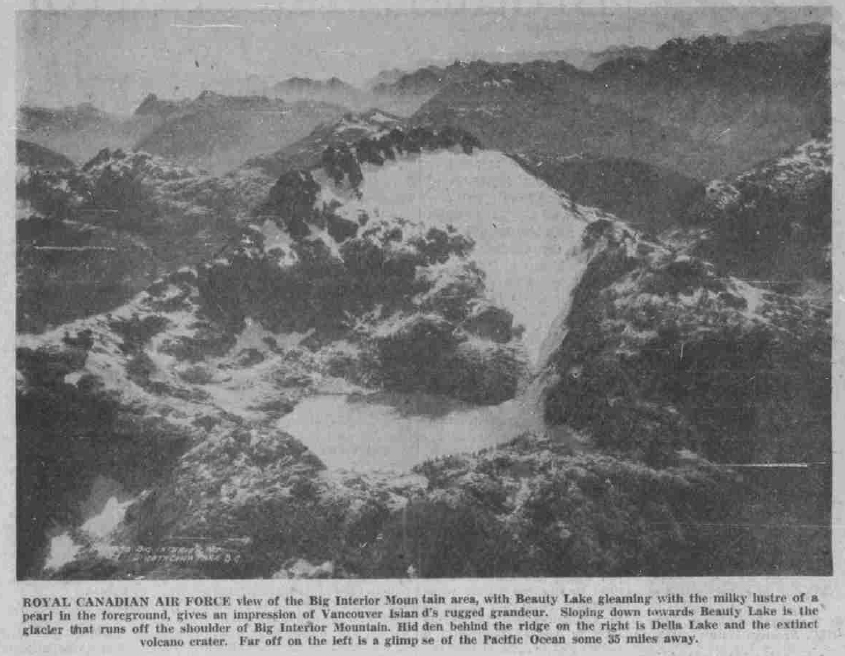
ROYAL CANADIAN AIR FORCE view of the Big Interior Mountain area, with Beauty Take gleaming with the milky lustre of a pearl in the foreground, gives an impression of Vancouver Island’s rugged grandeur. Sloping down towards Beauty Lake is the glacier that runs off the shoulder of Big Interior Mountain. Hidden behind the ridge on the right is Della Lake and the extinct volcano crater. Far off on the left is a glimpse of the Pacific Ocean some 35 miles away.
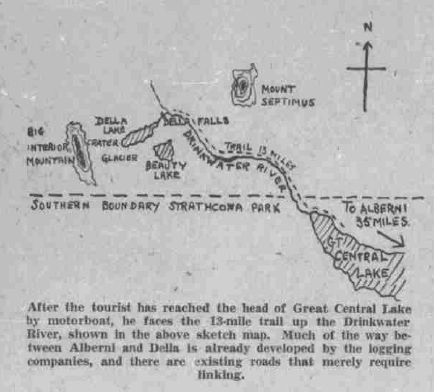
After the tourist has reached the head of Great Central Lake by motorboat, he faces the 13-mile trail up the Drinkwater River, shown in the above sketch map. Much of the way between Alberni and Della is already developed by the logging companies, and there are existing roads that merely require linking.
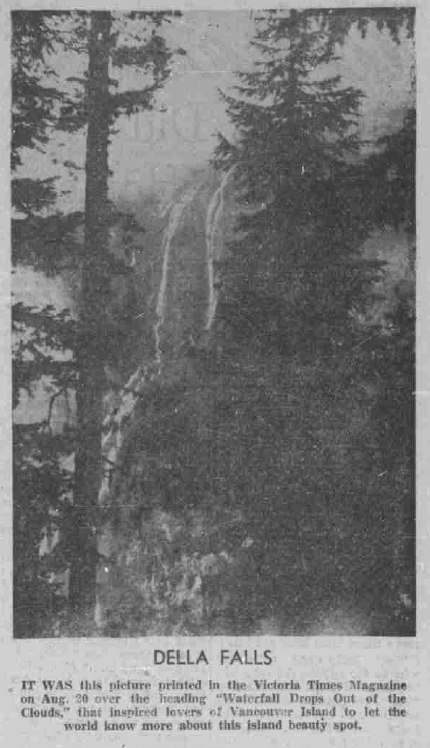
DELLA FALLS IT WAS this picture printed In the Victoria Times Magazine on Aug. 20 over the heading “Waterfall Drops Out of the Clouds,” that inspired lovers of Vancouver Island to let the world know more about this island beauty spot.

IN THE DEPTHS of the volcano crater is a small lake, and In this picture taken by Campbell Is his companion, Fred Johnson of Victoria. The walls of the crater in the month of August are covered with brightly colored Alpine flowers. In area the crater is bigger than the municipality of Oak Bay.
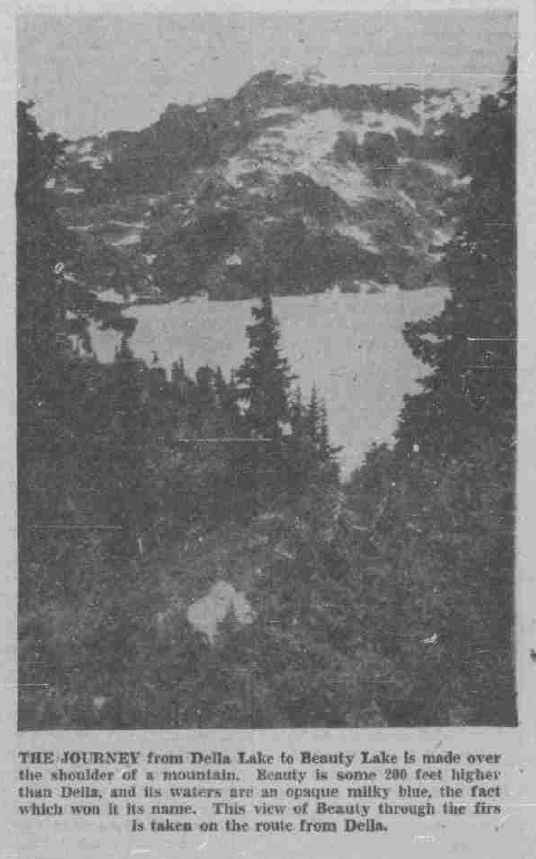
THE JOURNEY from Della Lake to Beauty Lake Is made over the shoulder of a mountain. Beauty is some 200 feet higher than Della, and its waters are an opaque milky blue, the fact which won it its name. This view of Beauty through the firs is taken on the route from Della.
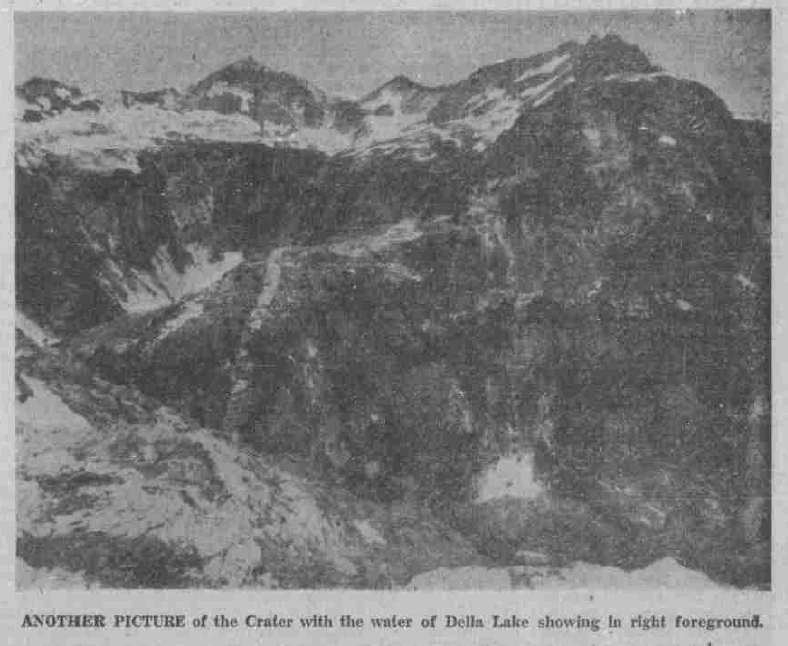
ANOTHER PICTURE of the Crater with the water of Della Lake showing In right foreground.

THIS VIEW of Della Lake by Campbell Is taken from the Western and looking towards Mount Septimus at the other side of the Drinkwater River. The Della Falls spill over the edge of the cliff where the lake narrows at its eastern end.
Ski Club Getting Ready
Reported in the Comox Argus Wednesday October 12, 1949. p.1.
All ten members of the executive of the Comox Ski Club were guests of Mr. and Mrs. Chambers at the Forbidden Plateau Lodge on Friday [October 7] night. After an excellent dinner they discussed mutual problems. One of these is how to keep the road to the lodge open all the season through. Last year it was closed for two or three weeks. Another was how to attract more outsiders to the Mt. Becher field. The club expects to have a hundred members at least this year. Members are up every week working at both cabins and getting in wood. They are now whitewashing Becher Cabin and they have put a new floor in the Look-out Cabin. Just where the ski tow will be this year depends on snow conditions.
Jane Dorothea Hay
1897 – 1949
Reported in The Canadian Alpine Journal Volume 33, 1950, p.136-137.
By C. Muriel Aylard
With tragic suddenness death came to Miss Jane Dorothea Hay, Victoria, B.C., the evening of November 2, 1949. She had gone with friends to the opening of the Hope-Princeton highway and near Hope on the return journey, the car left the highway and rolled into a ravine. Dorothea, and two others passengers in the rear seat, were instantly killed. The community was shocked. A great number paid tribute to her memory at her funeral at the First united Church in Victoria. One brother, Dr. Cecil Hay, Port Angeles, Washington, U.S.A., survives her. On November 22, 1897, Dorothea was born in Victoria. With honours in Biology, she graduated from McGill in 1924. The next year she joined the staff of Victoria High School. After teaching a short time, she became full time Librarian and remained in that position until July 1948. From a small beginning she built the library into the most important unit of the school. Being interested in children, not only did she teach the students how to us a library, but she guided them to an appreciation of good literature. Dorothea, in 1931, joined the Alpine Club of Canada. Her love of the mountains brought her back to them many summers. Her kindness and thoughtfulness of the old as well as the young will not be forgotten. We miss her but we know how happy and interested she was in starting out on what was her last trip.
1950
The next five years: 1950 – 1954.

The History of ACCVI is a work in progress.